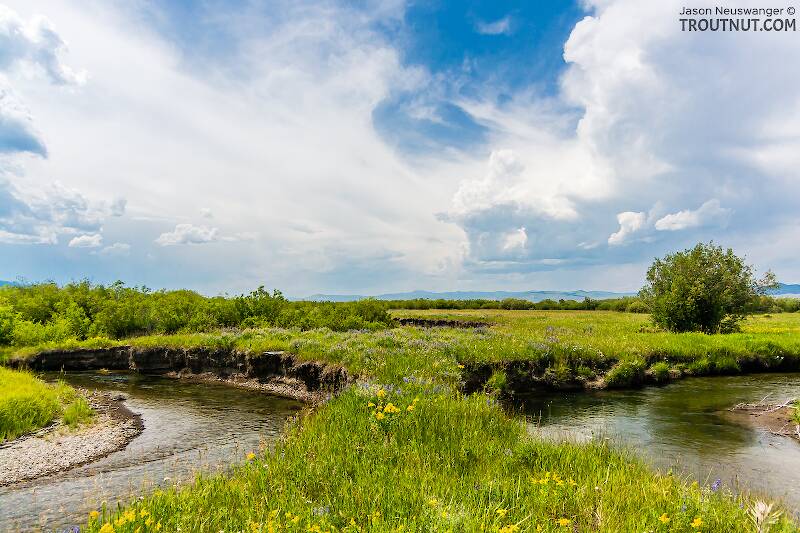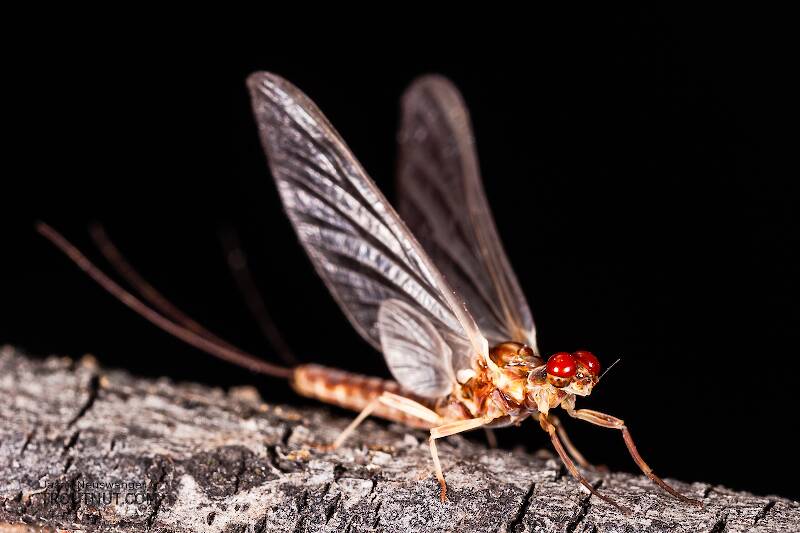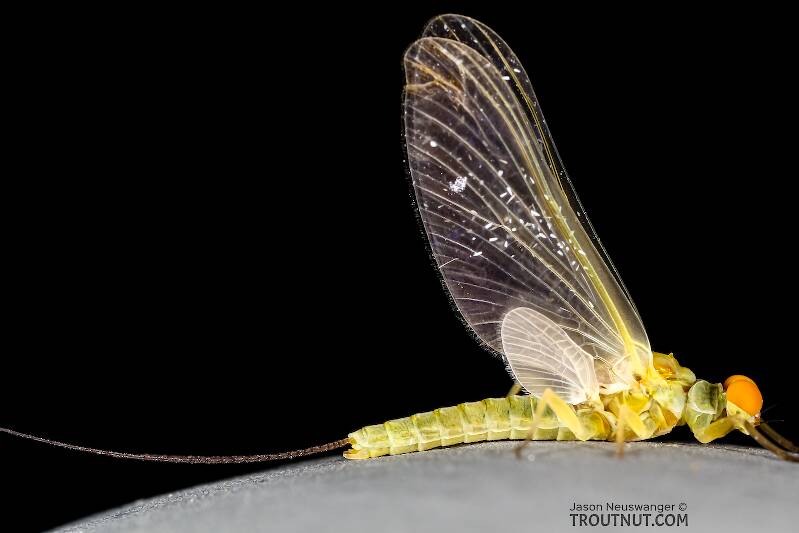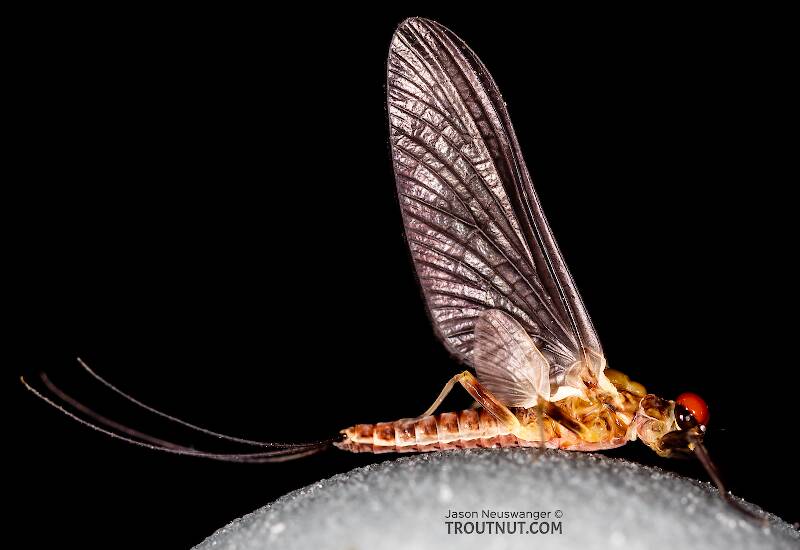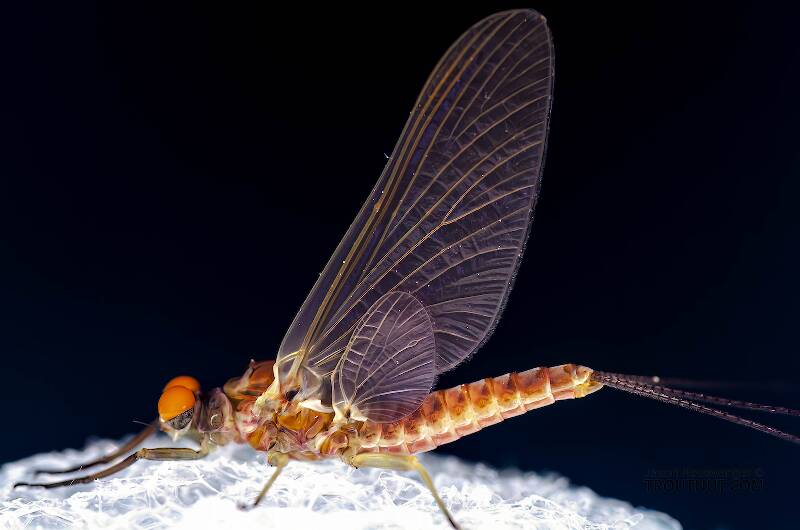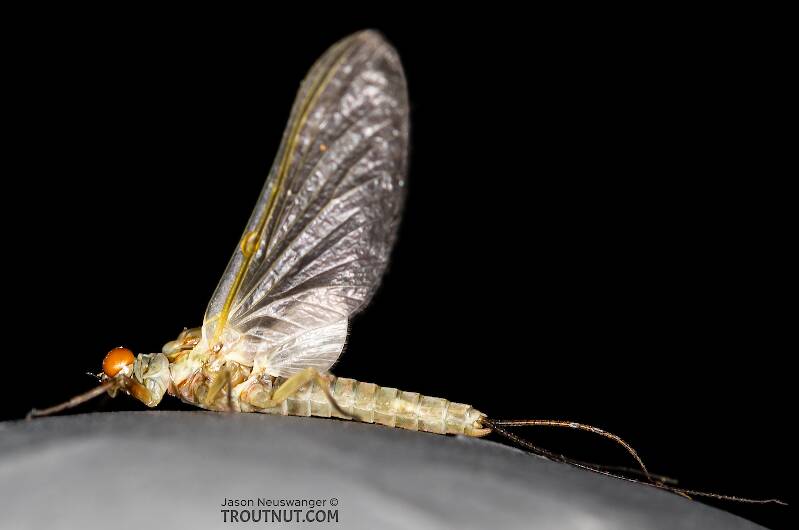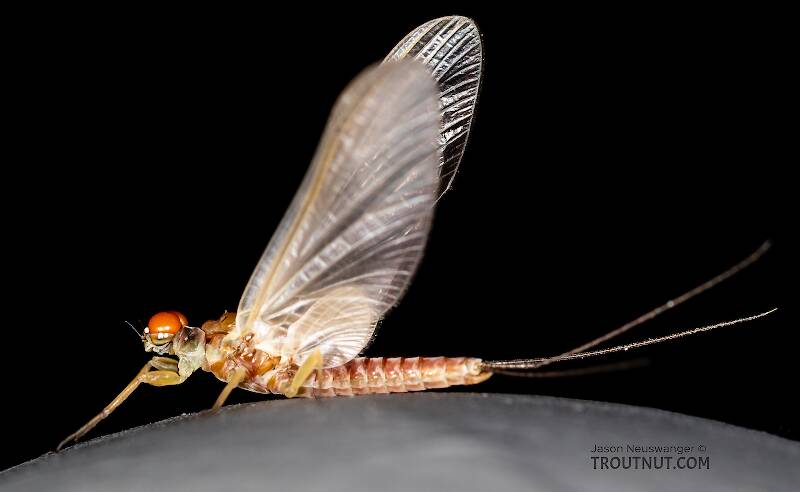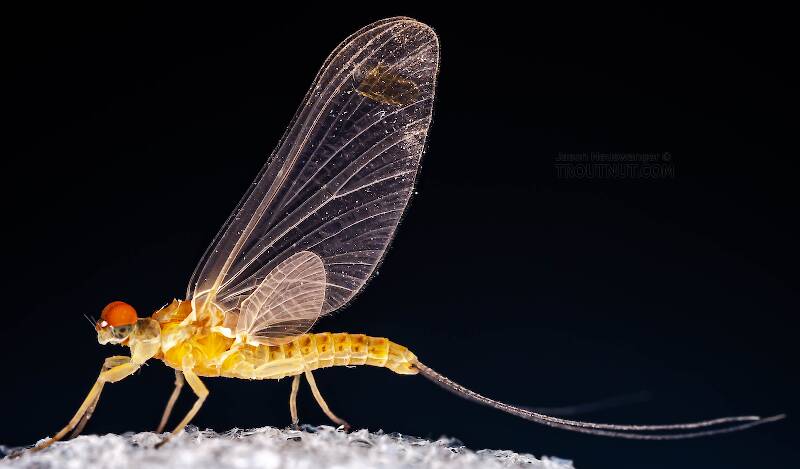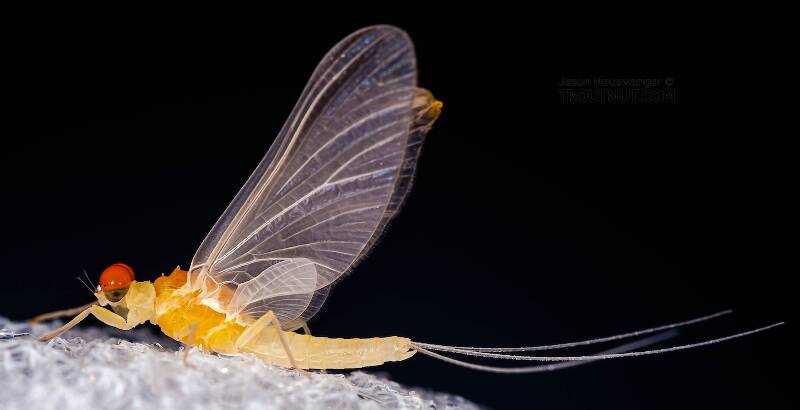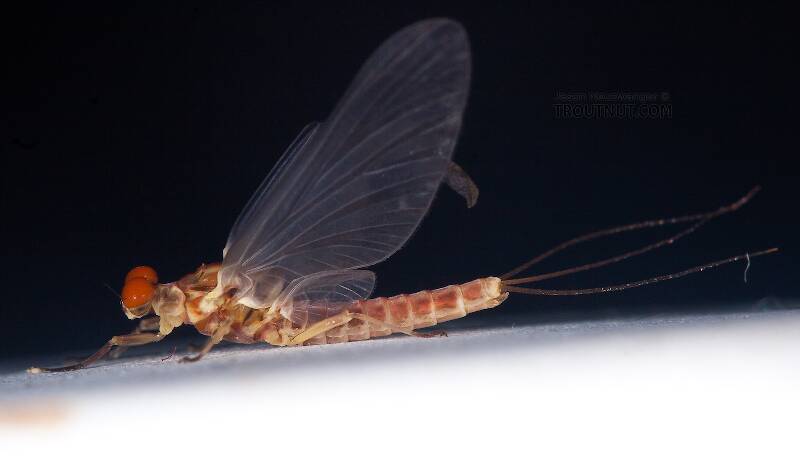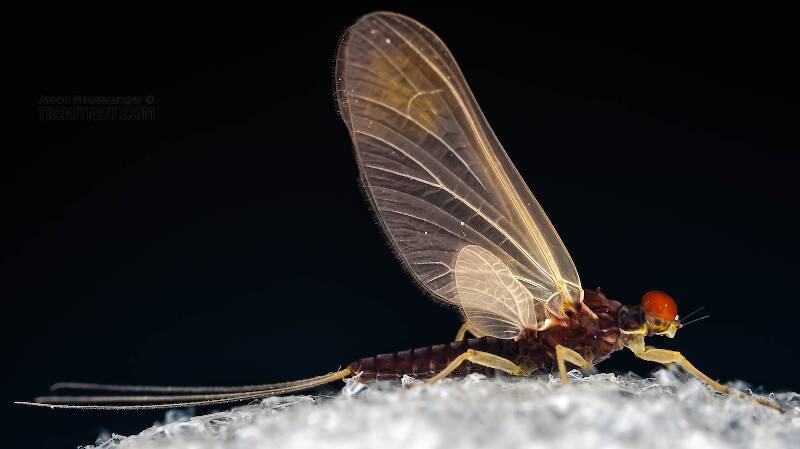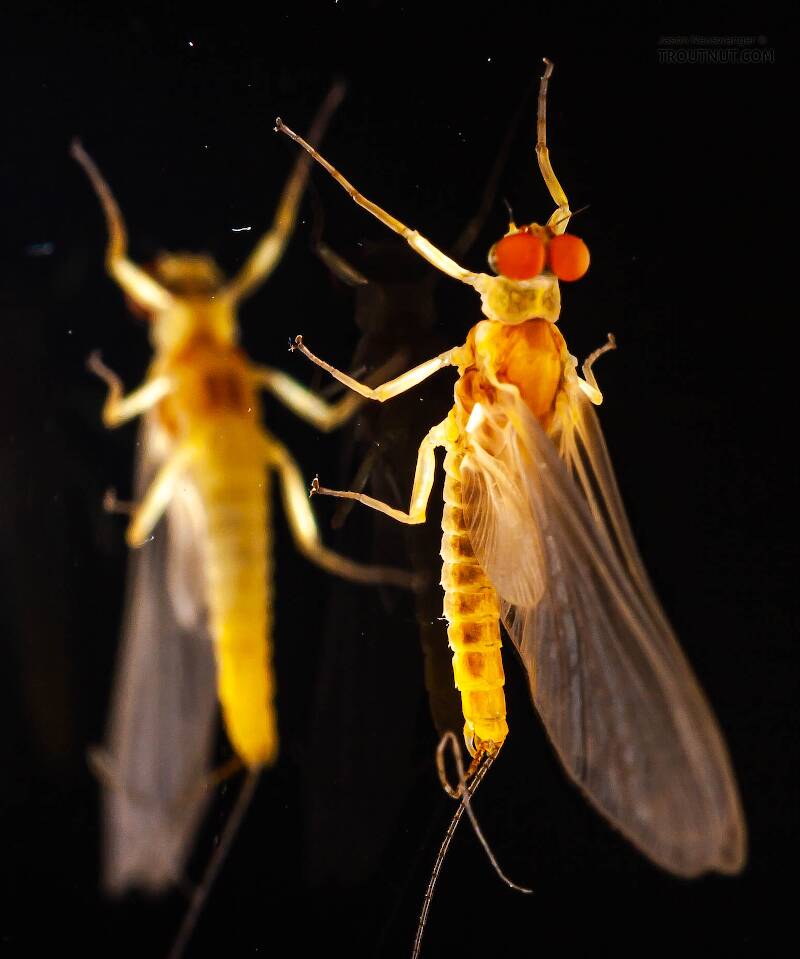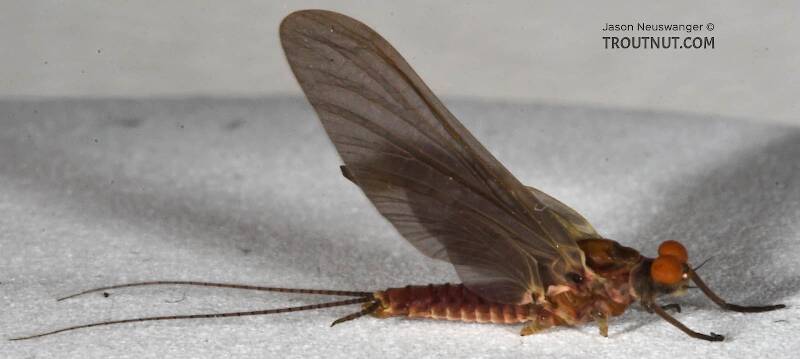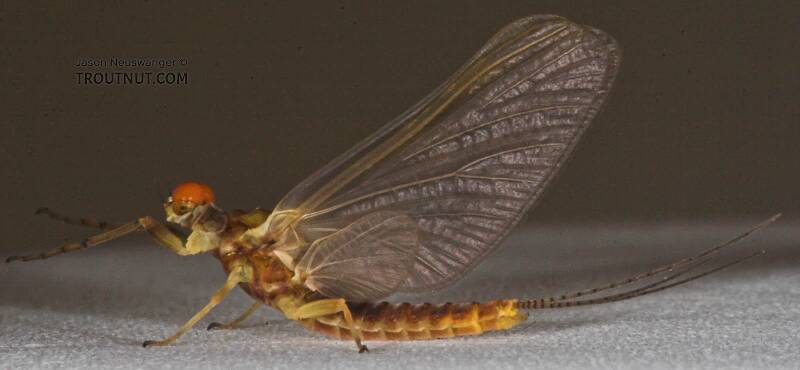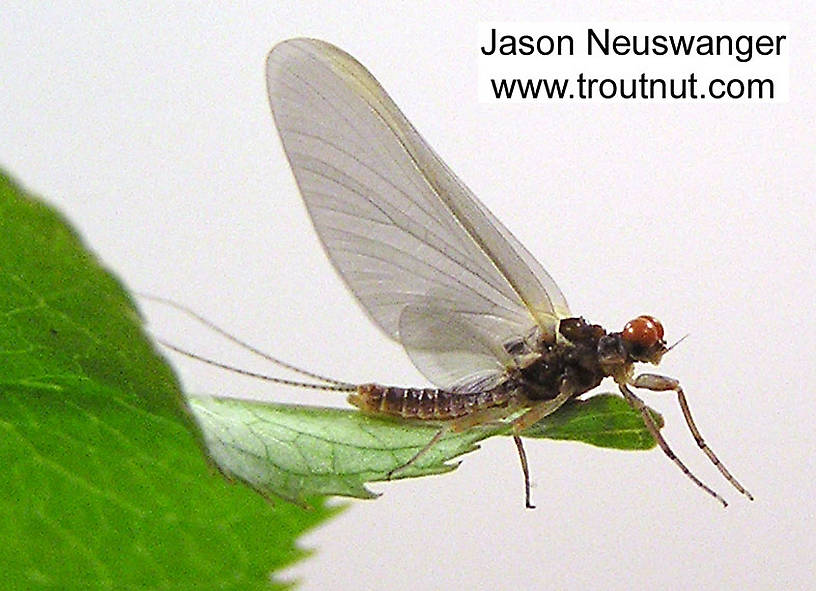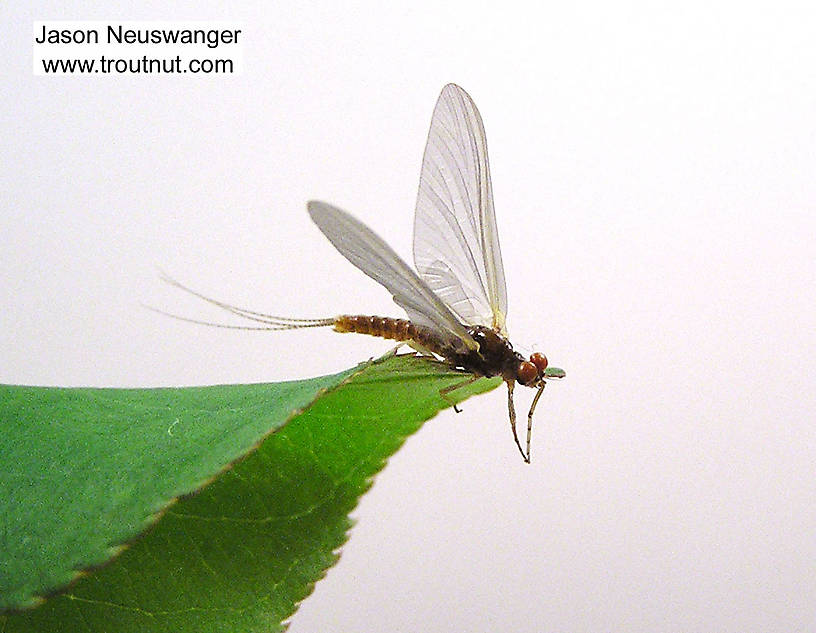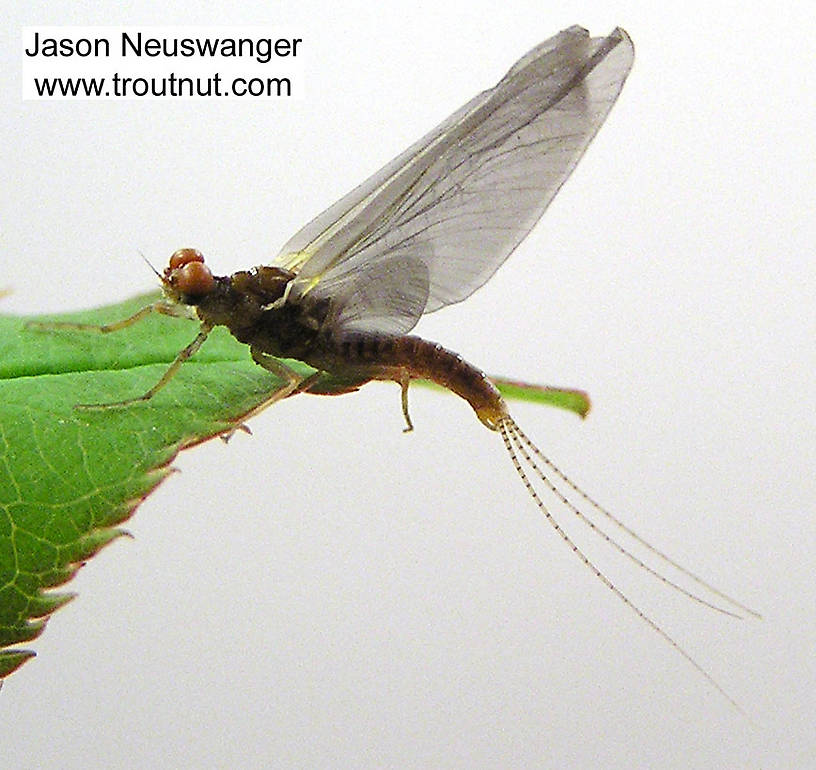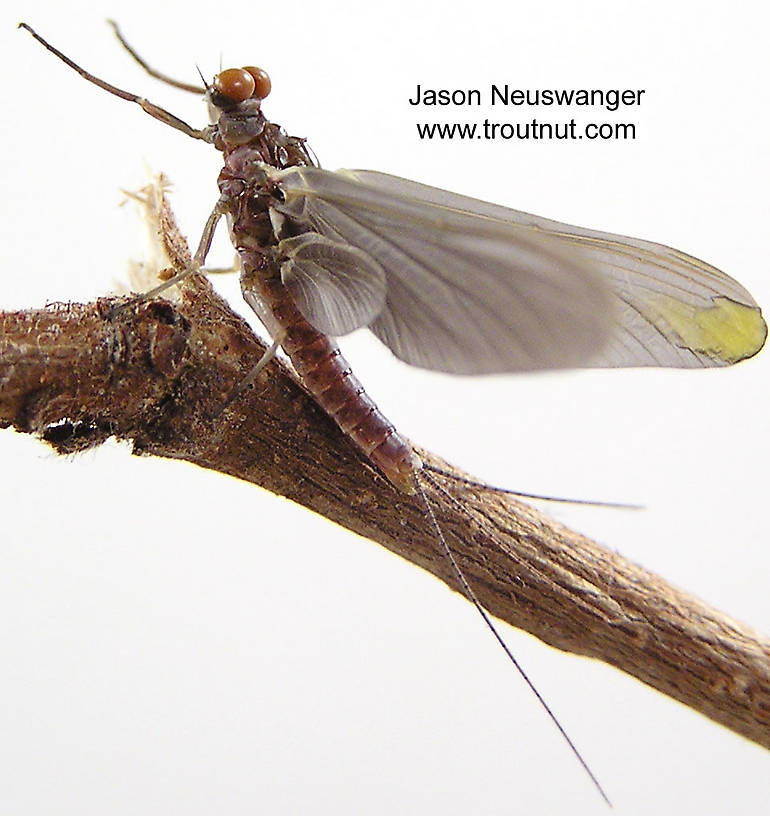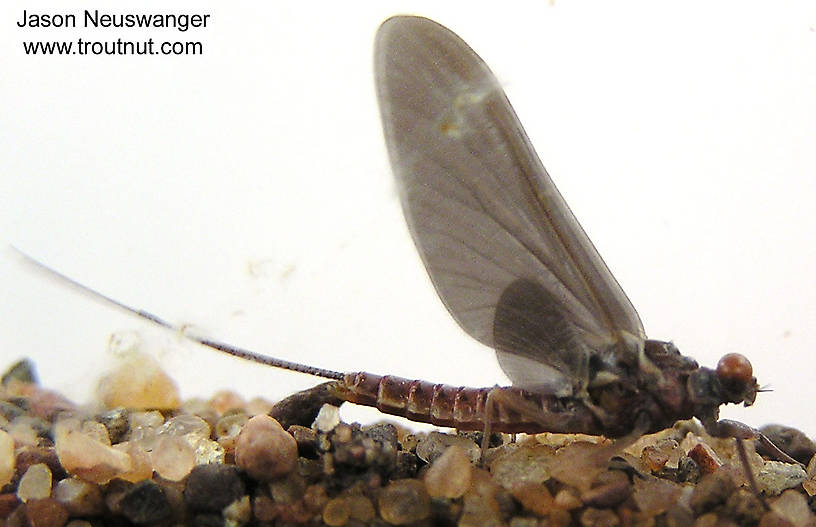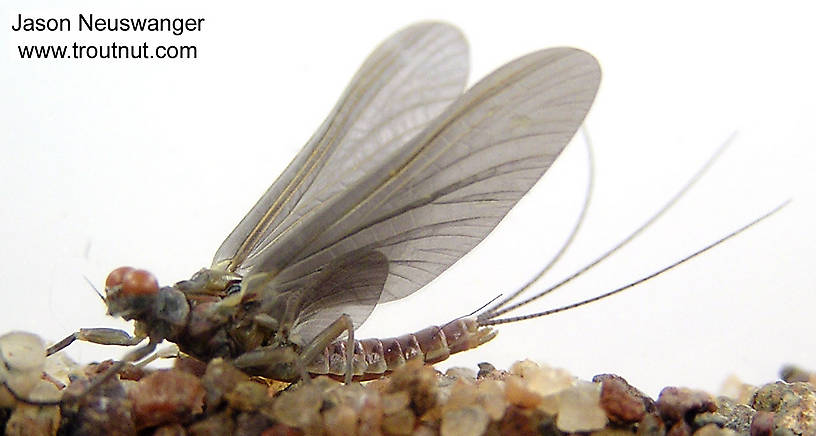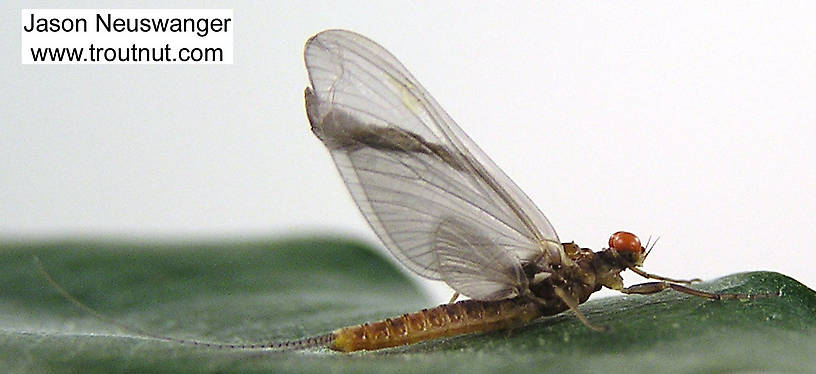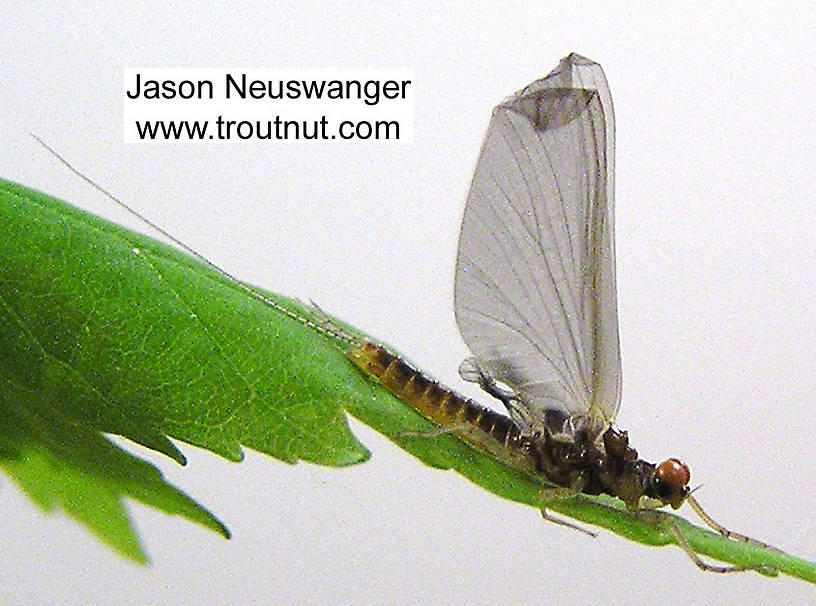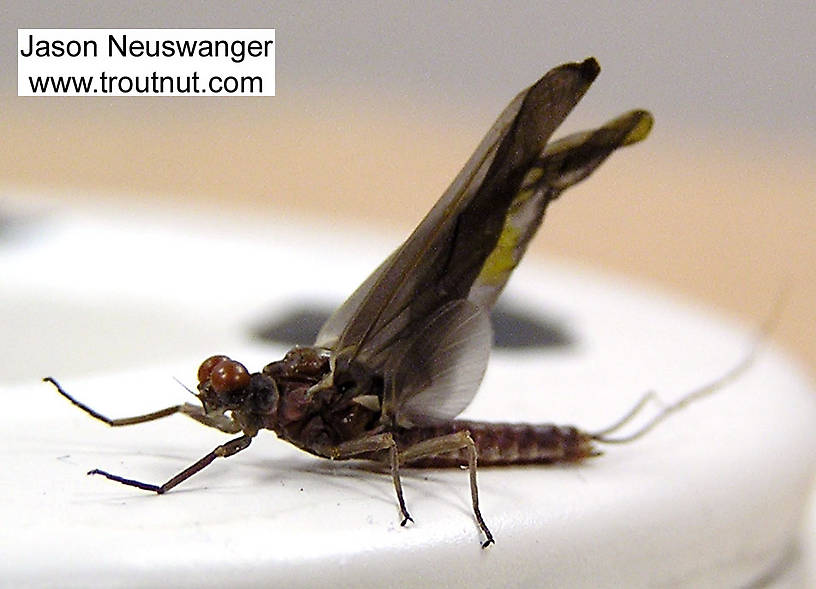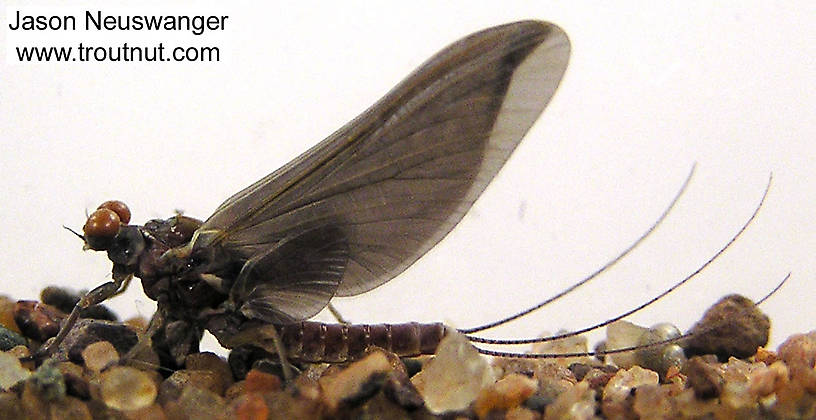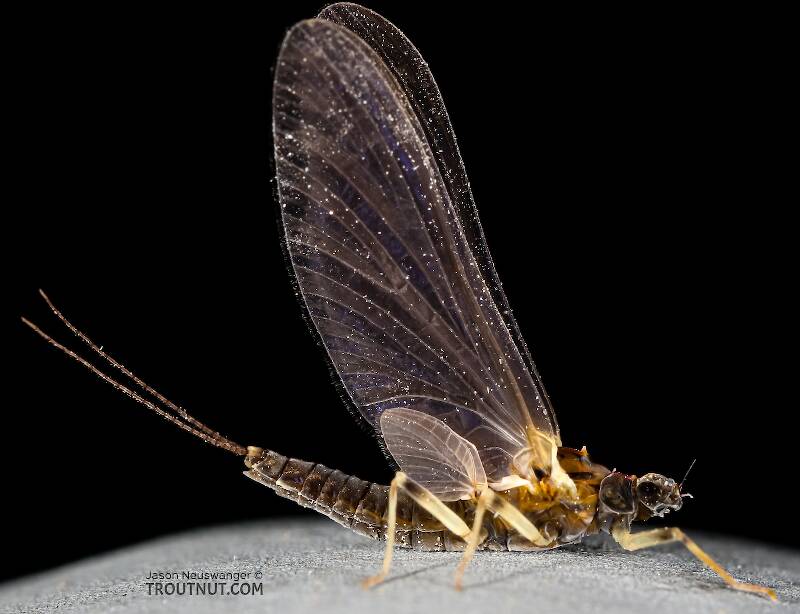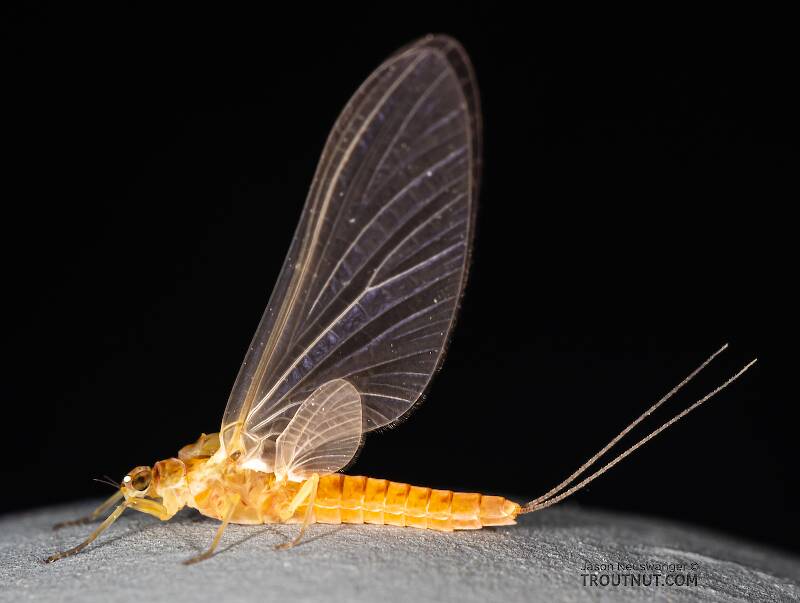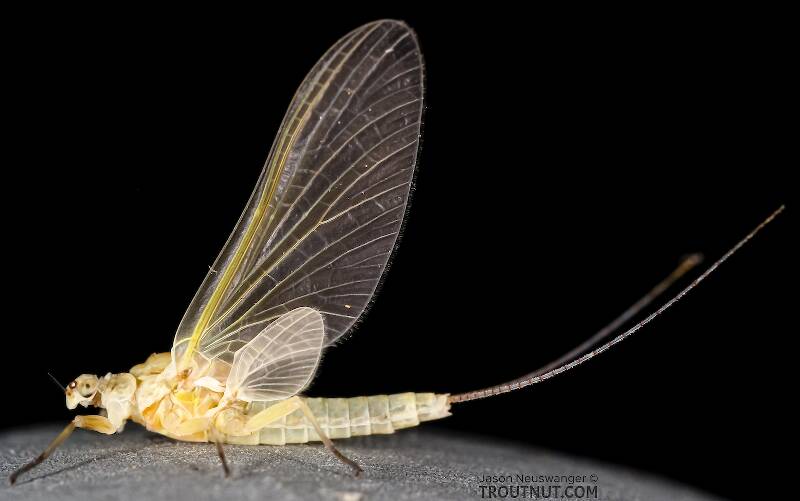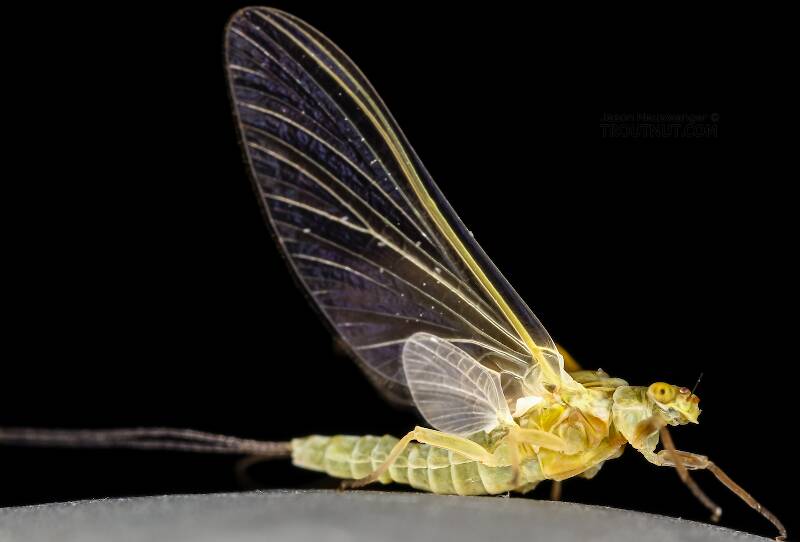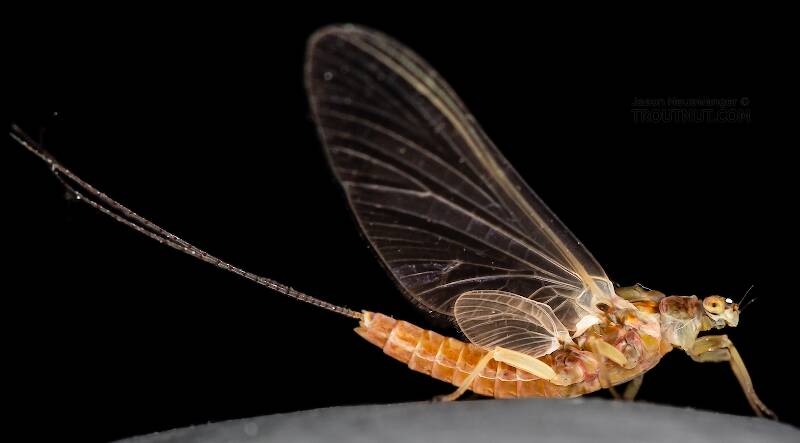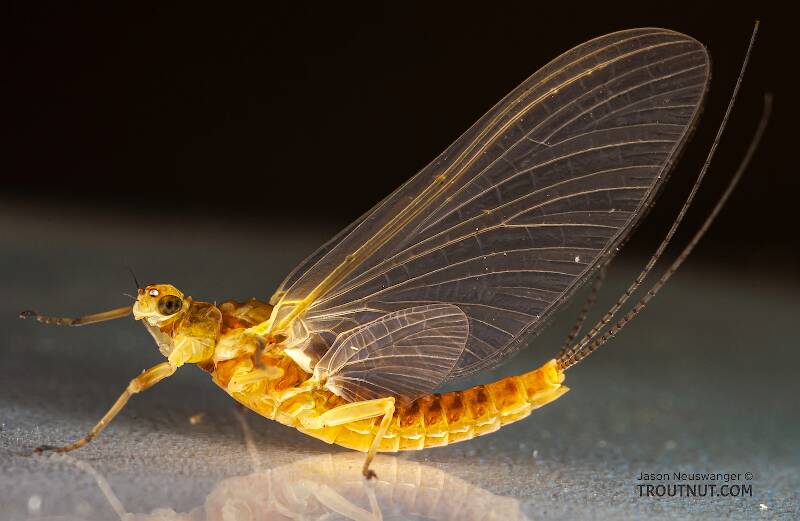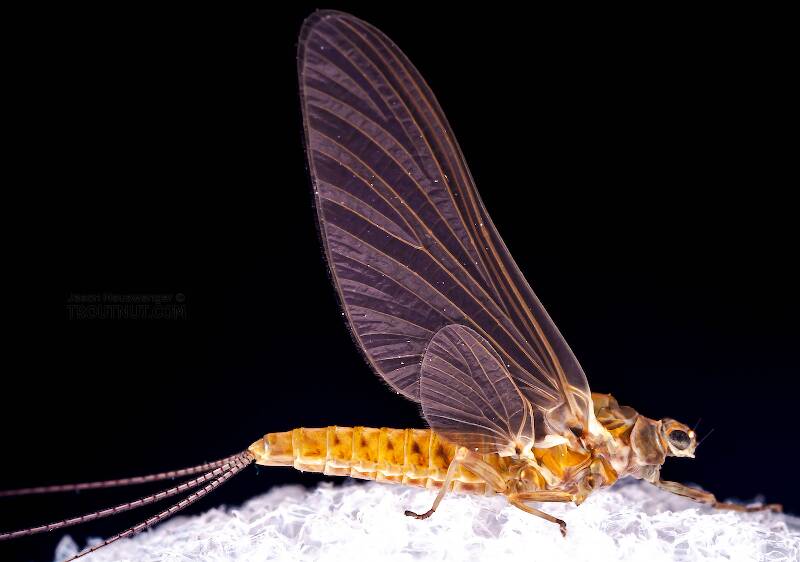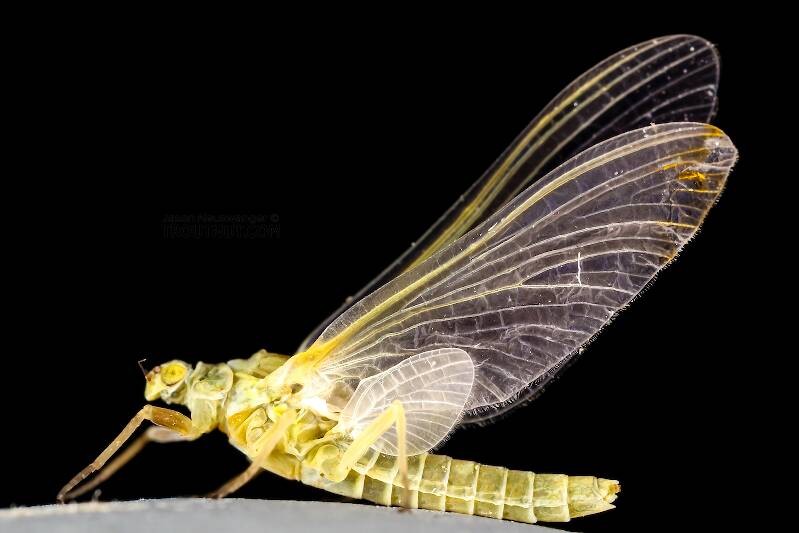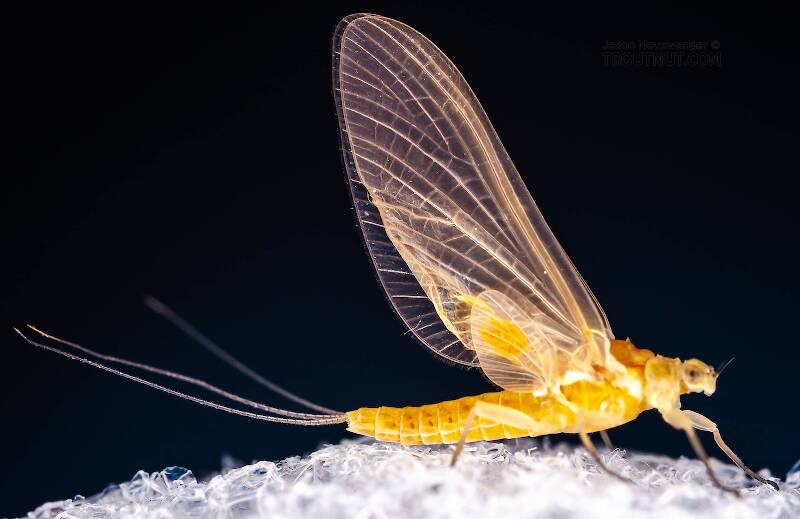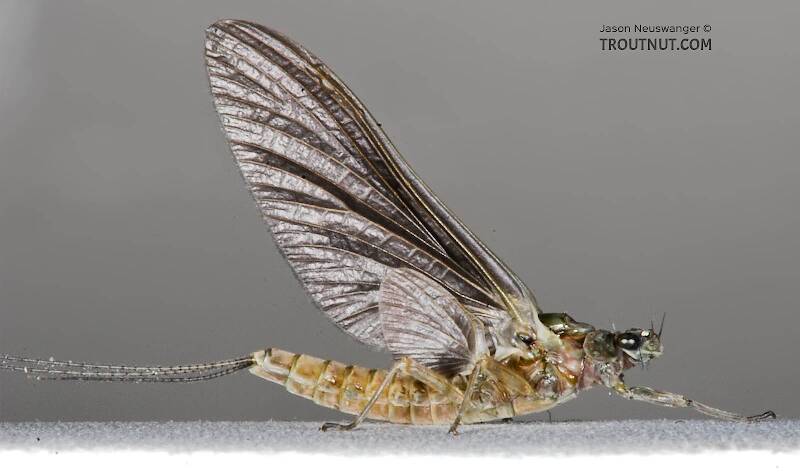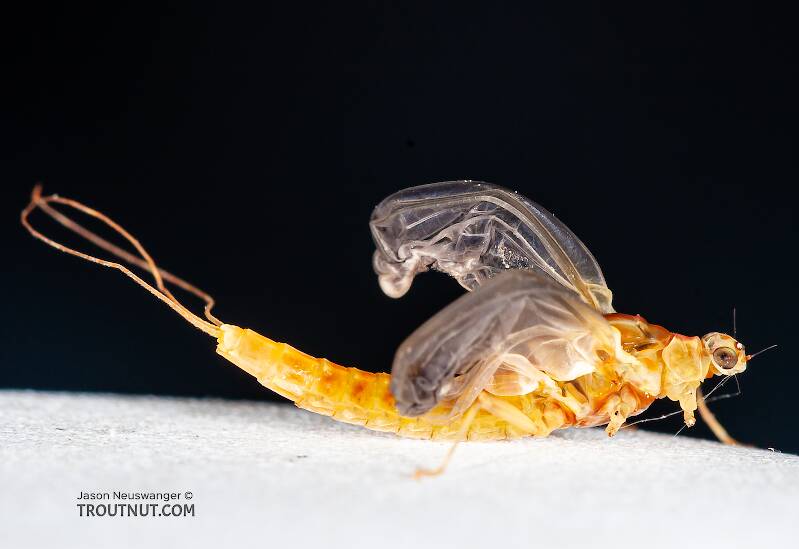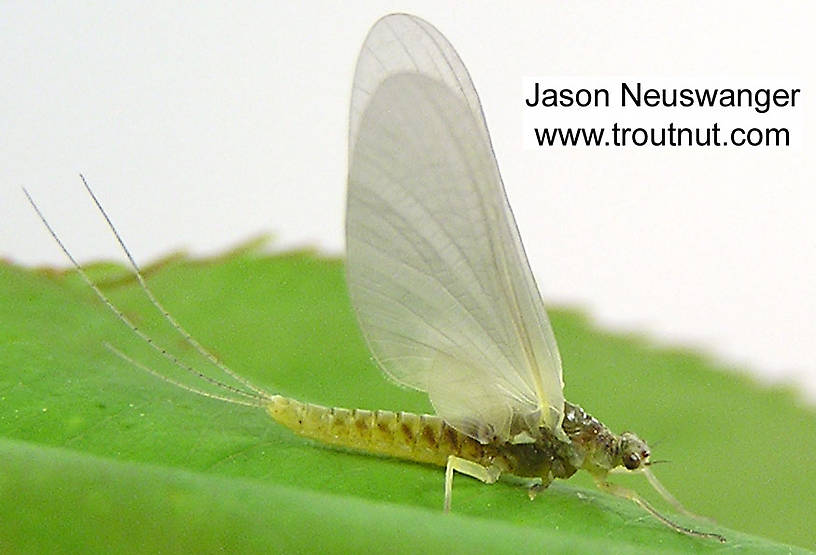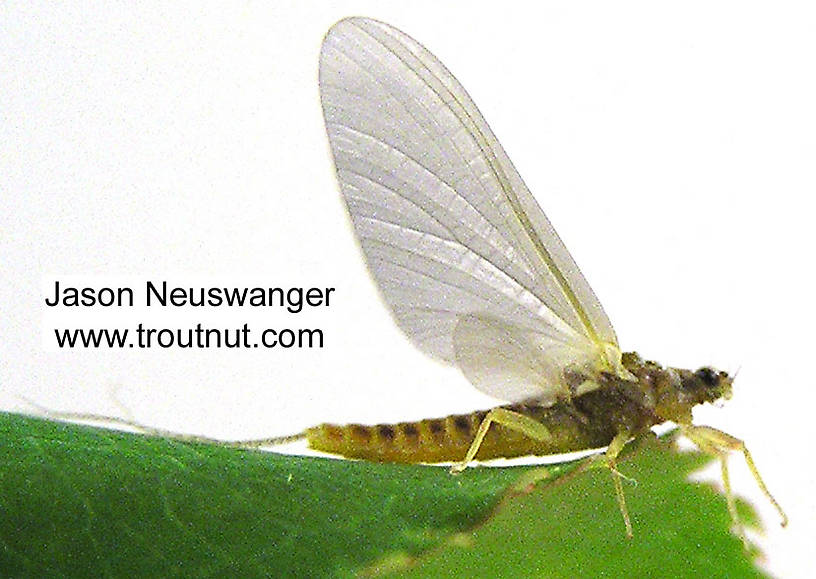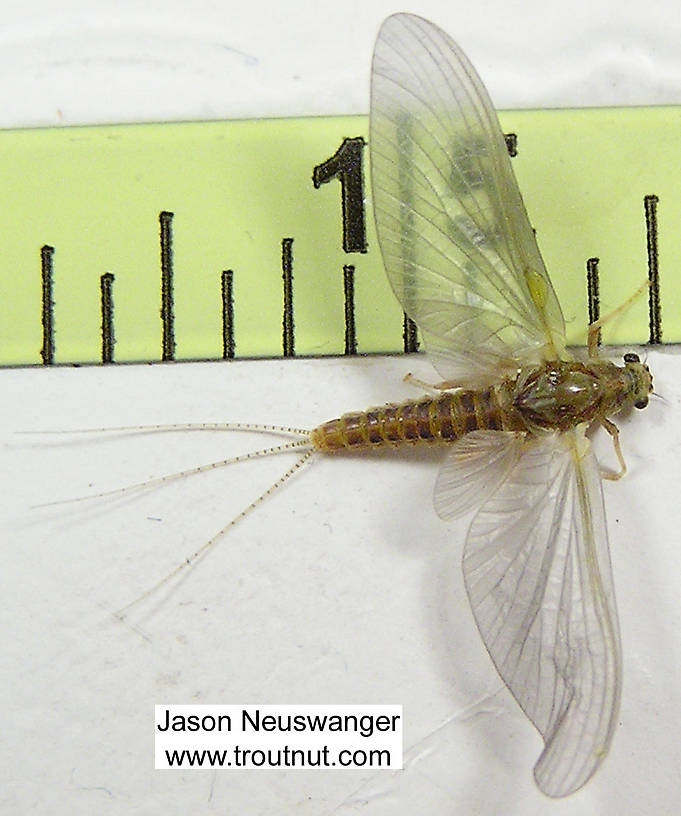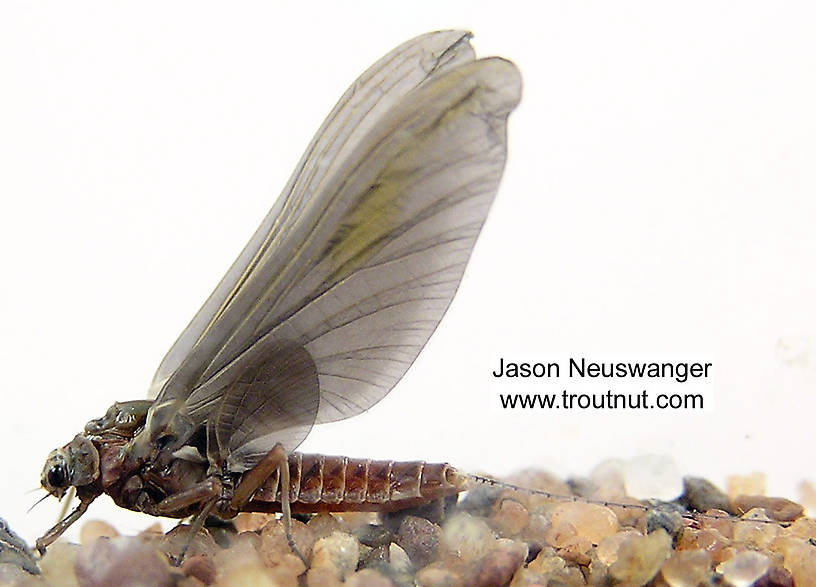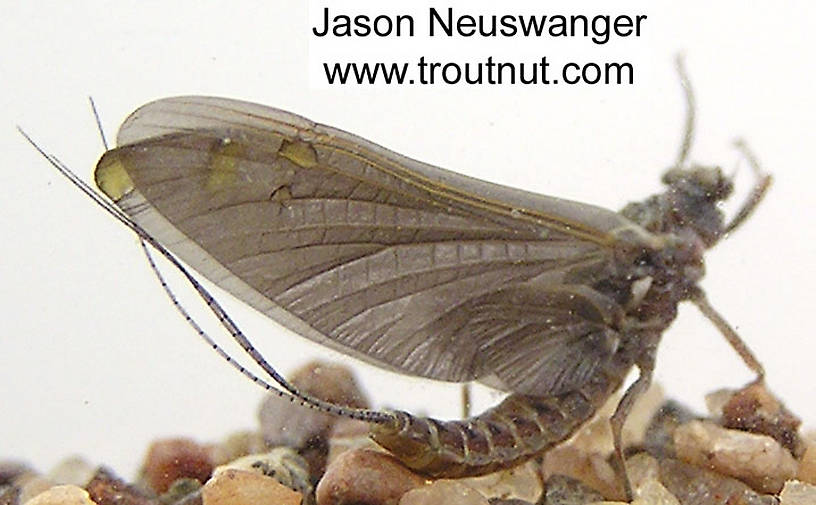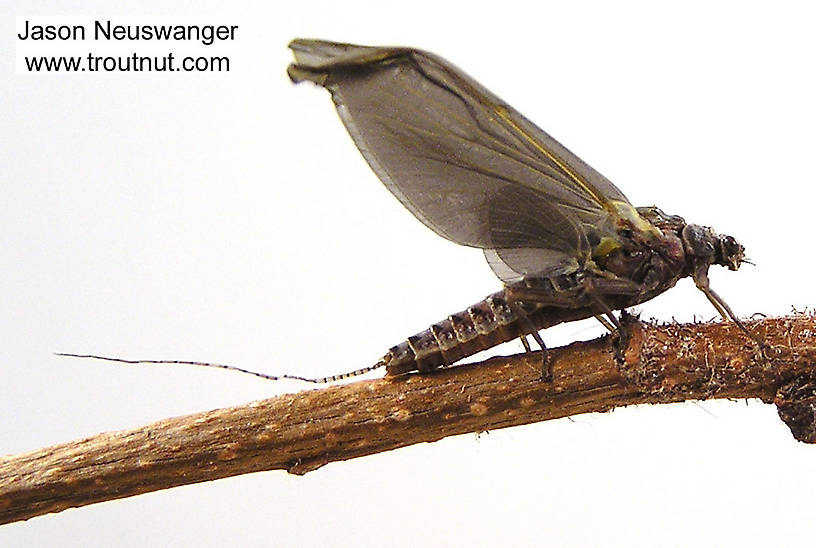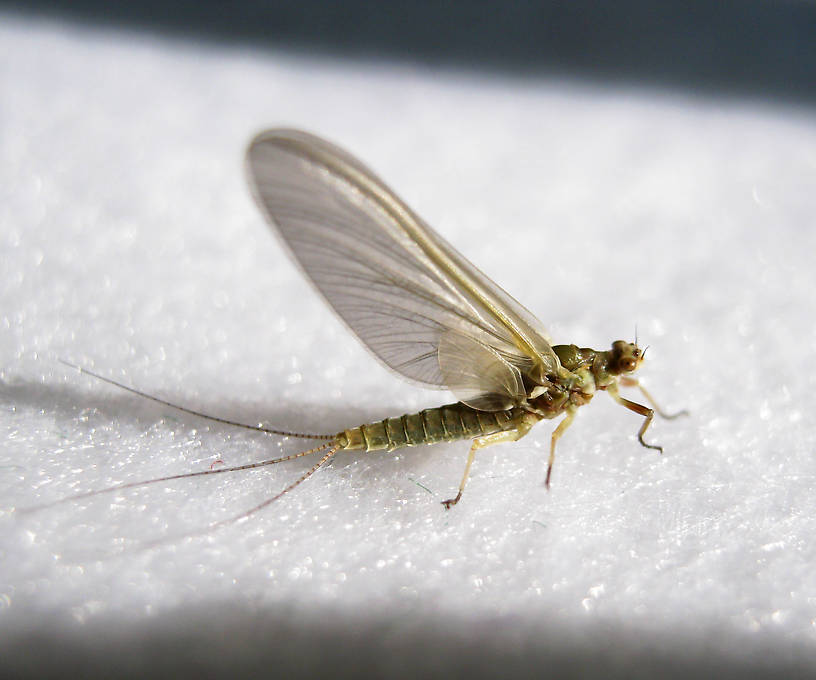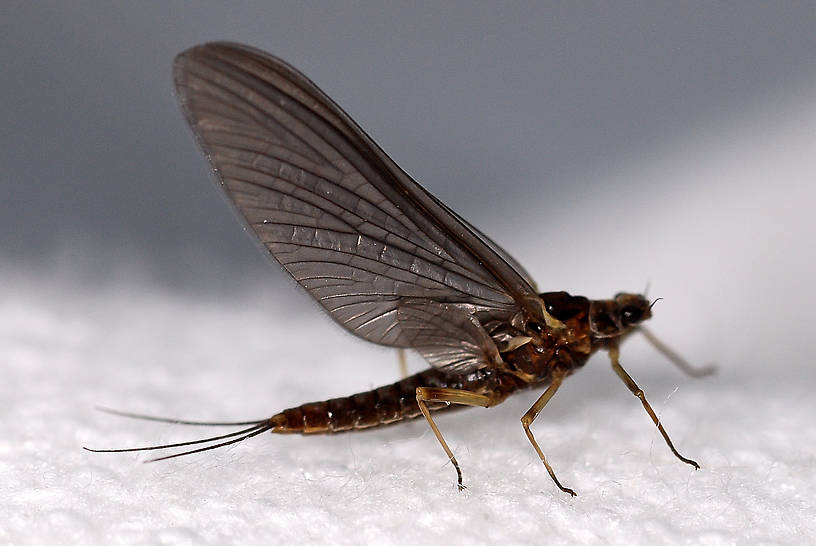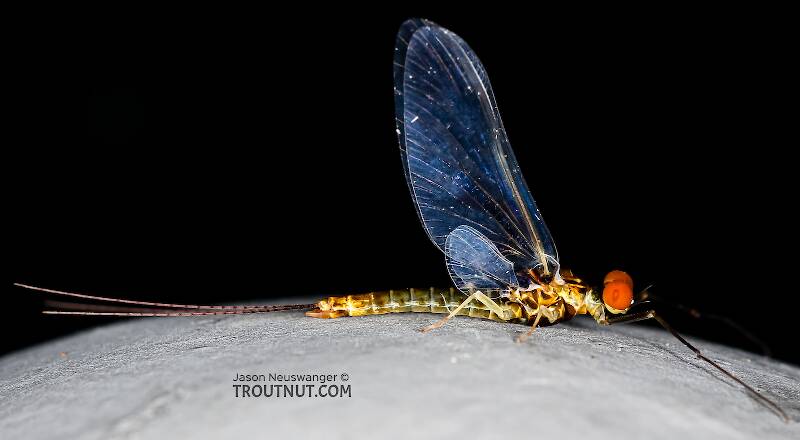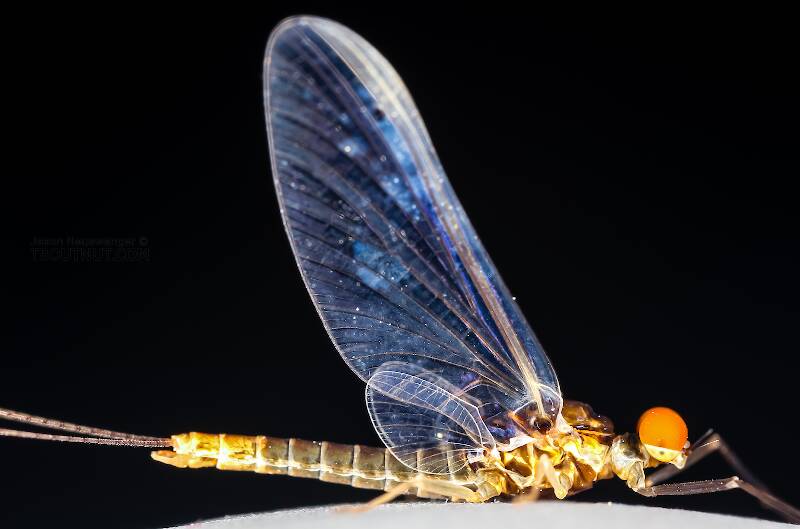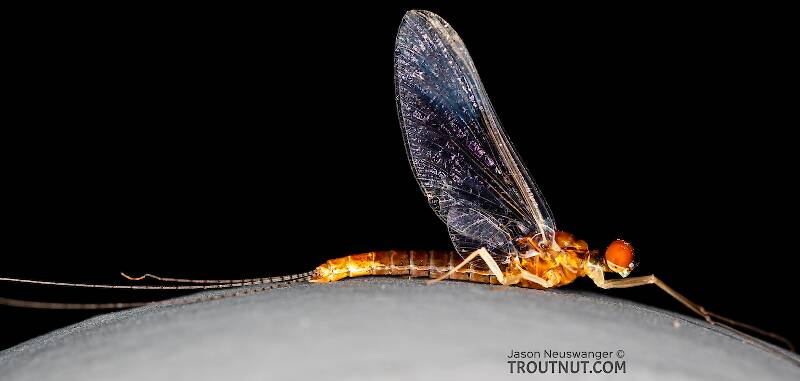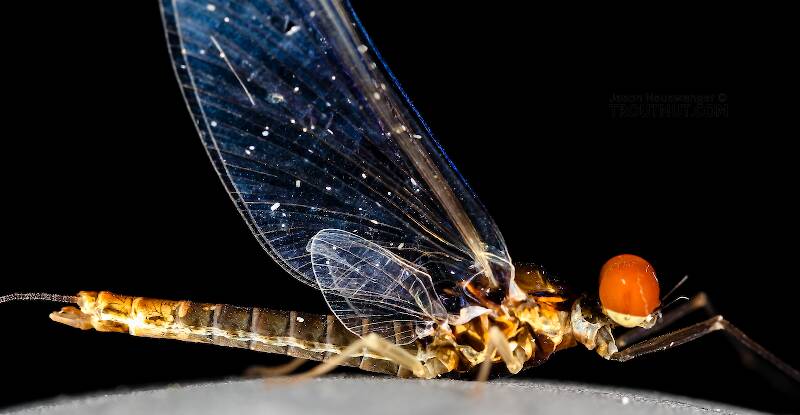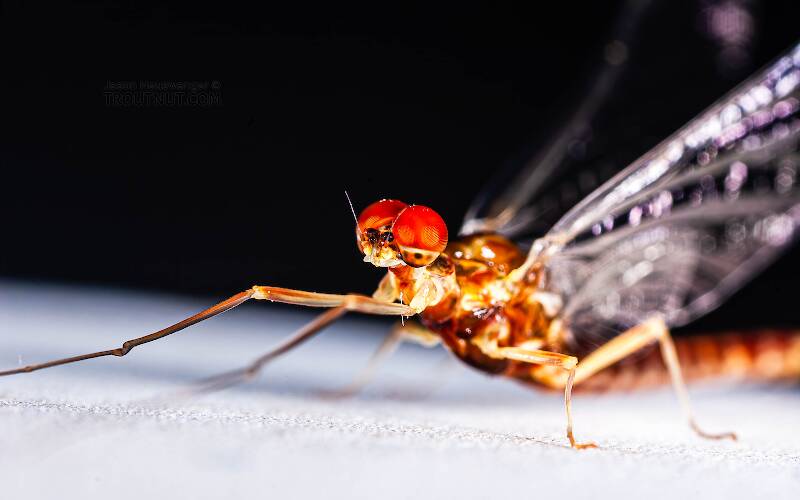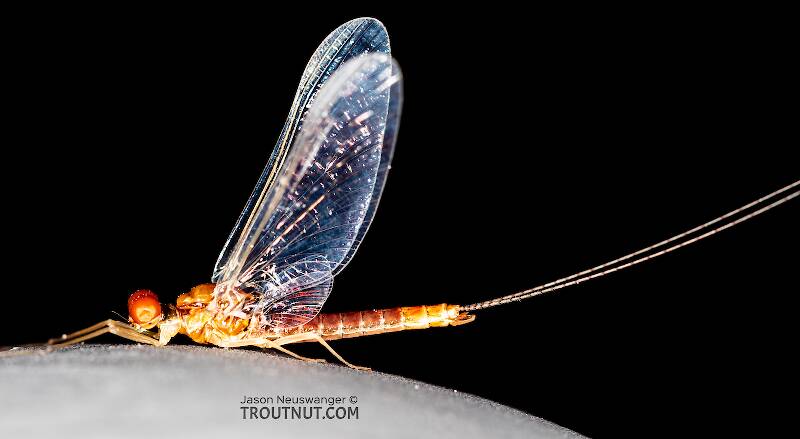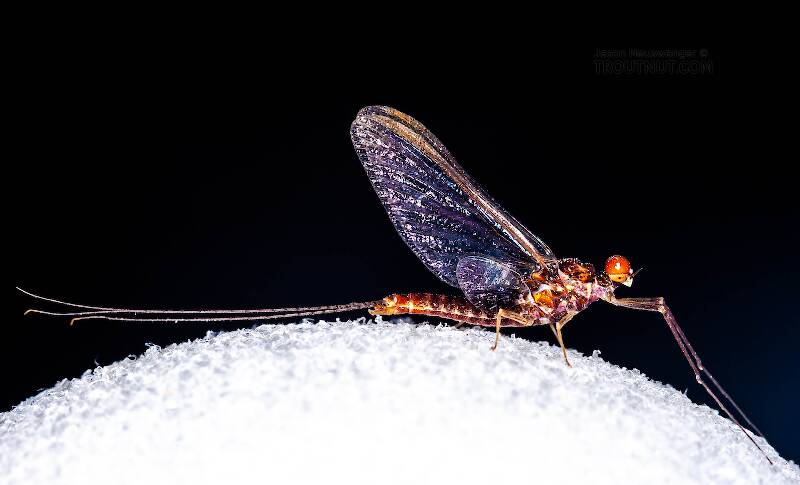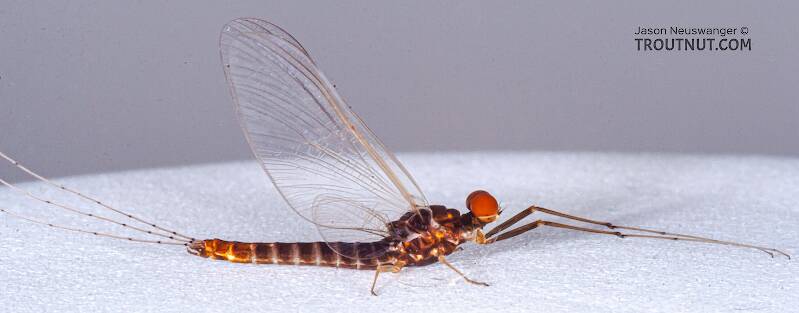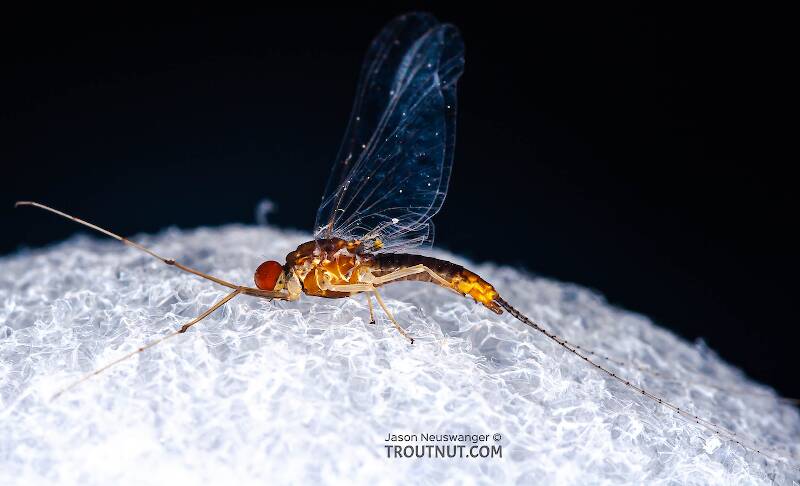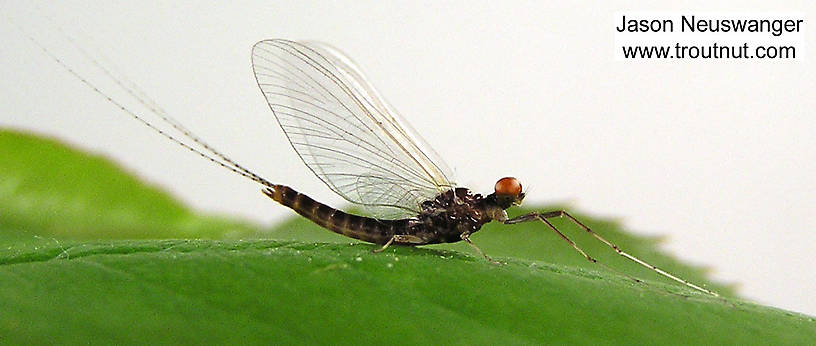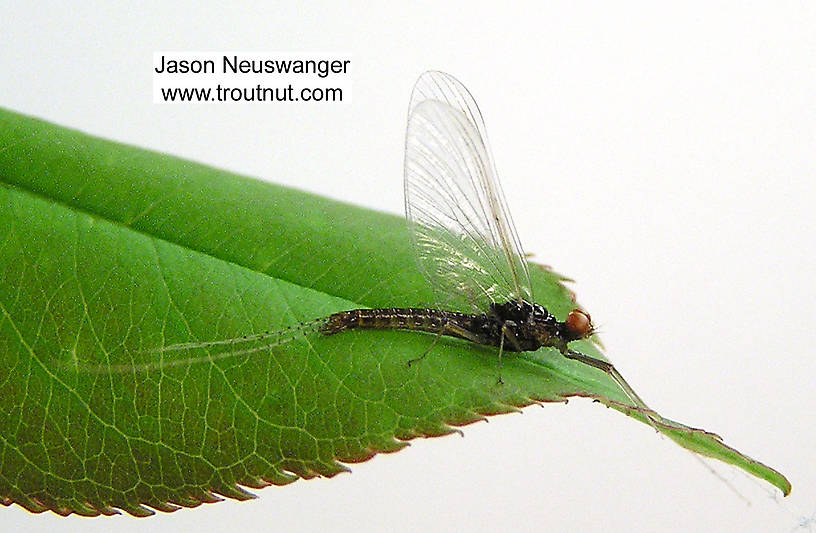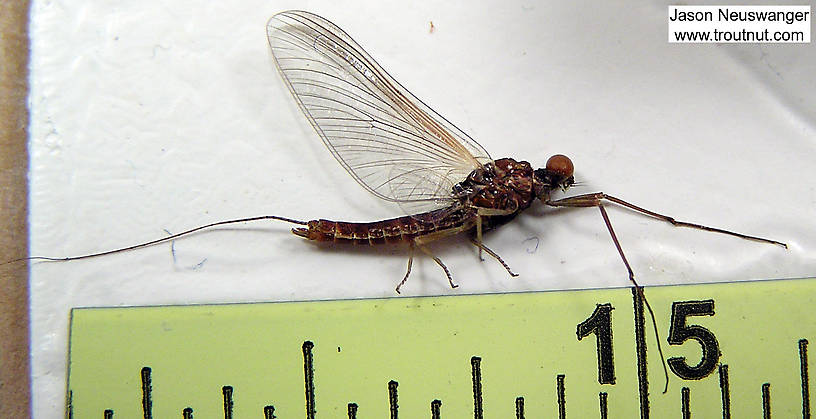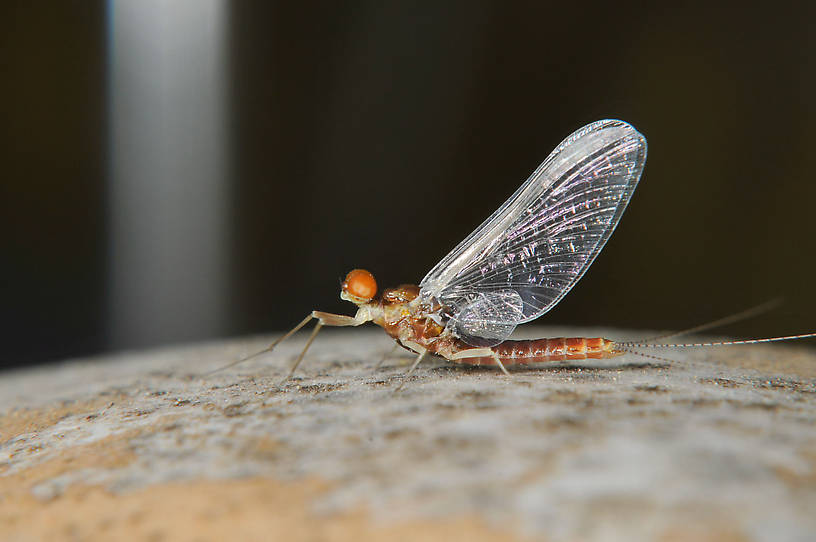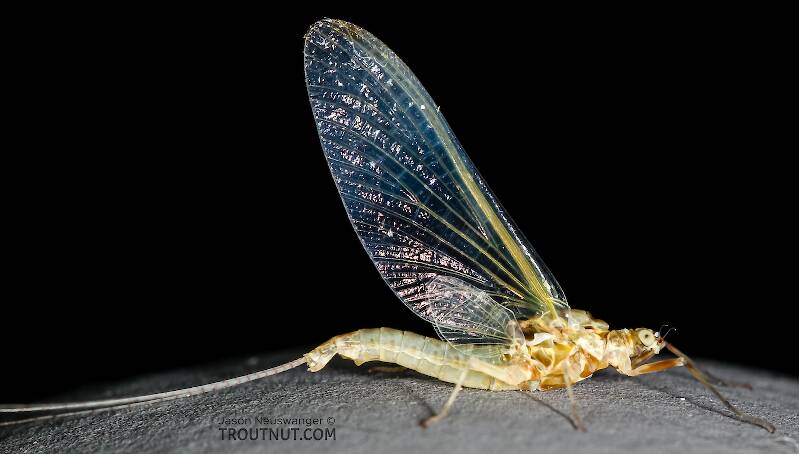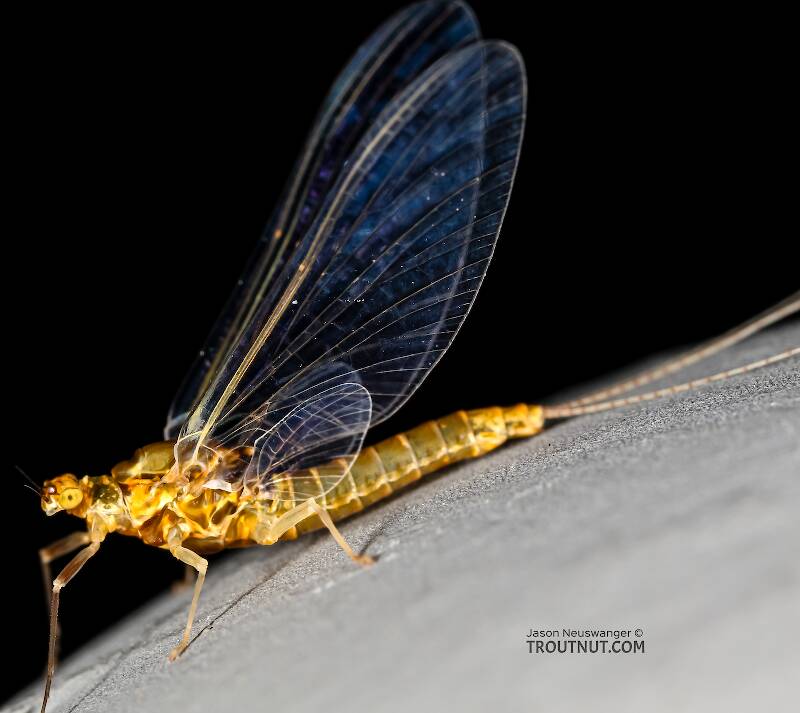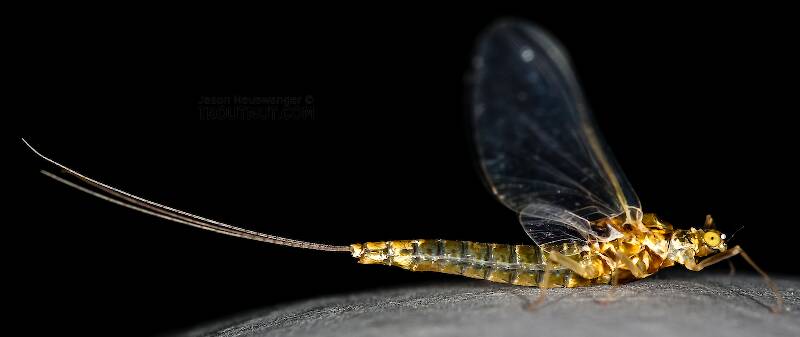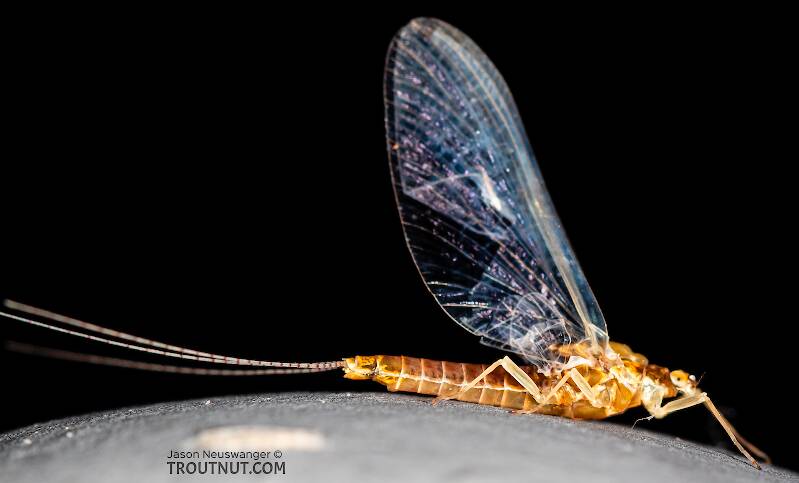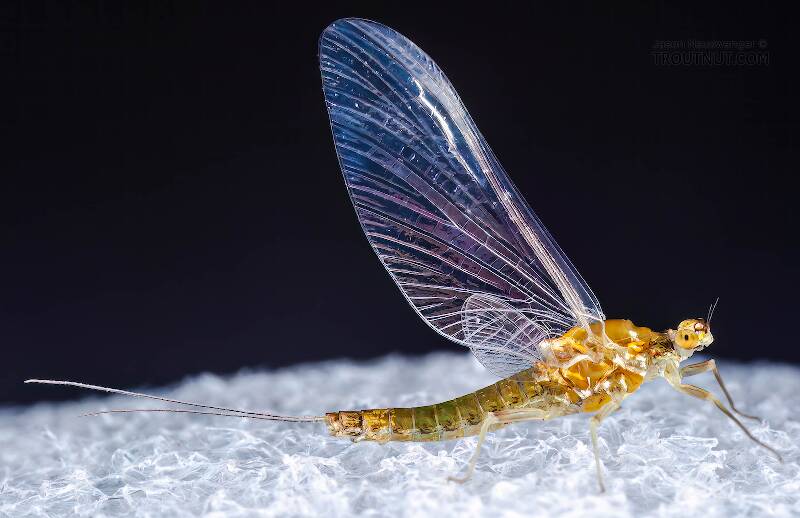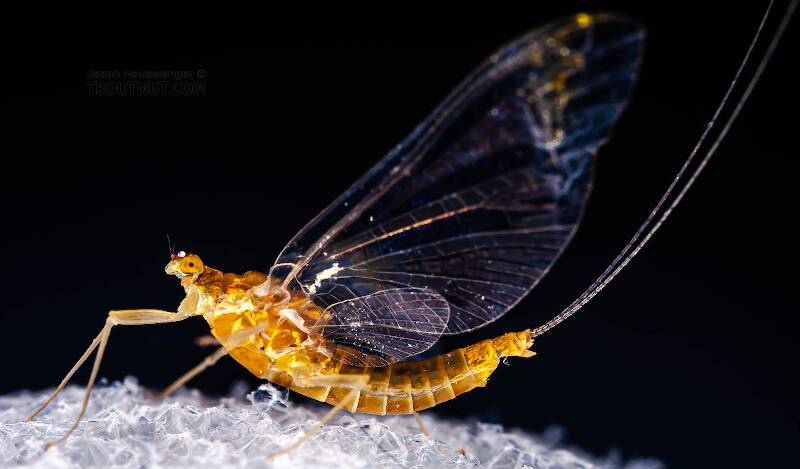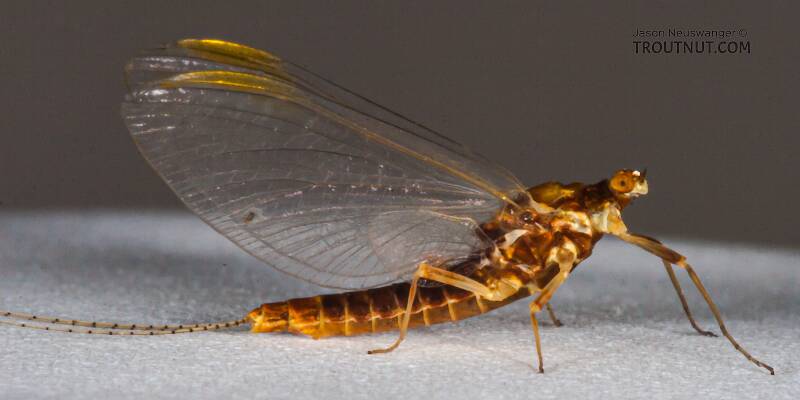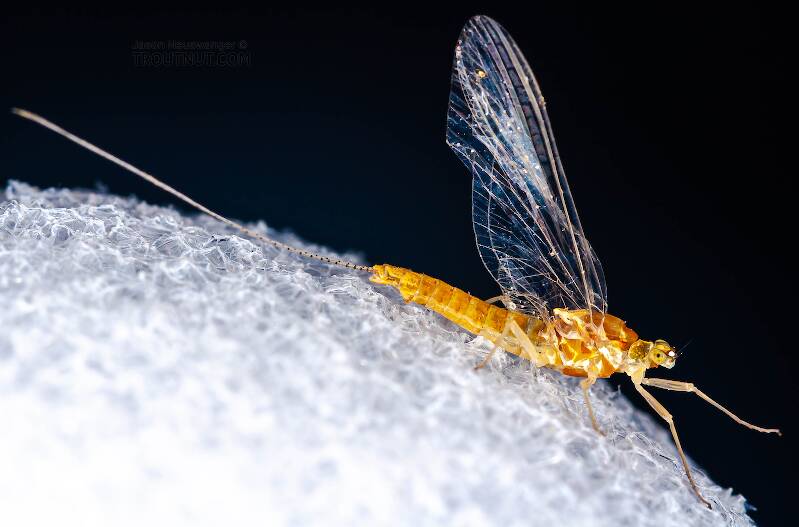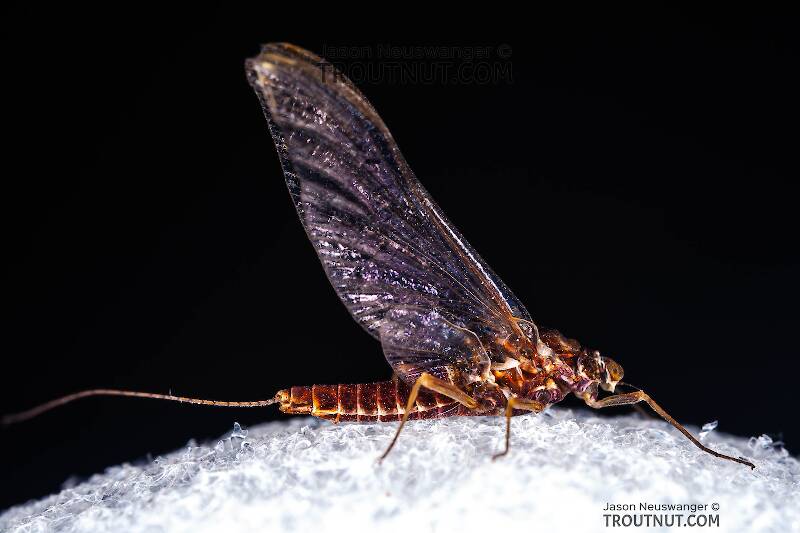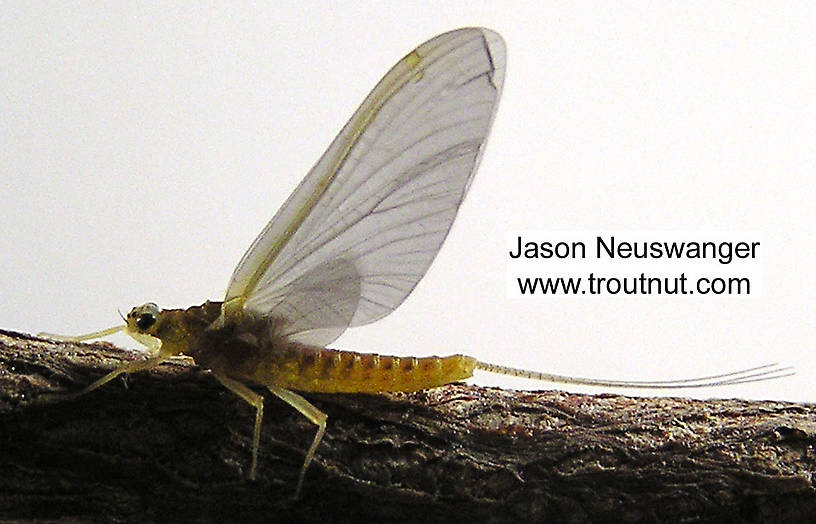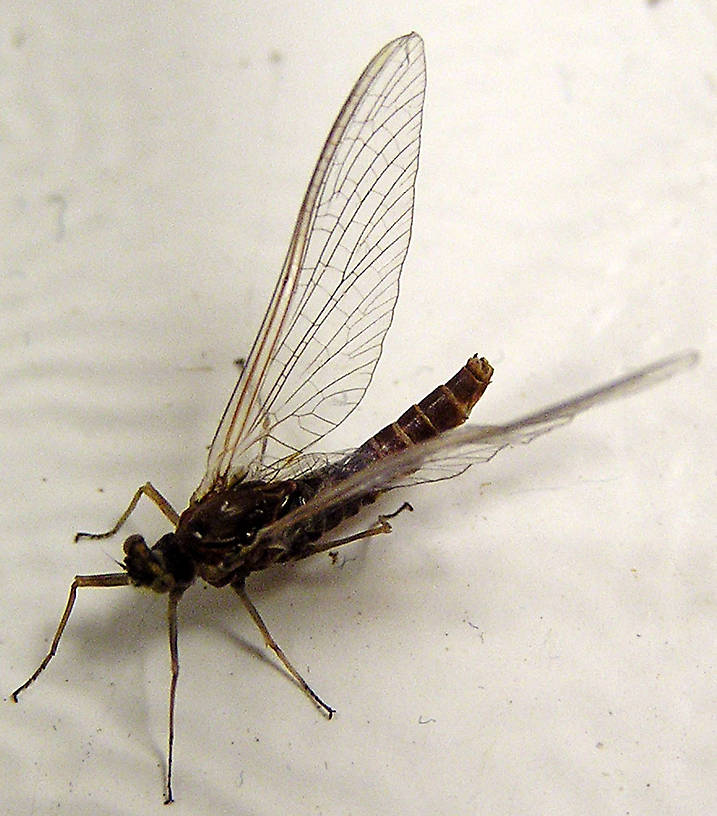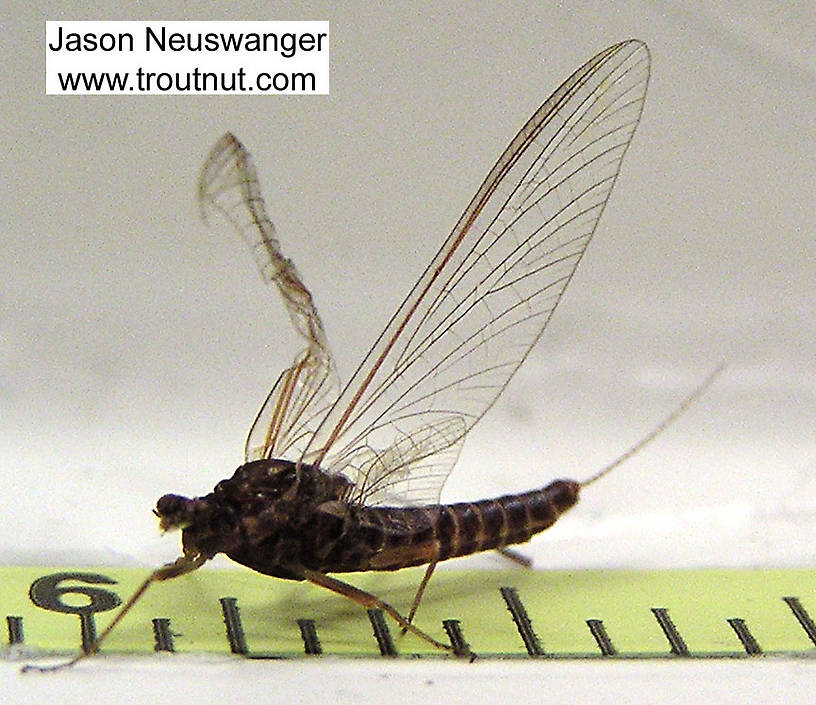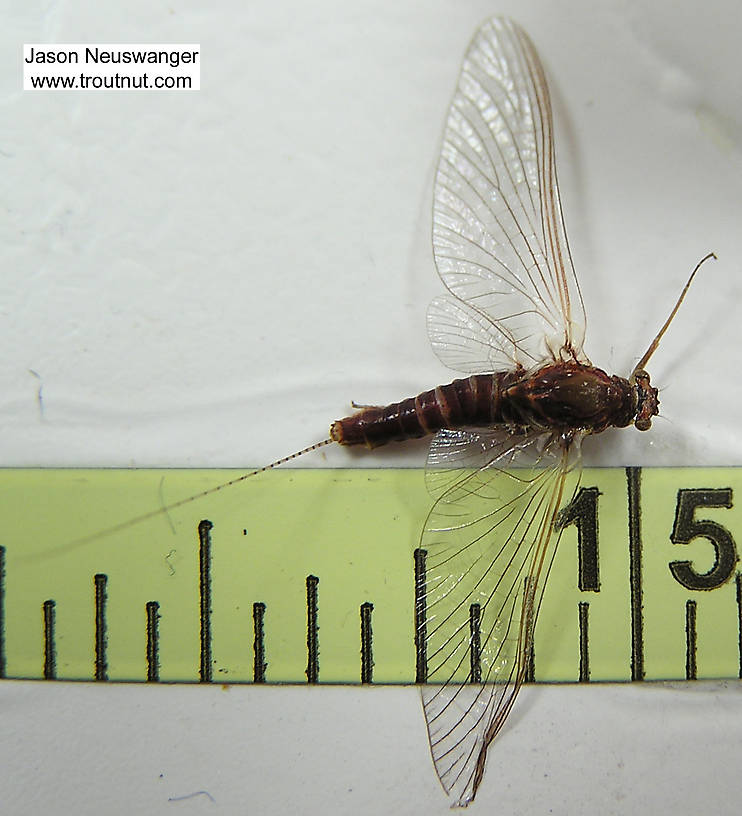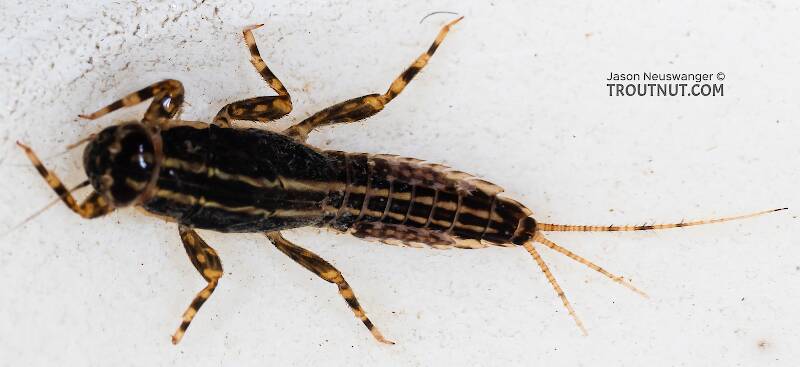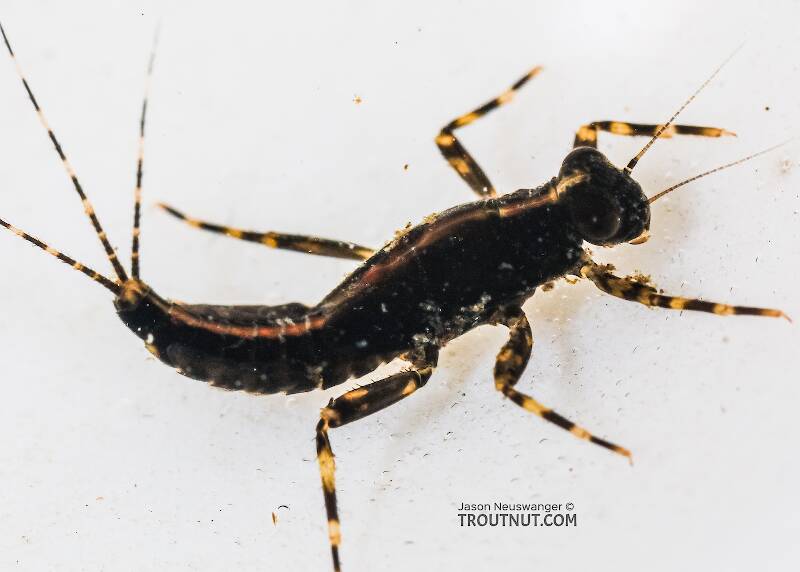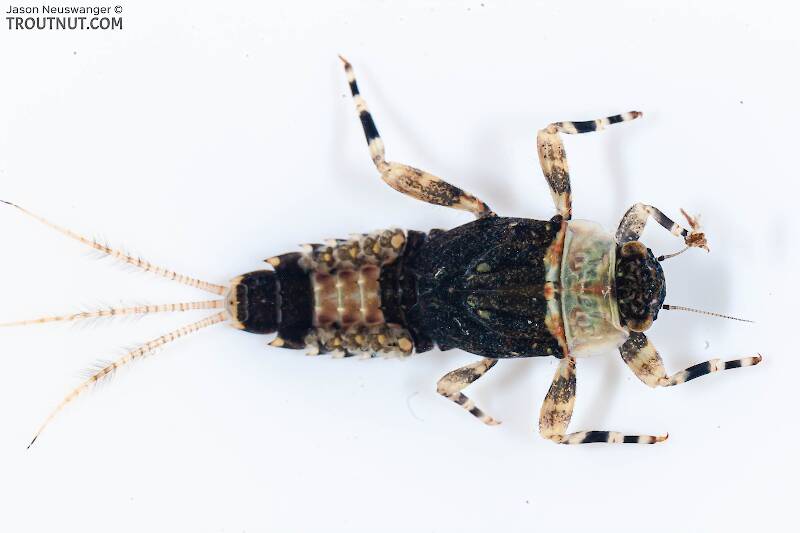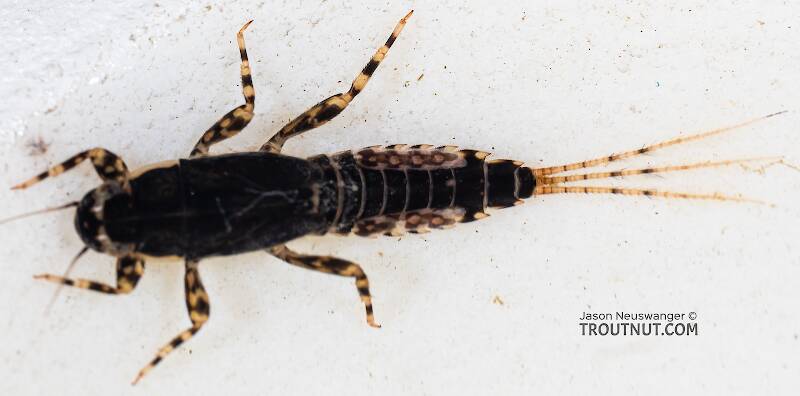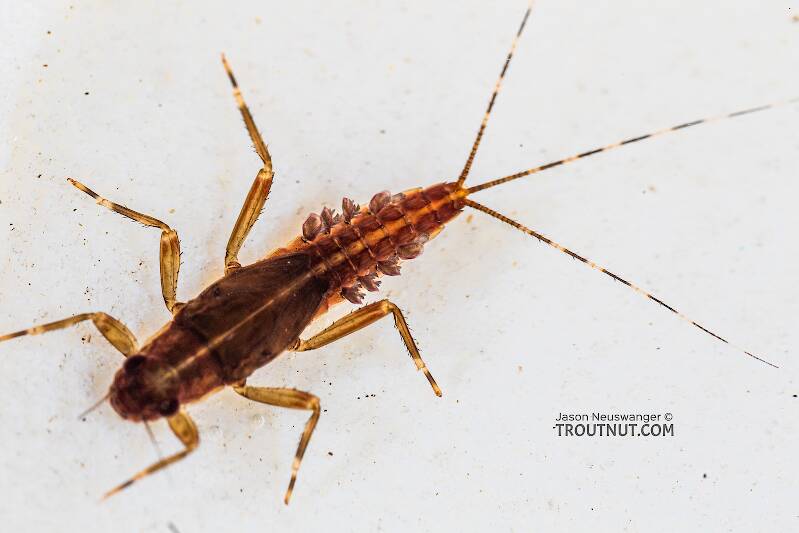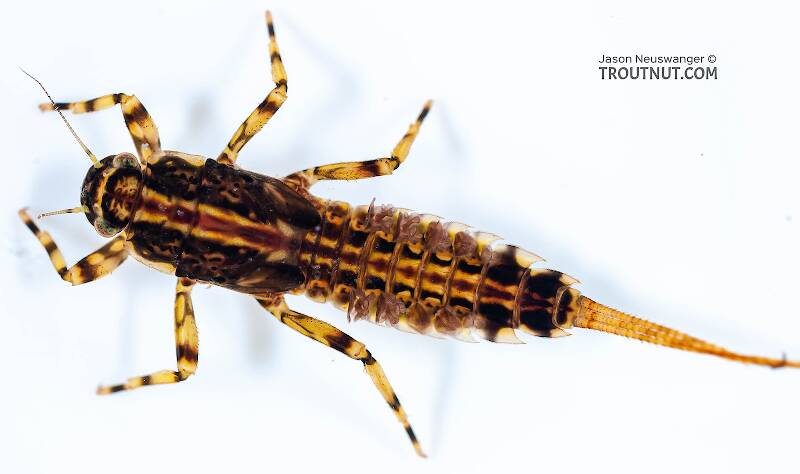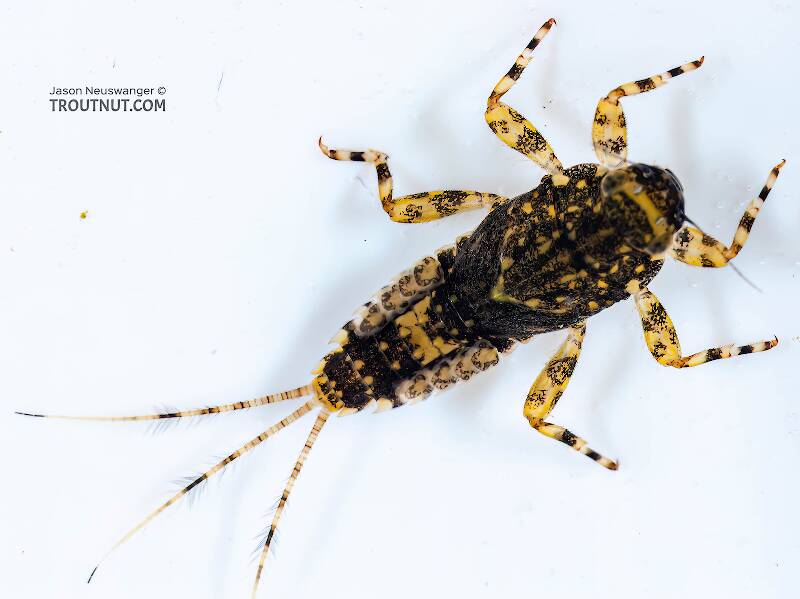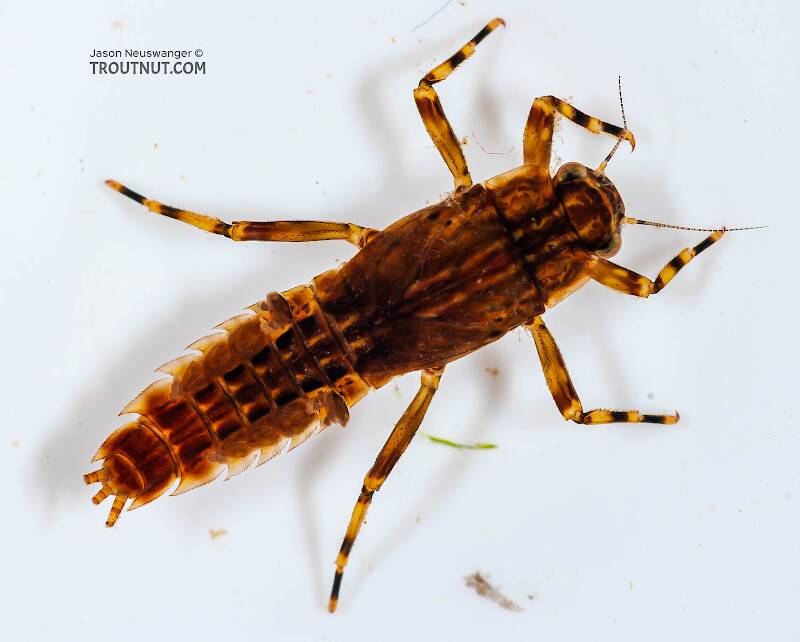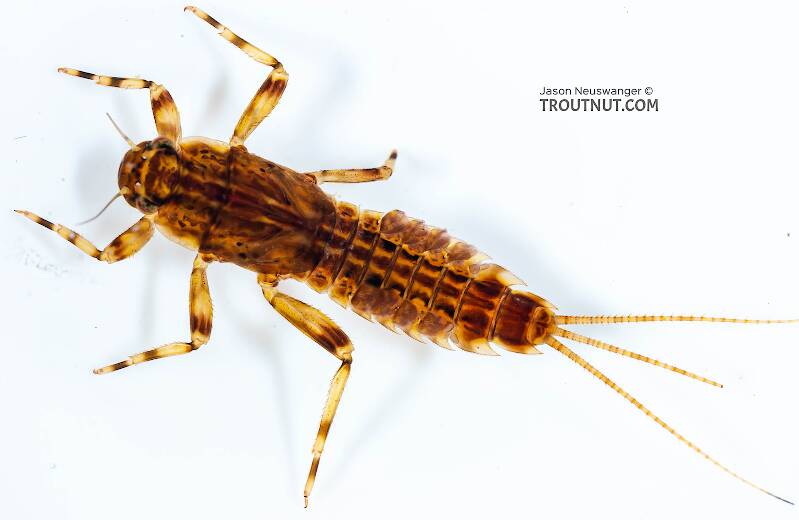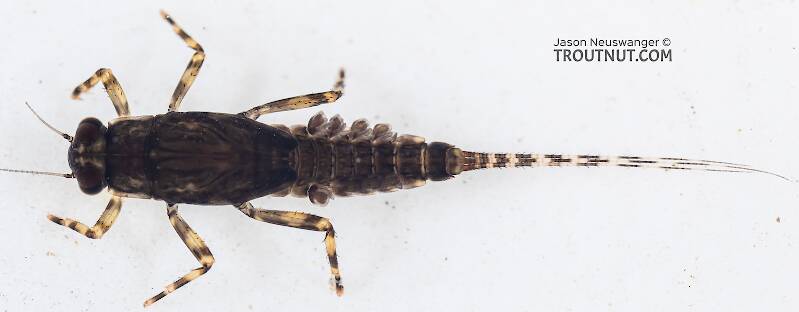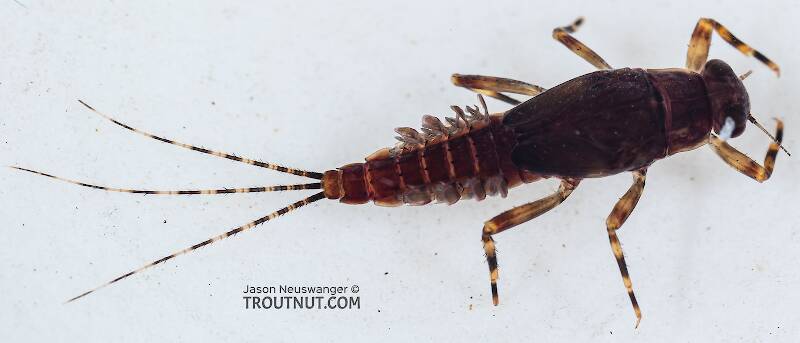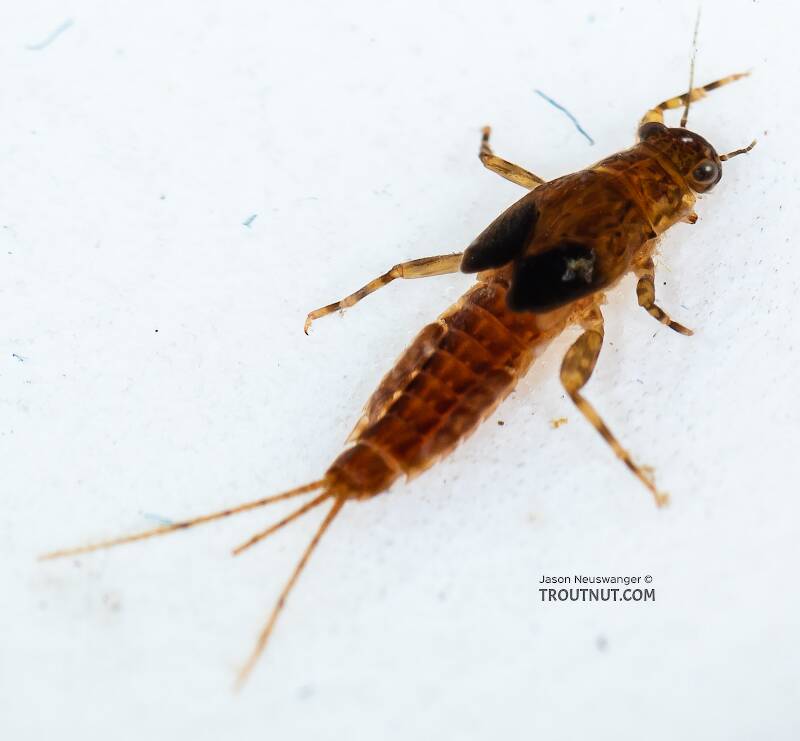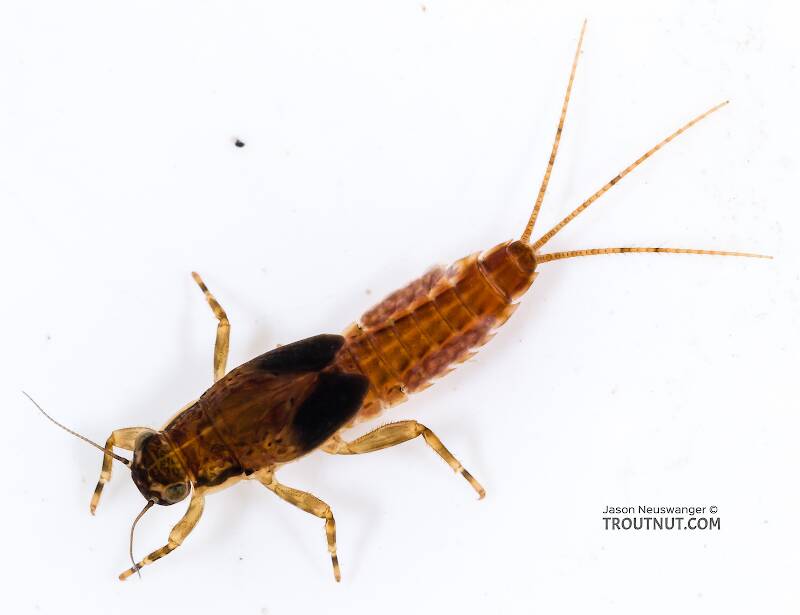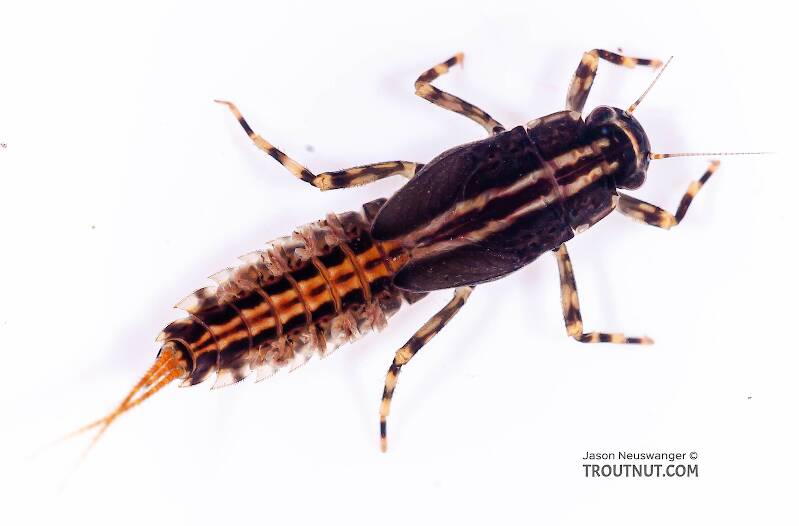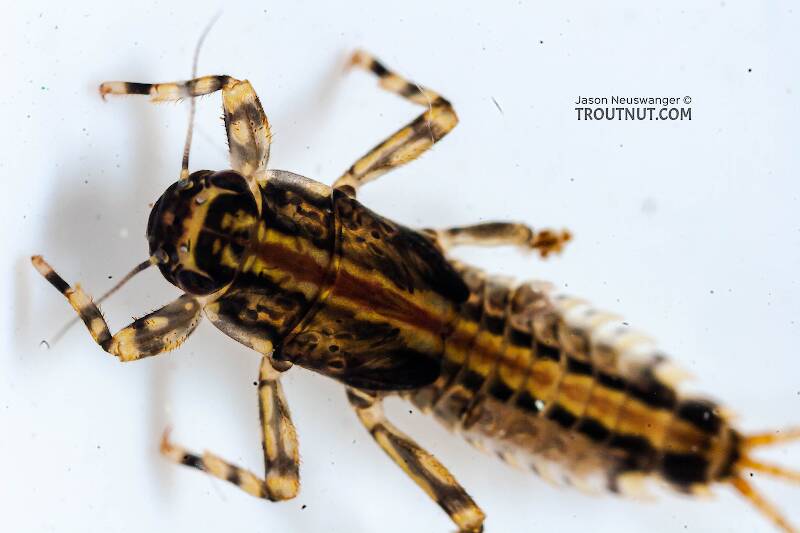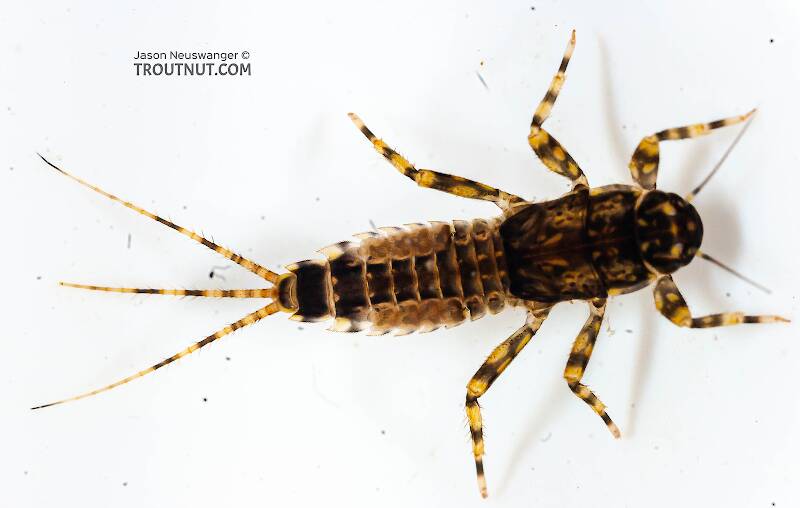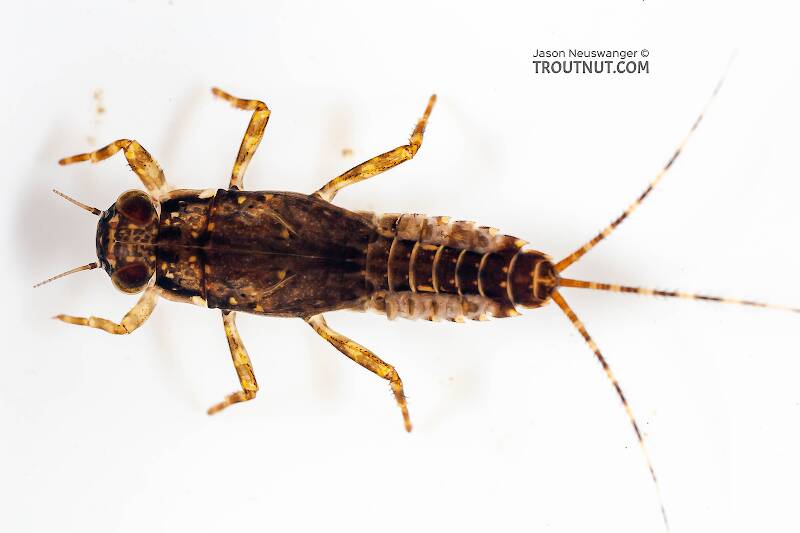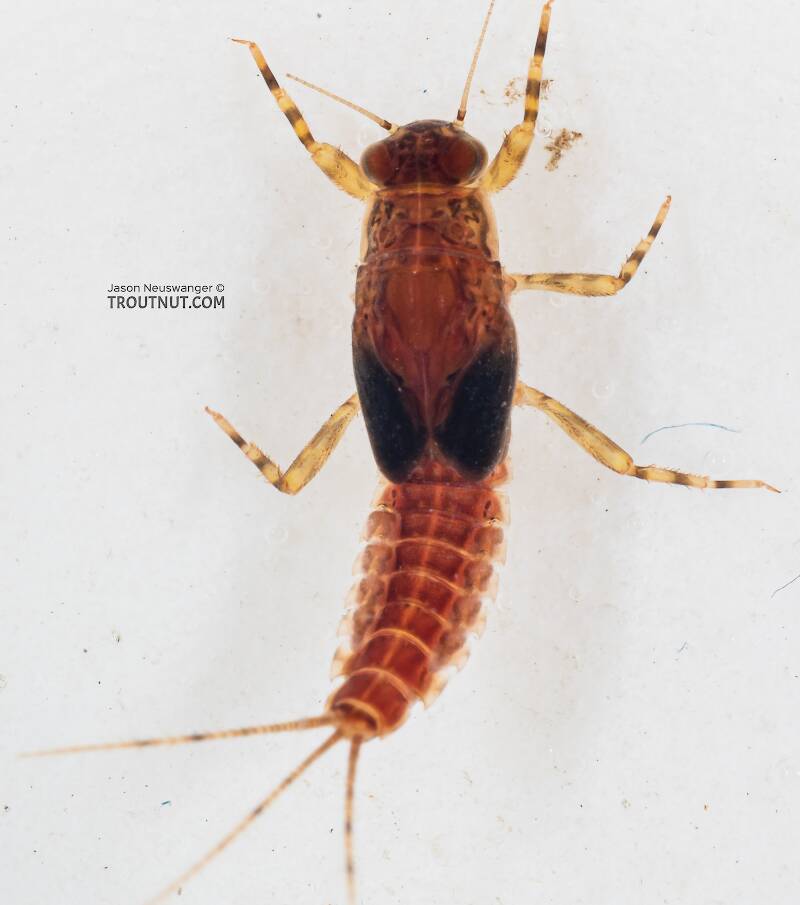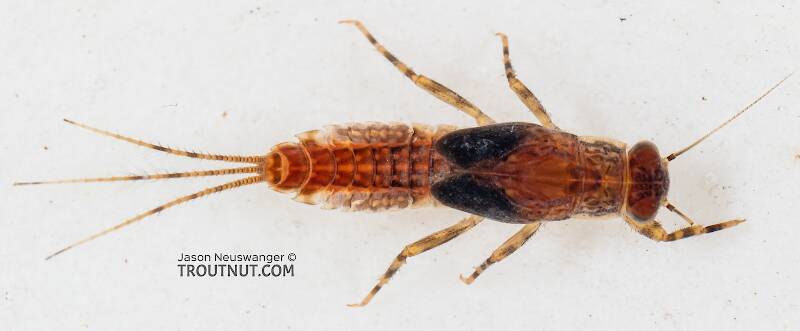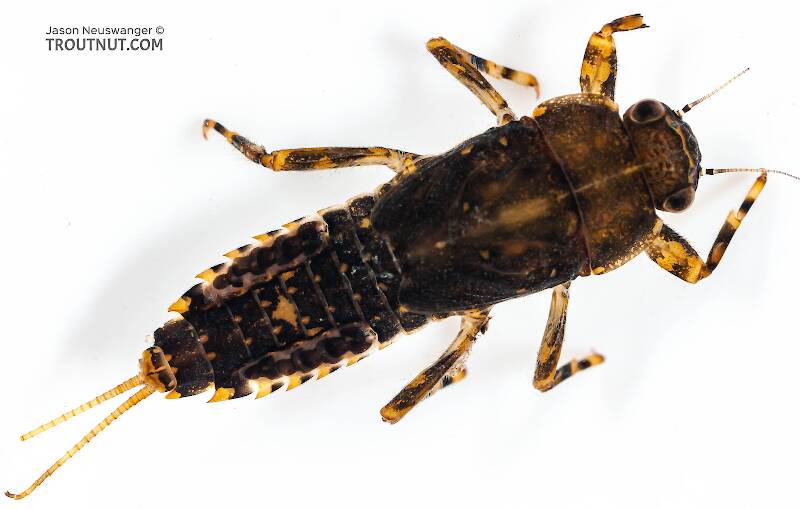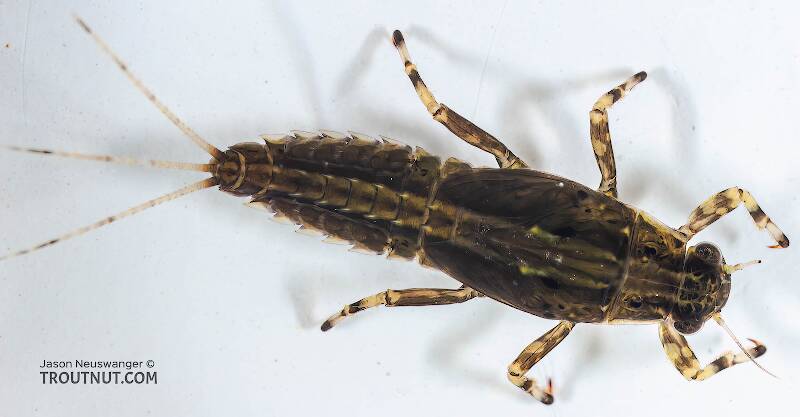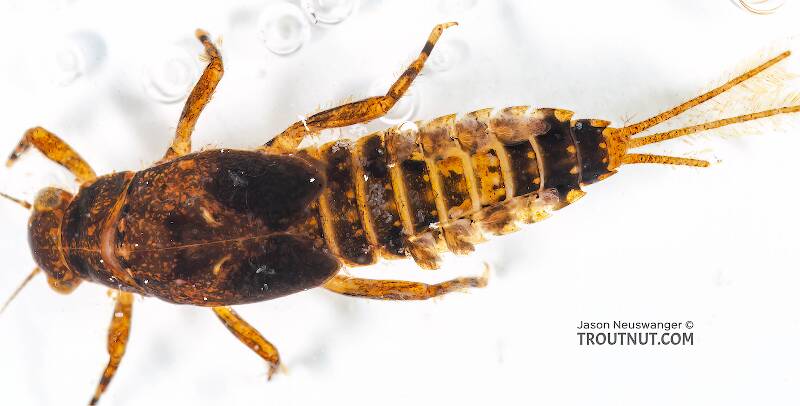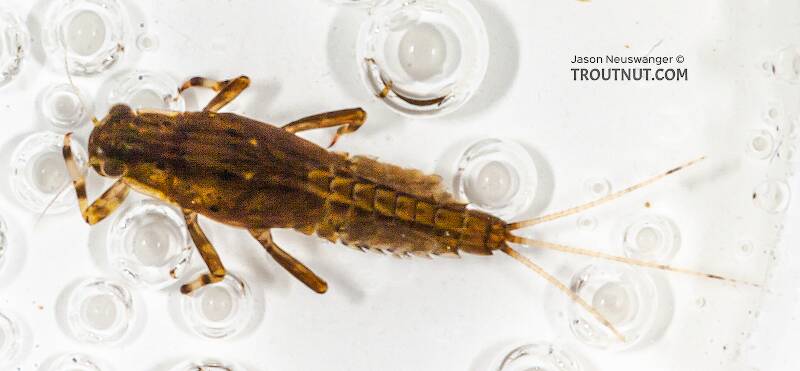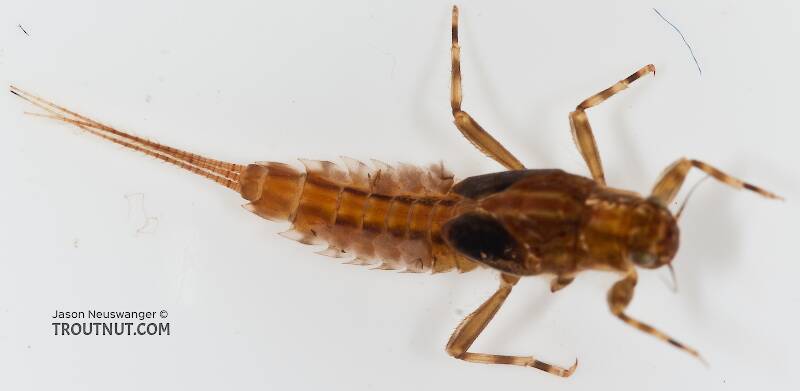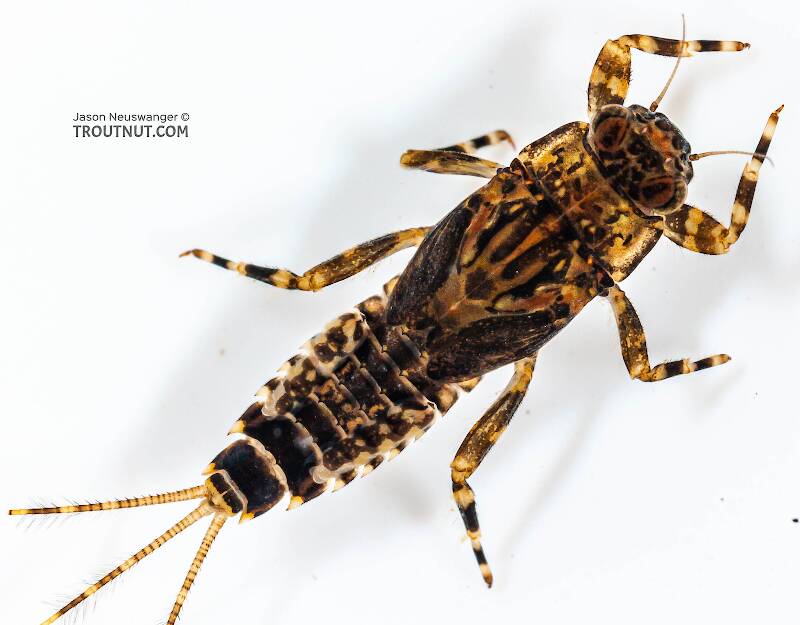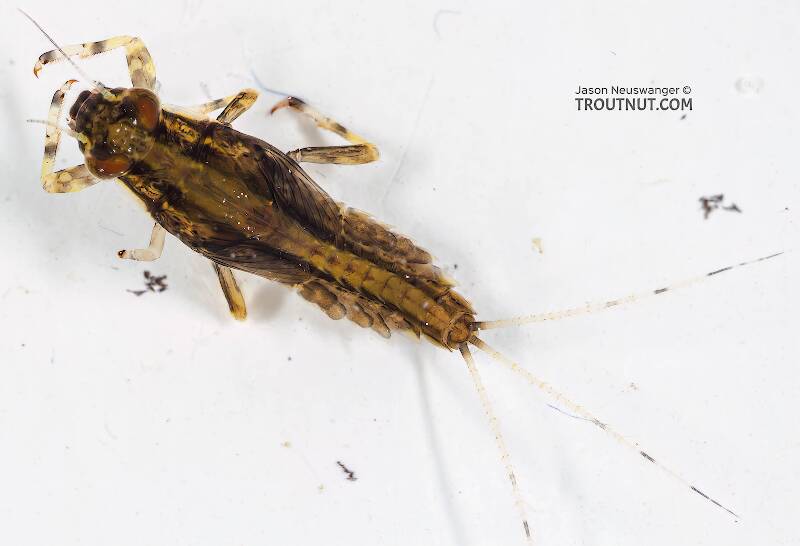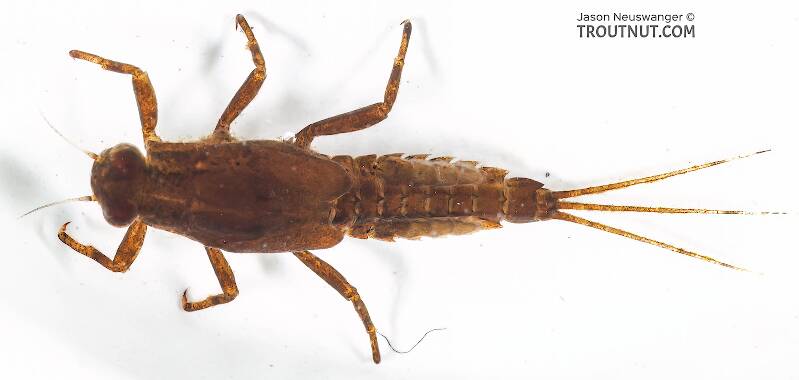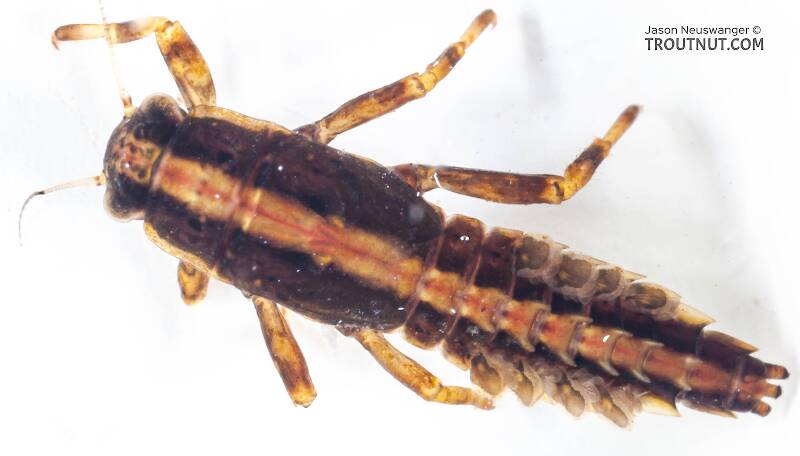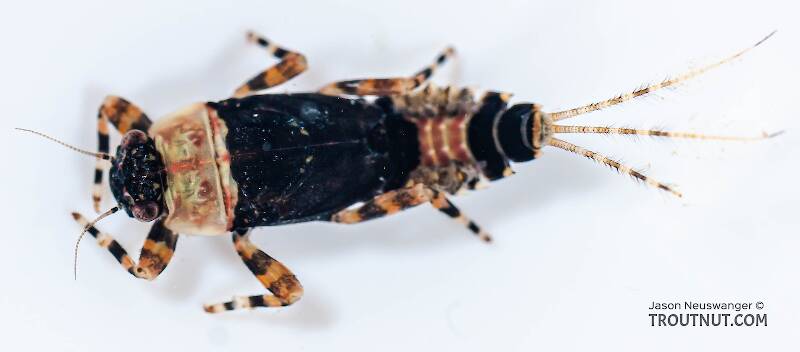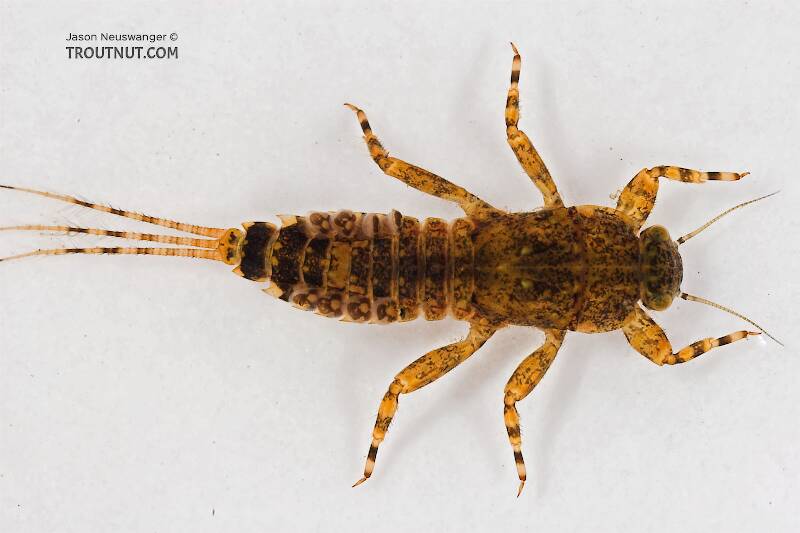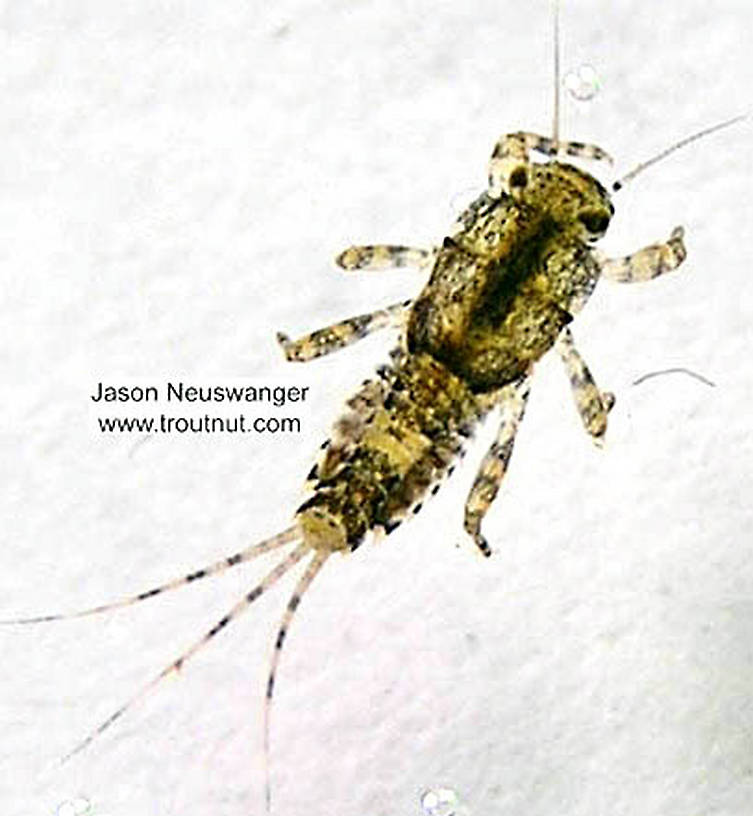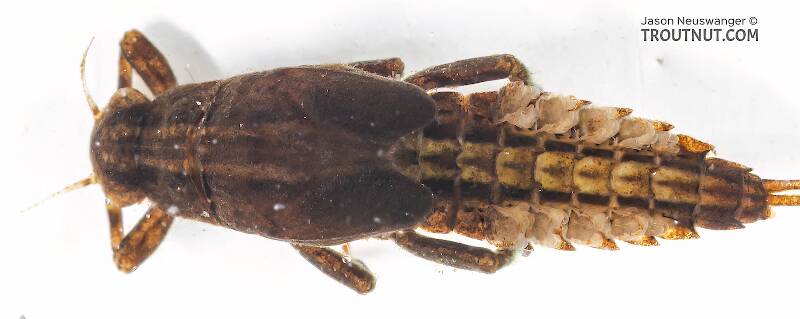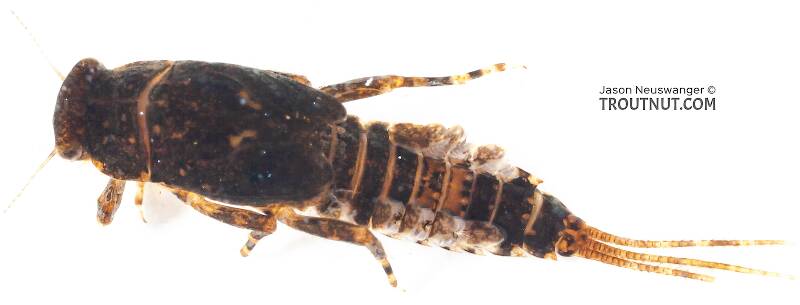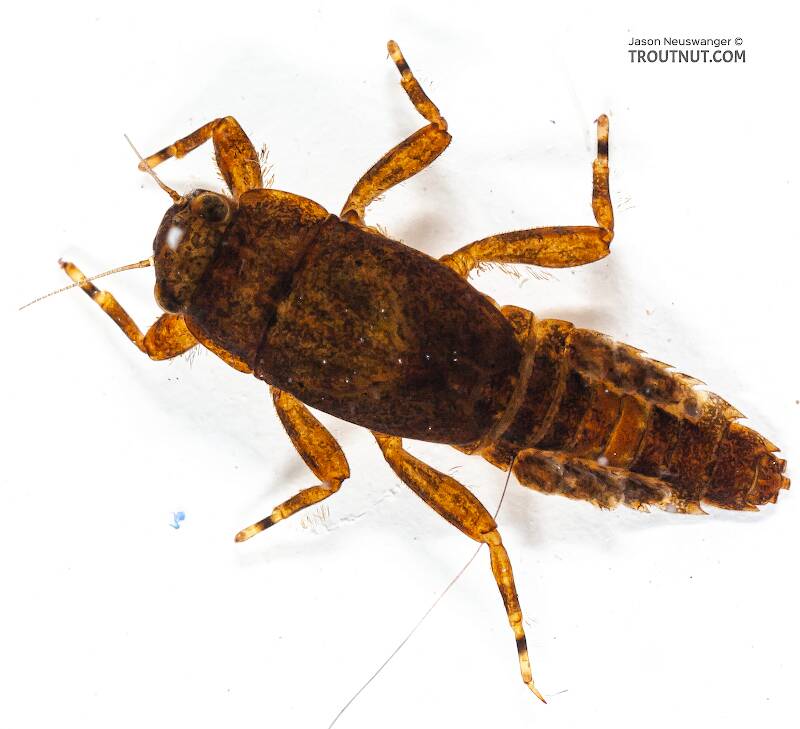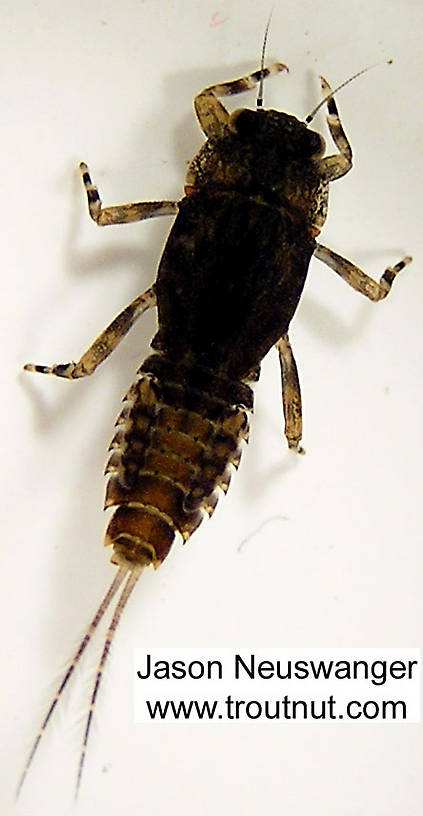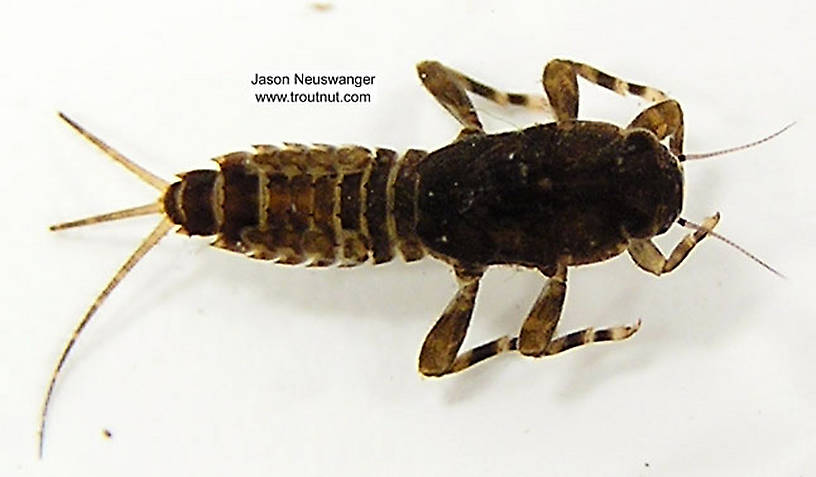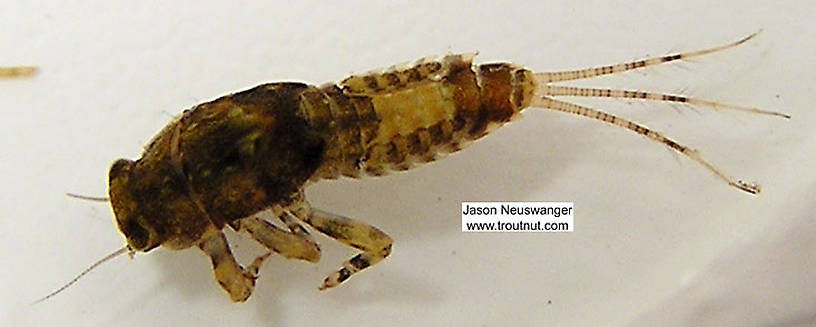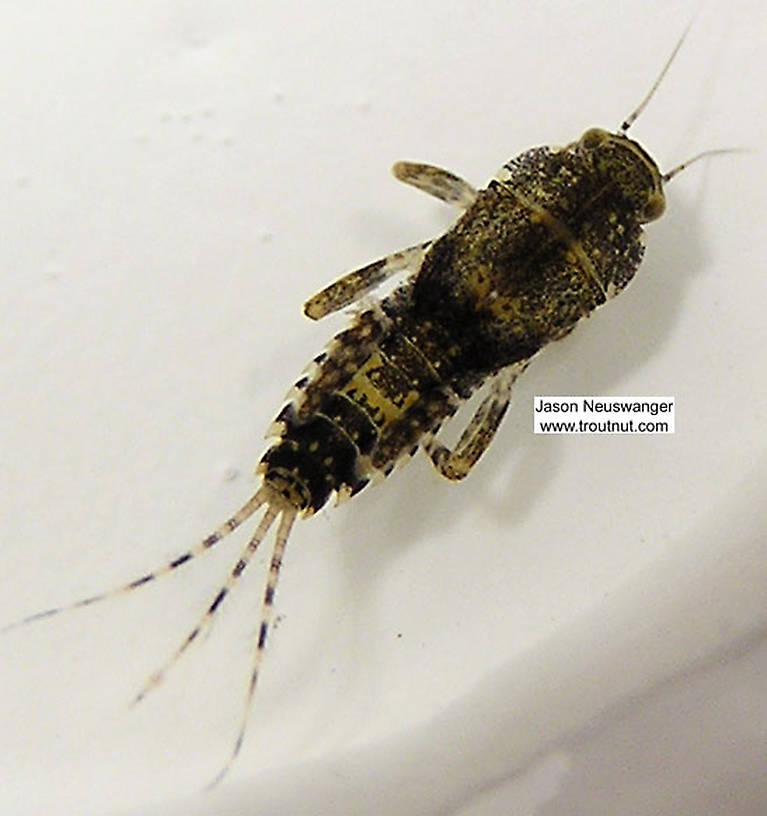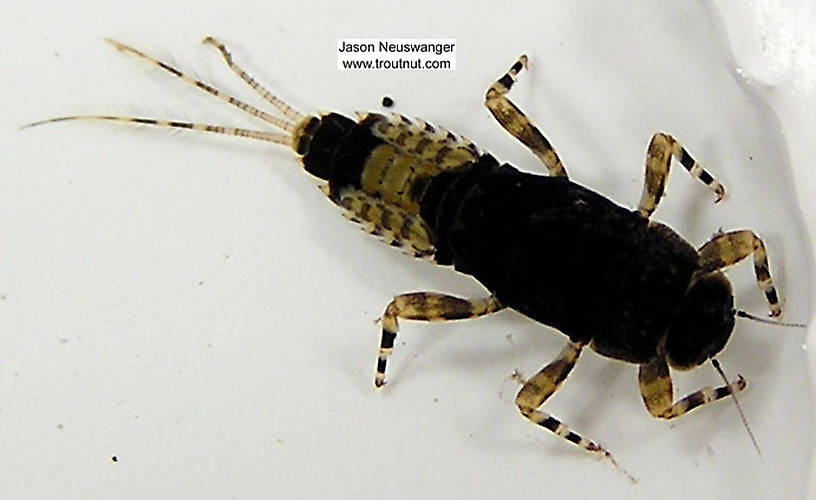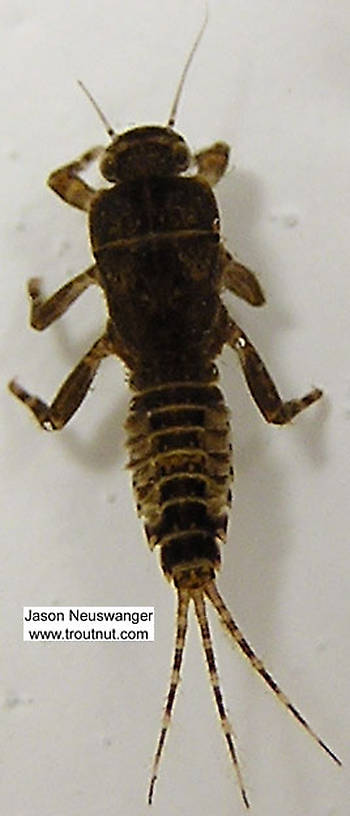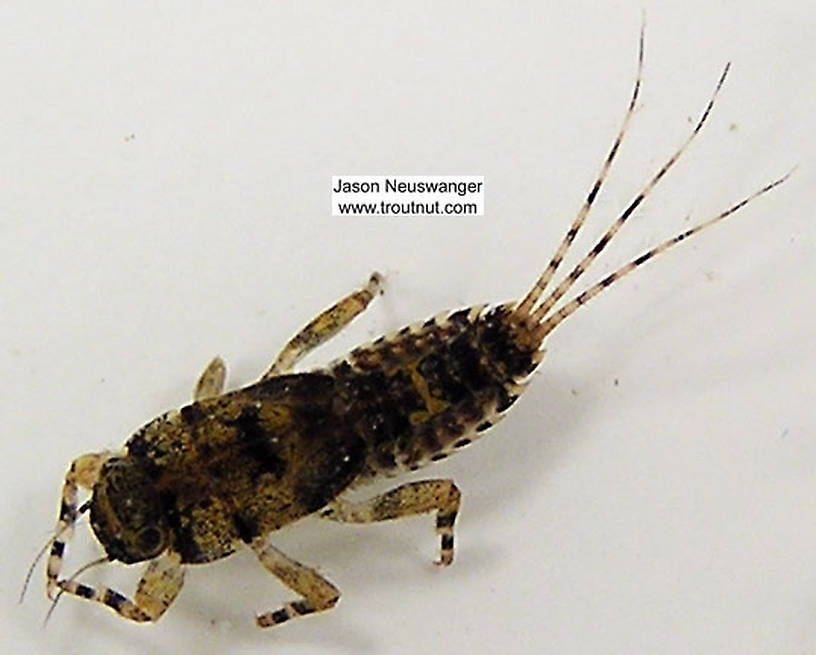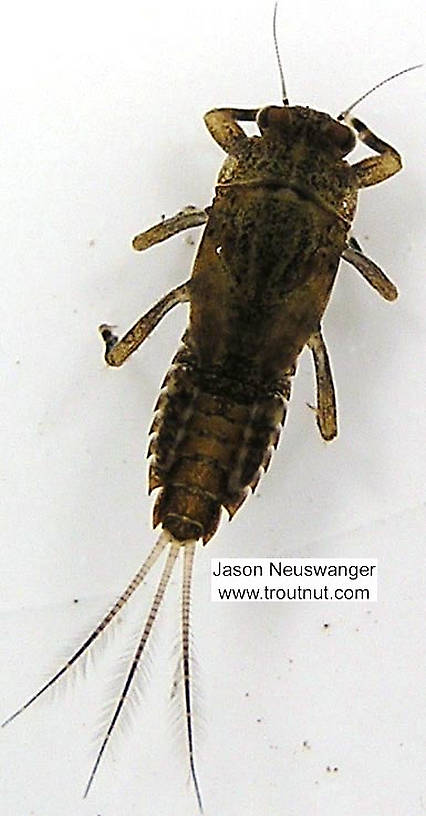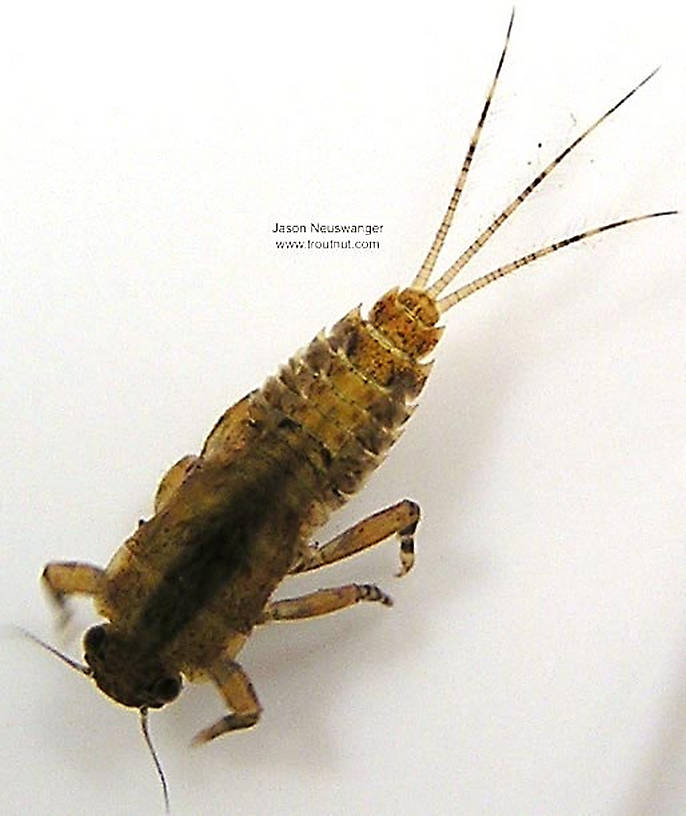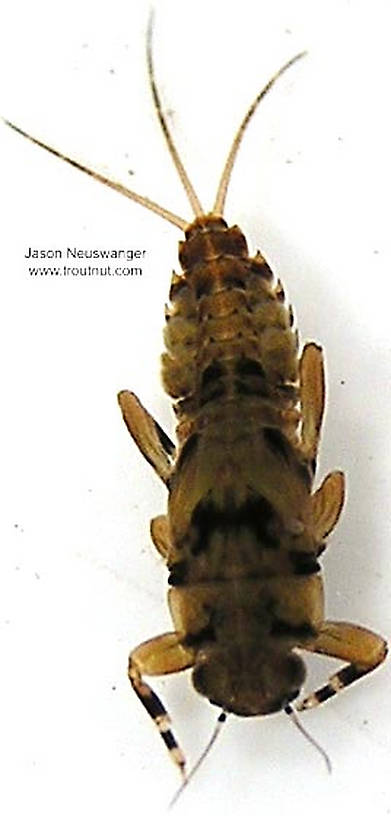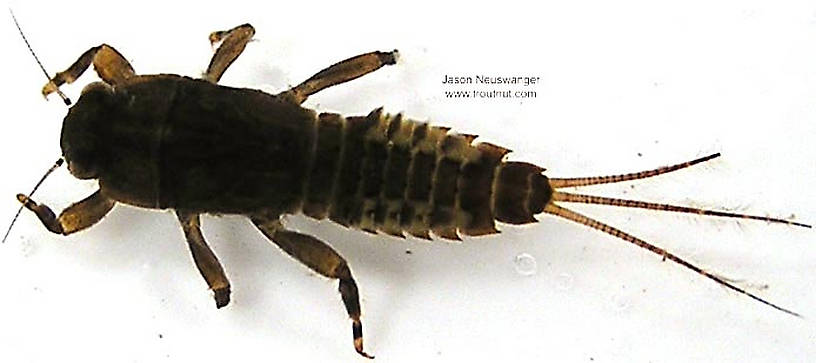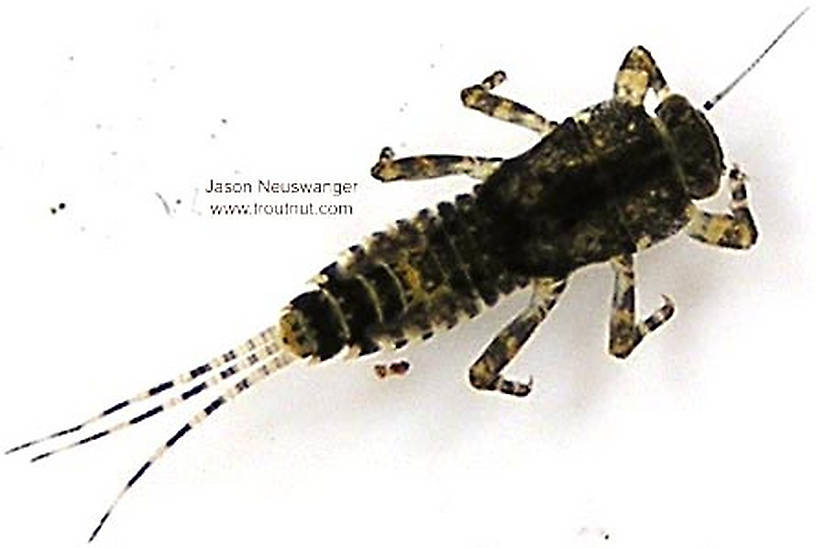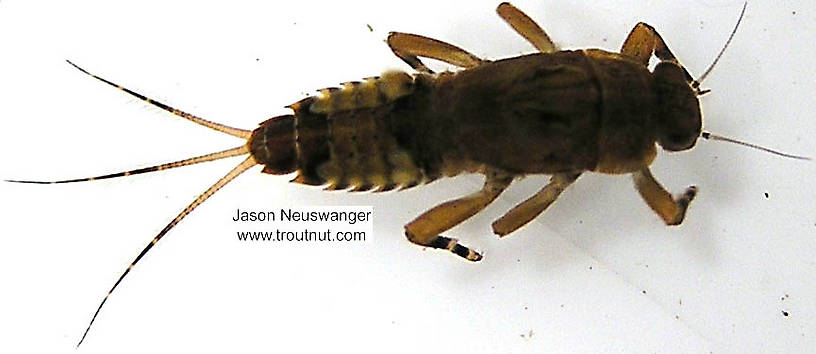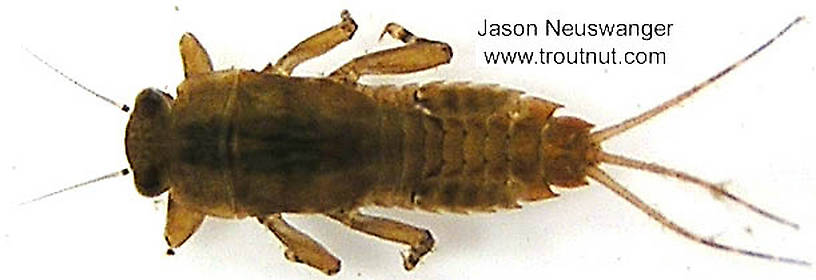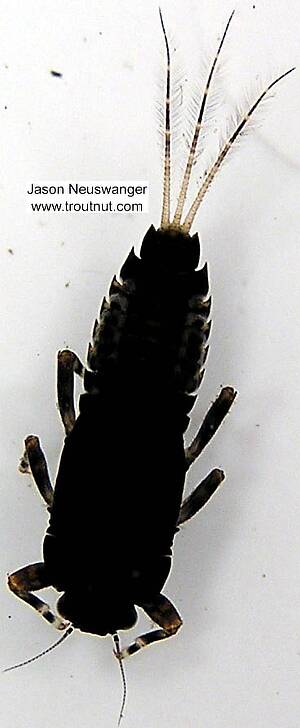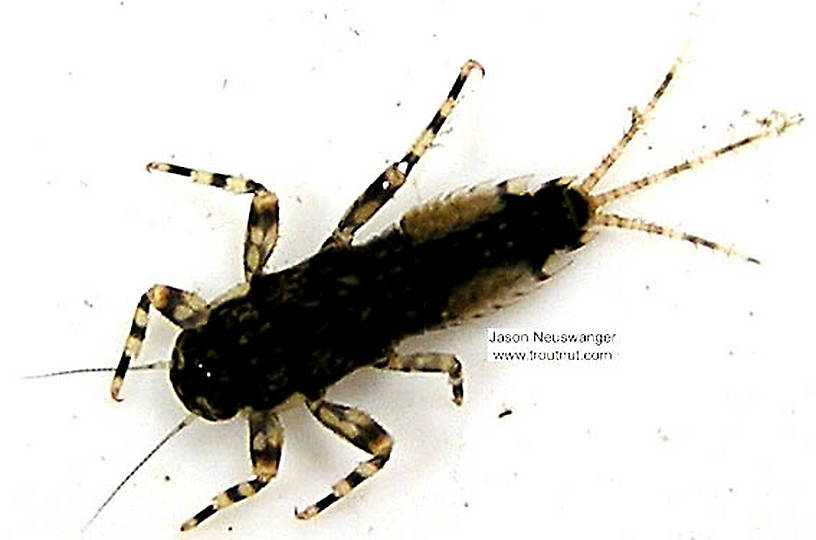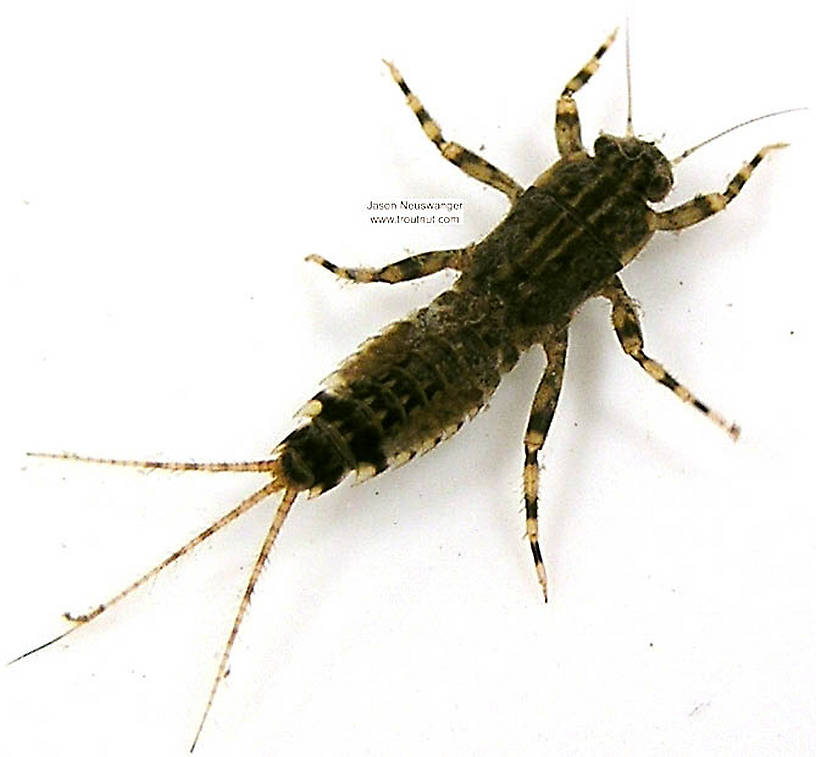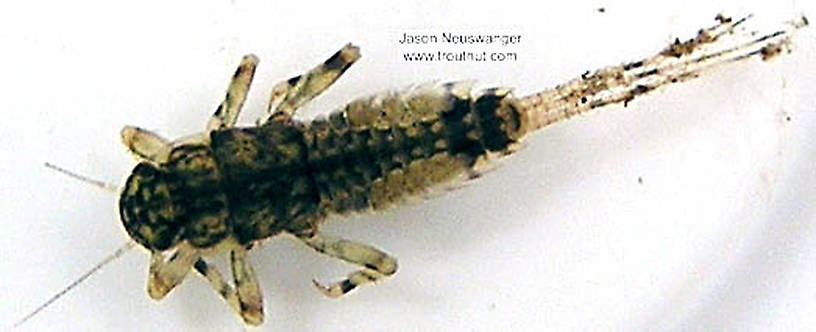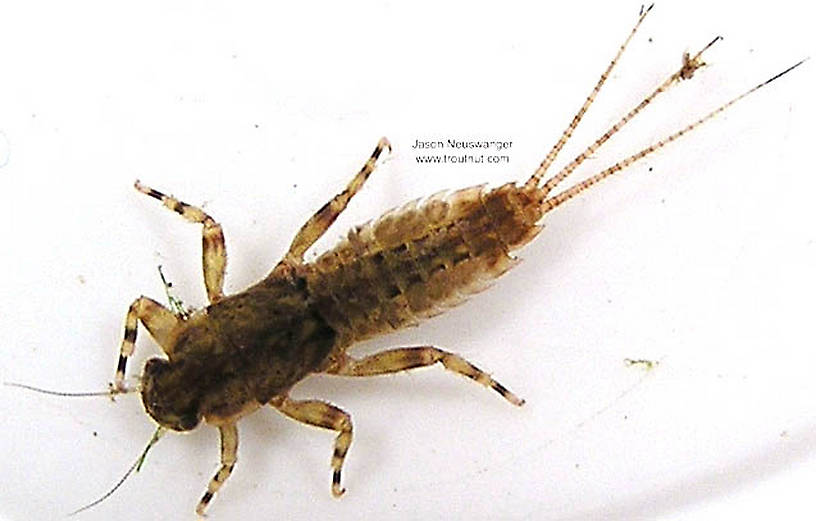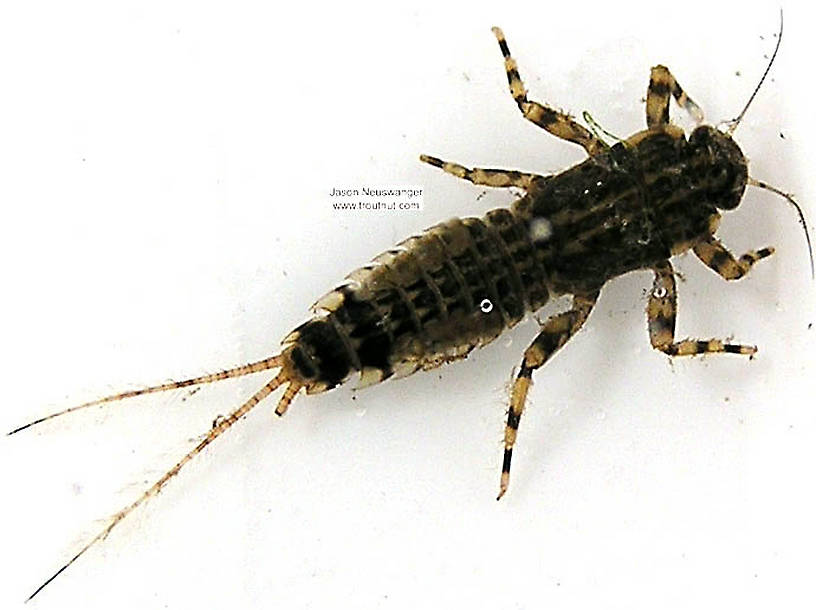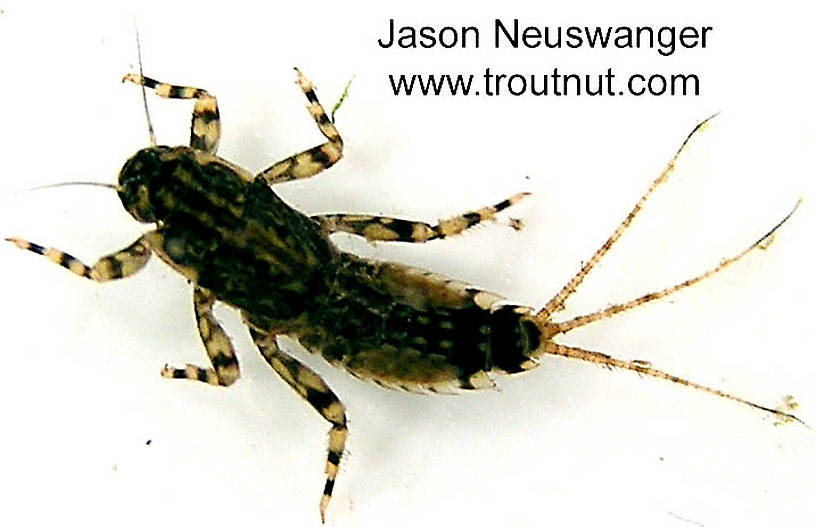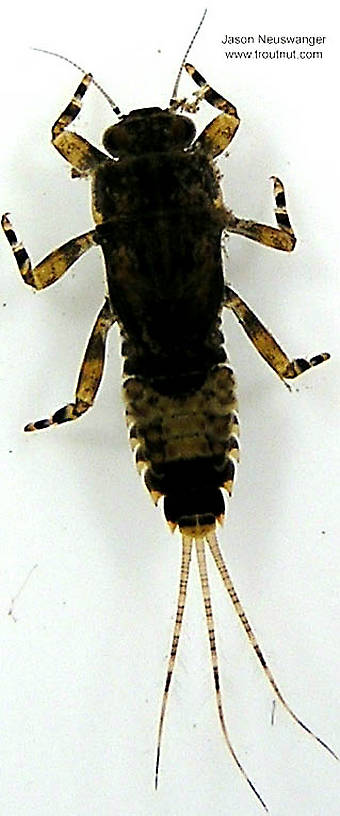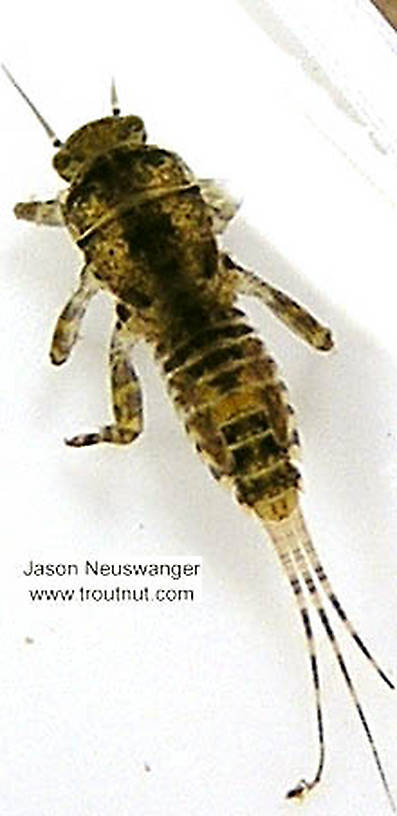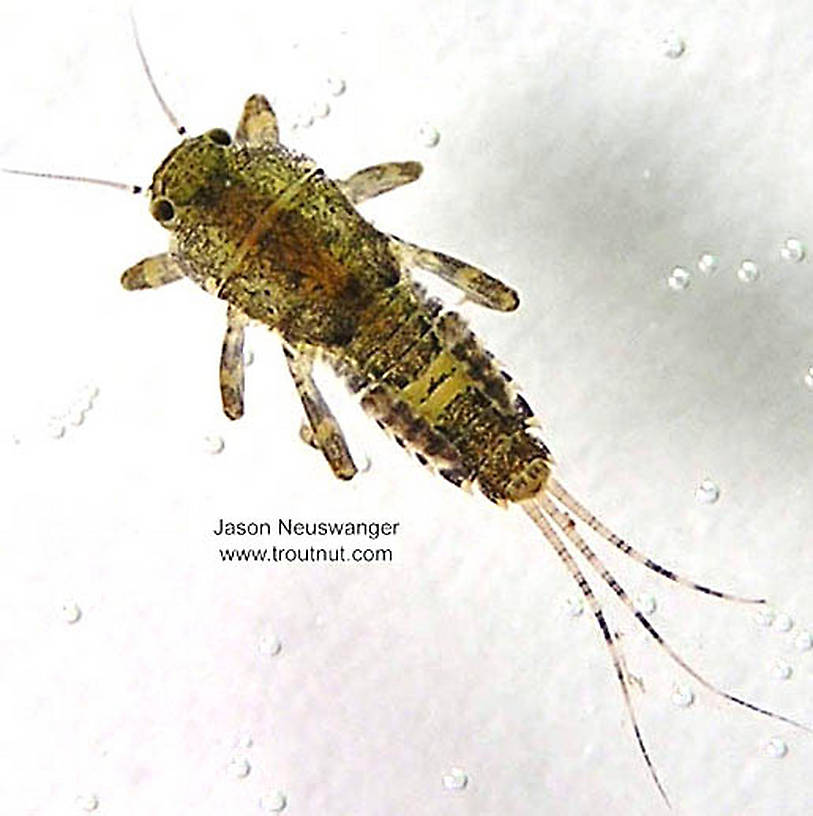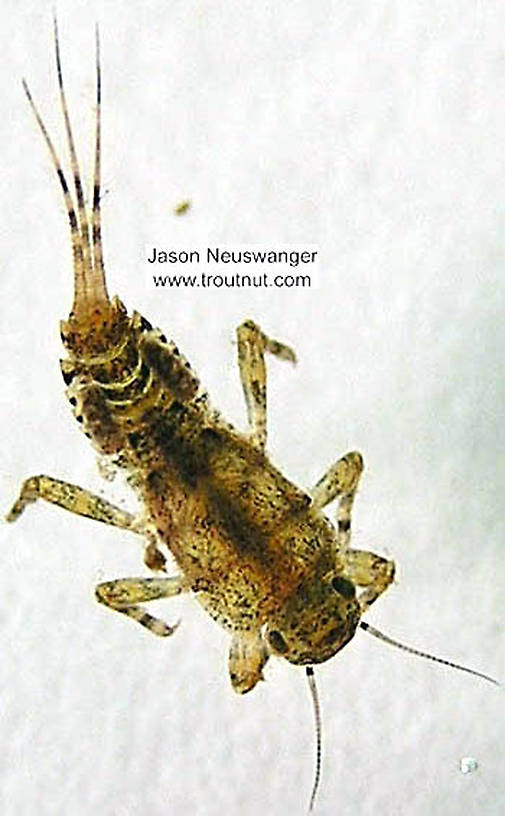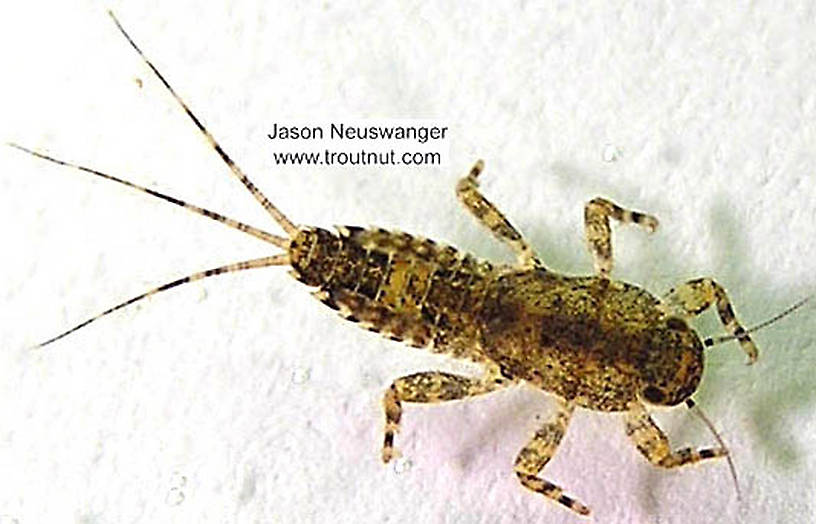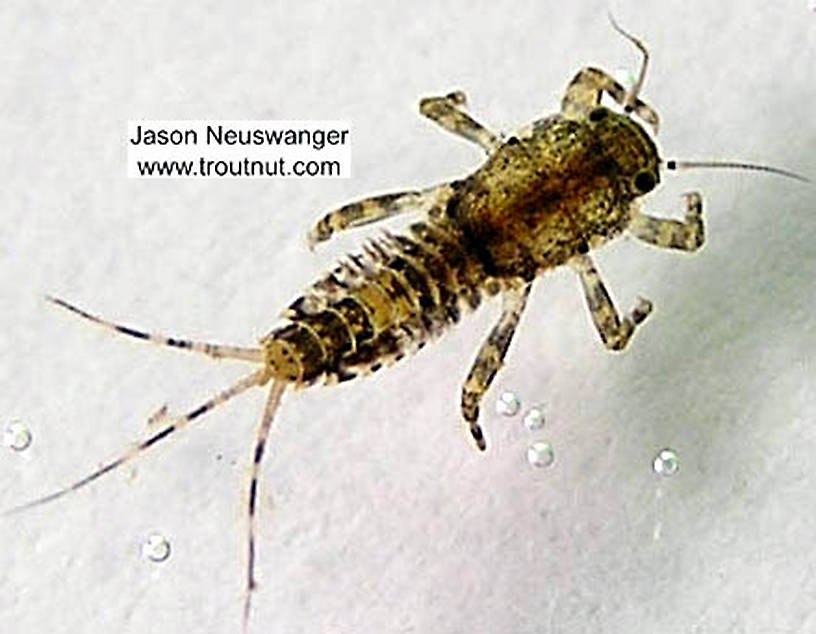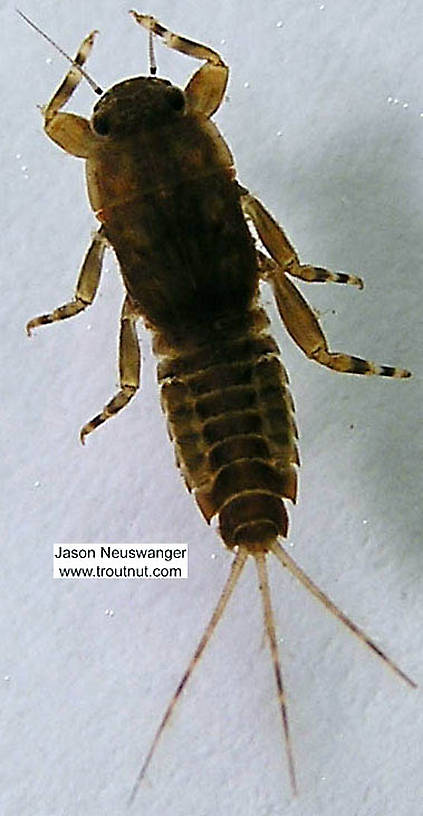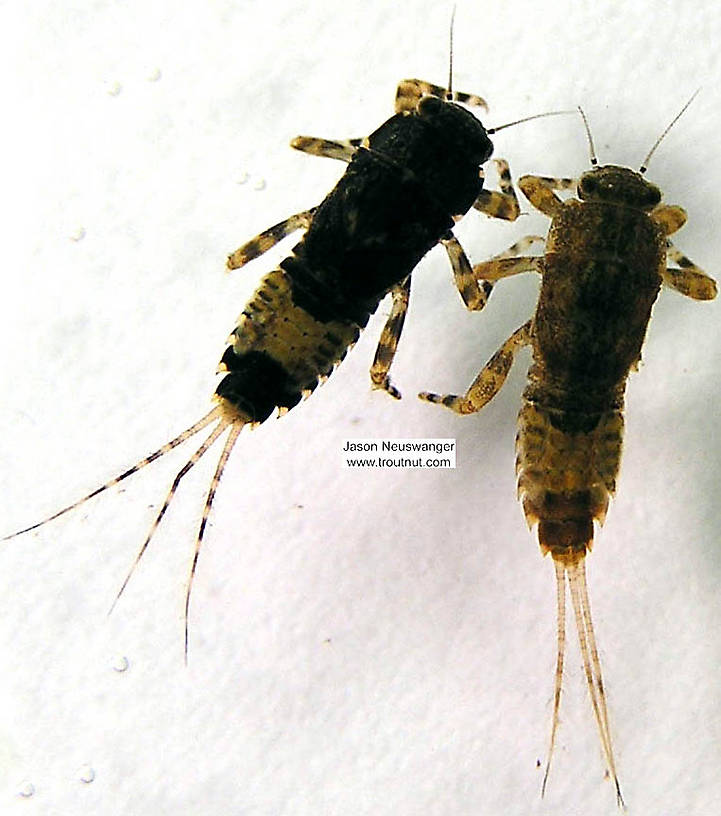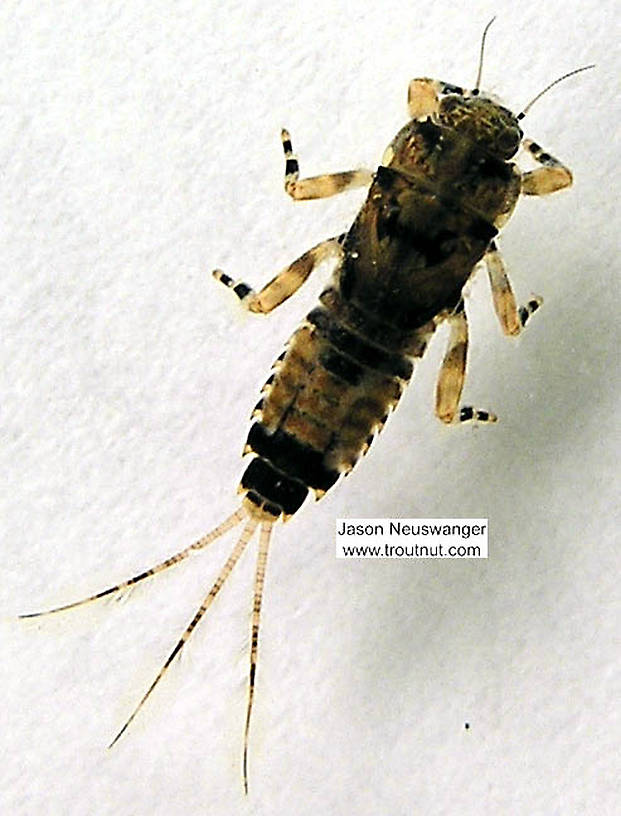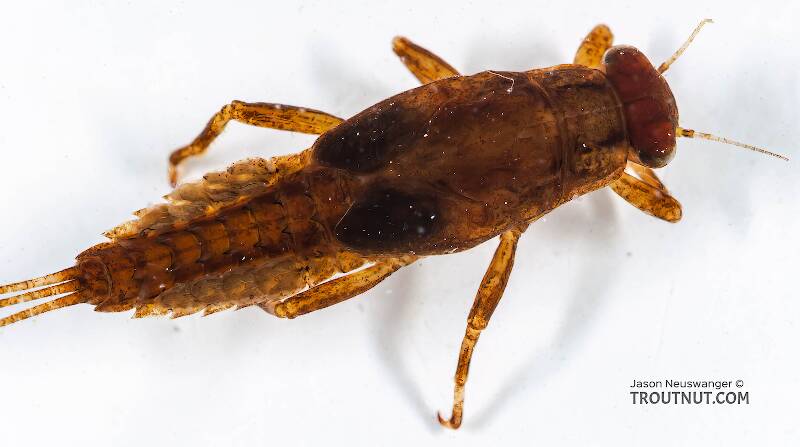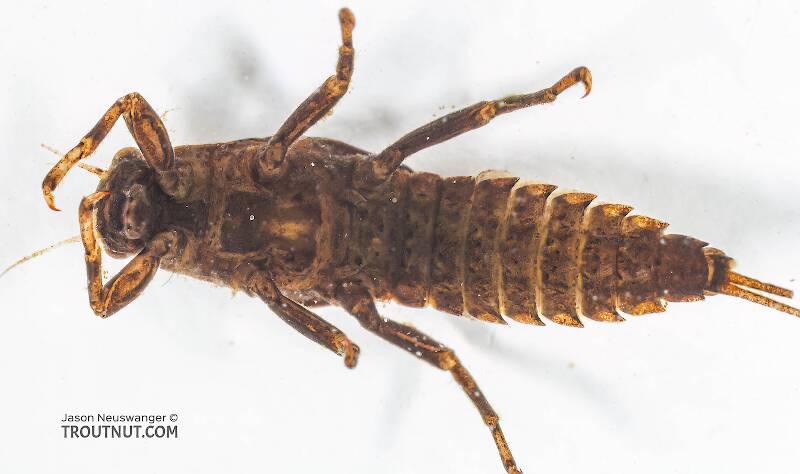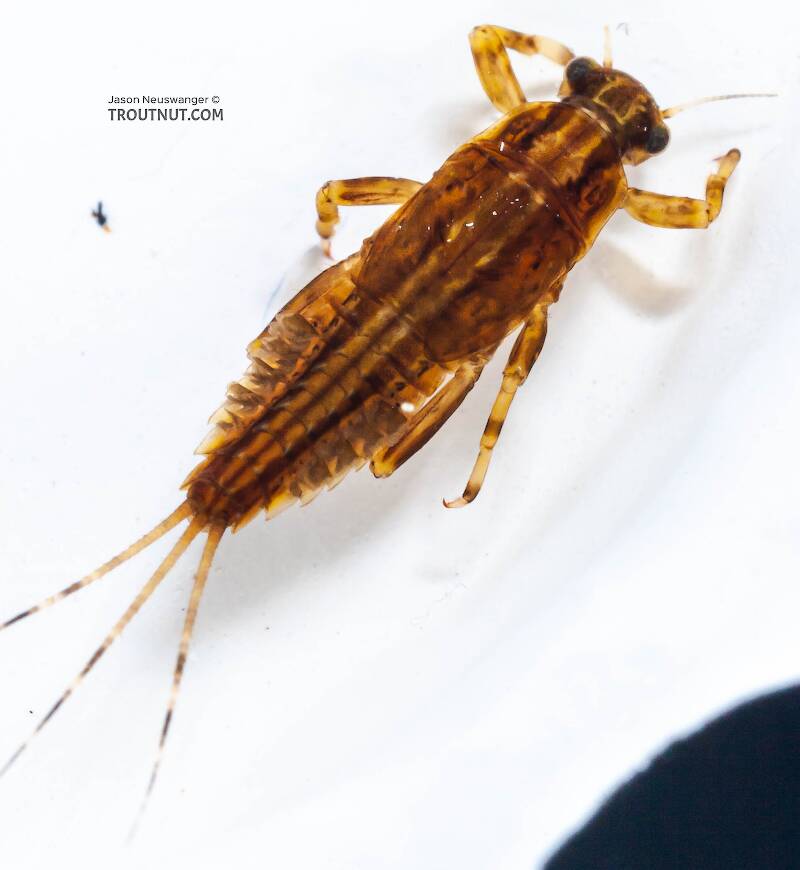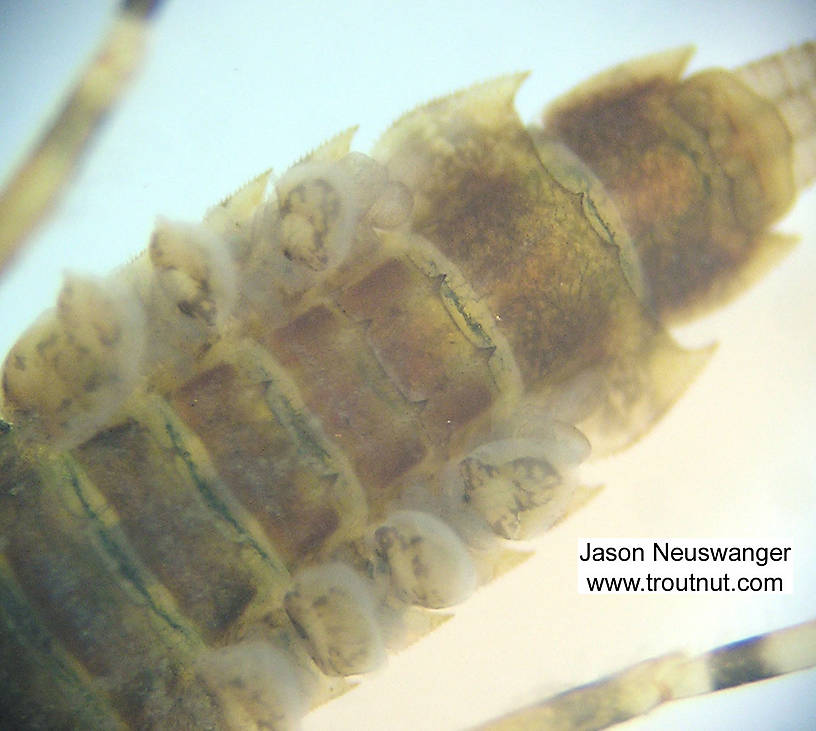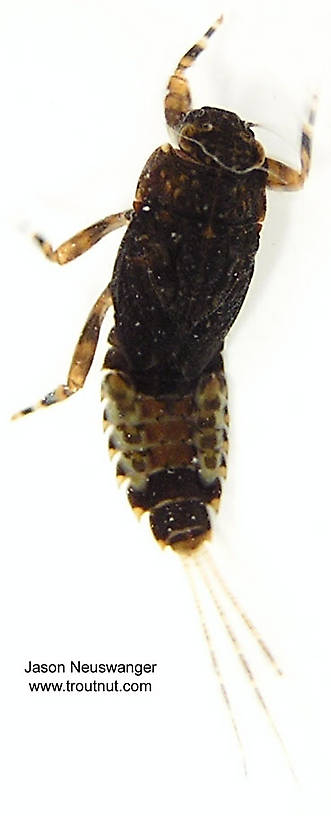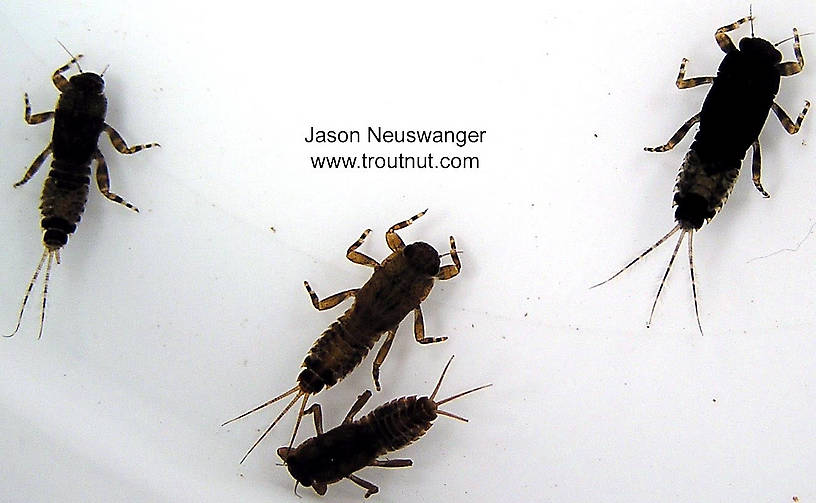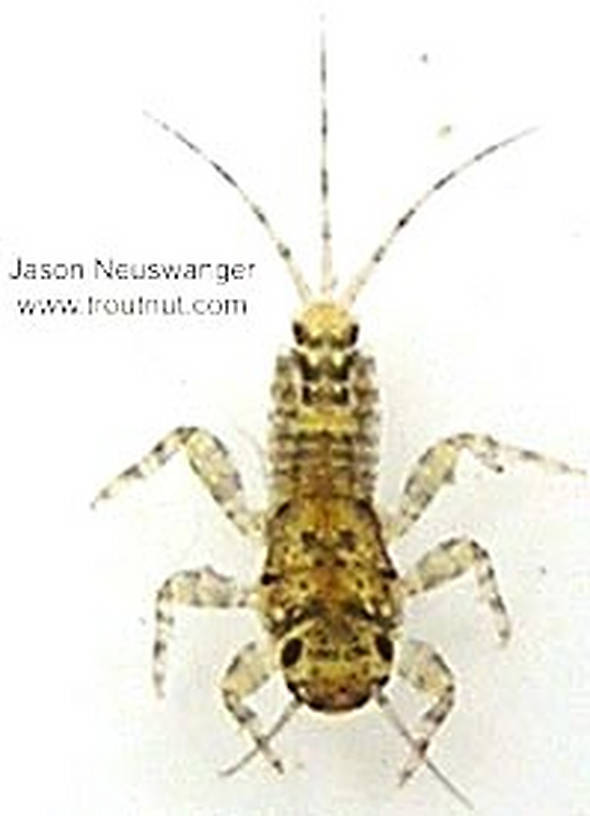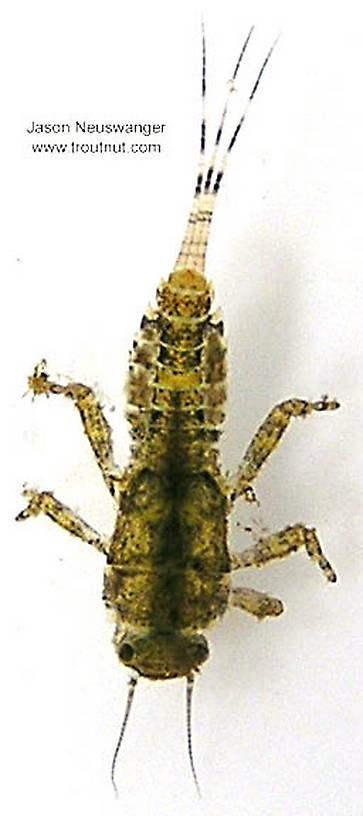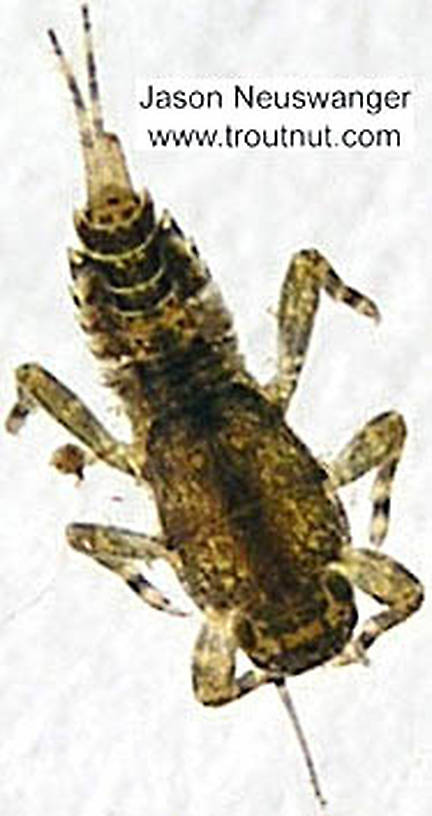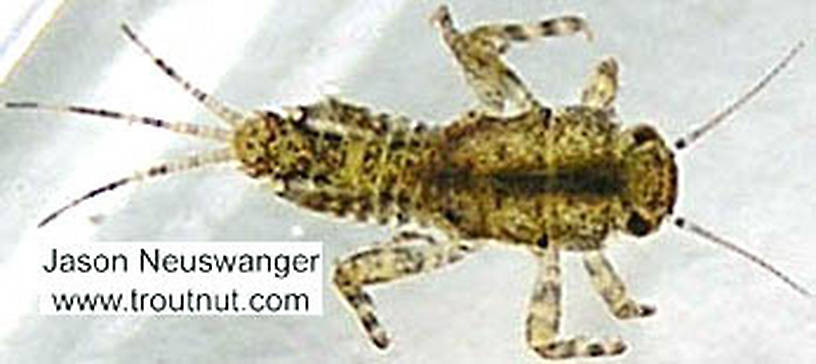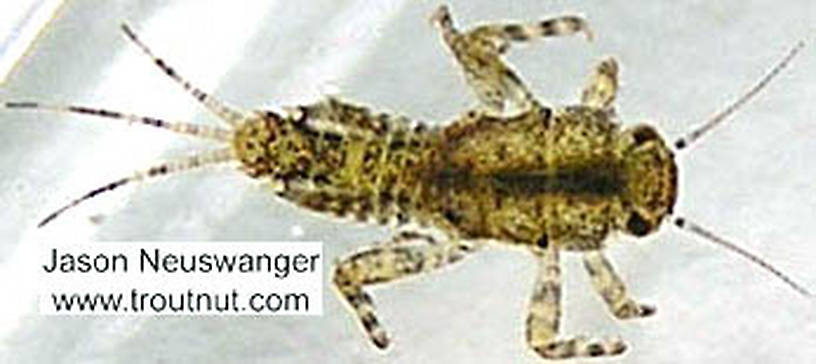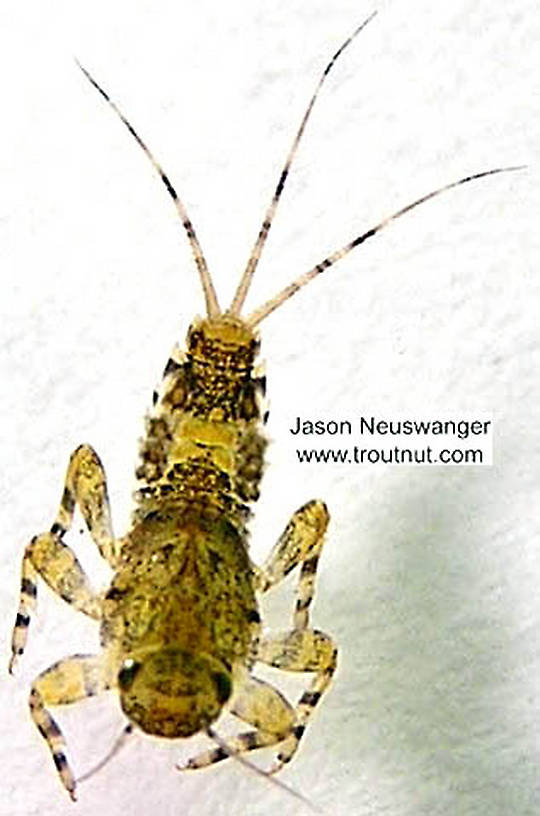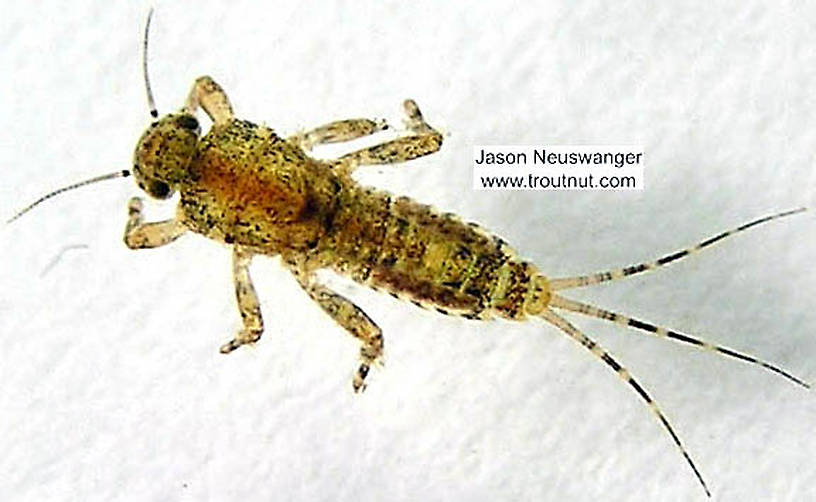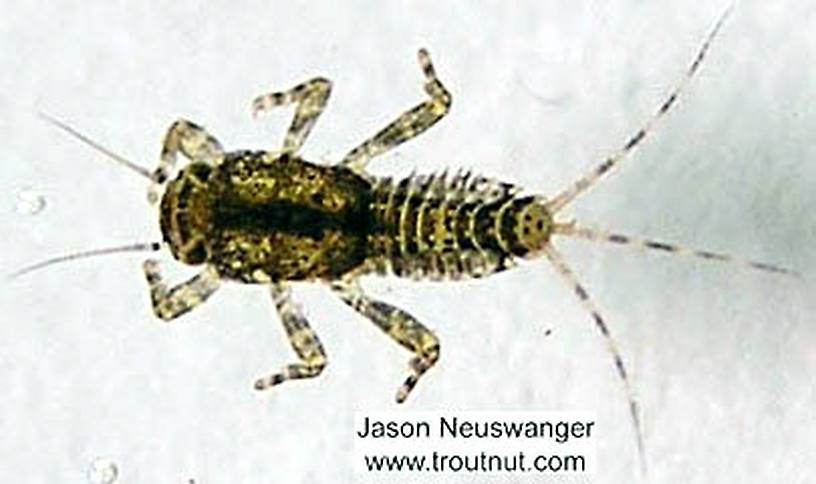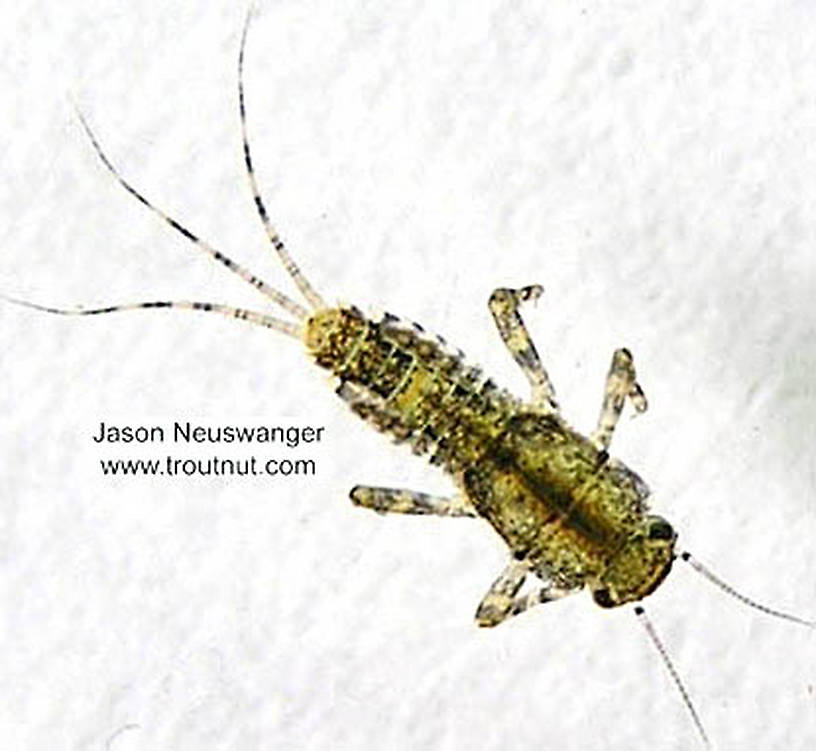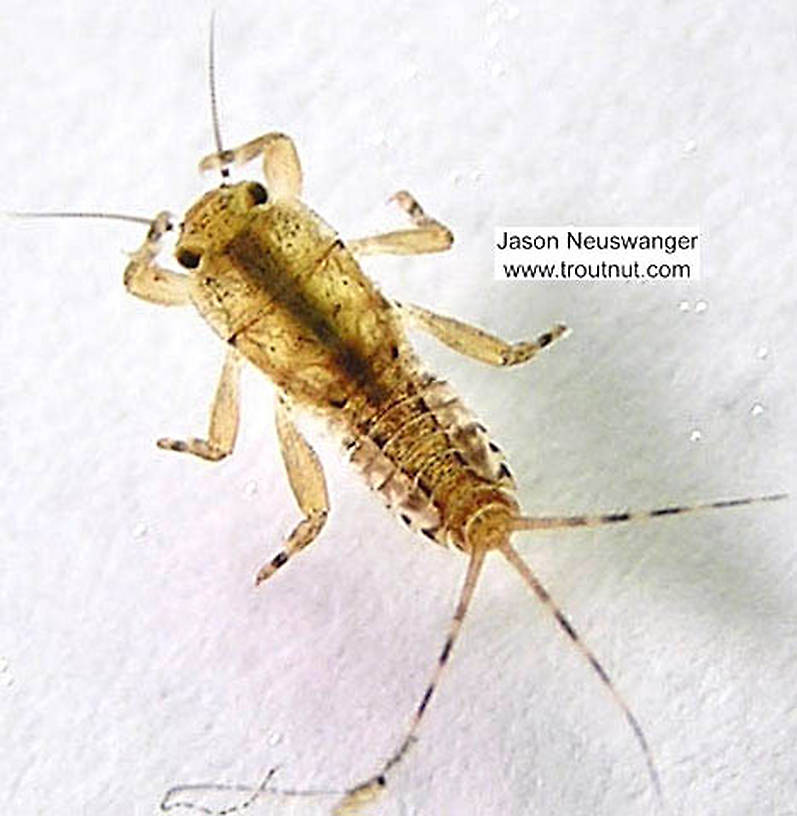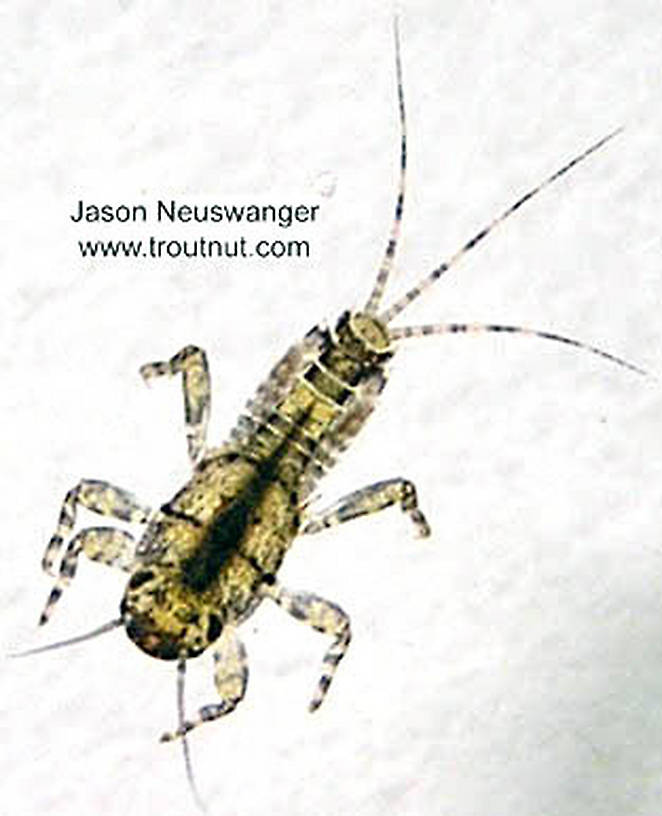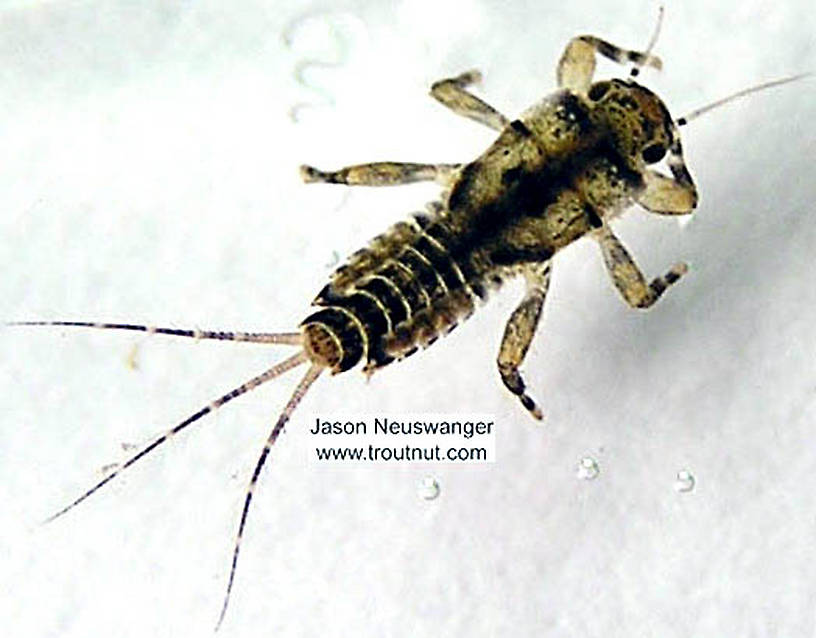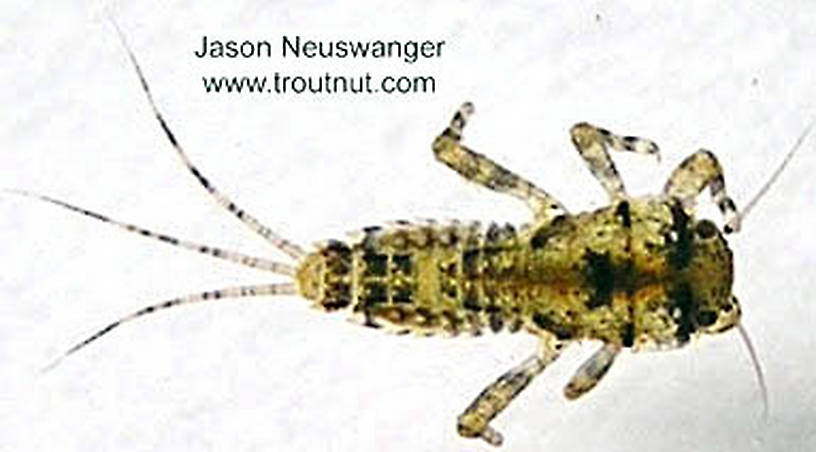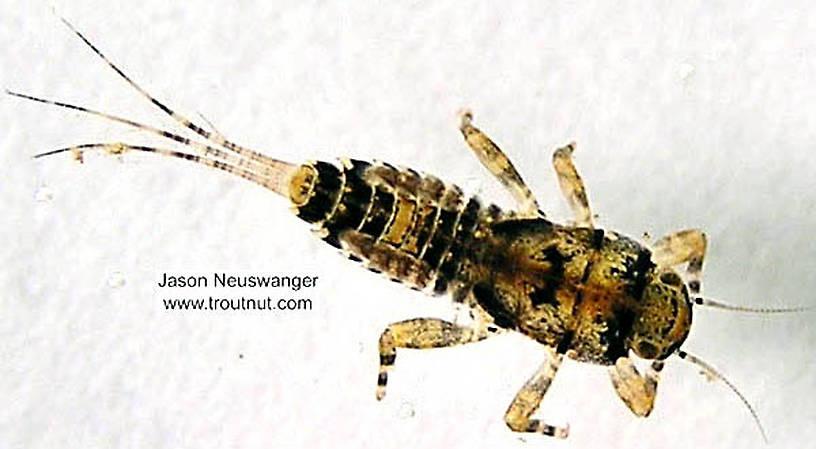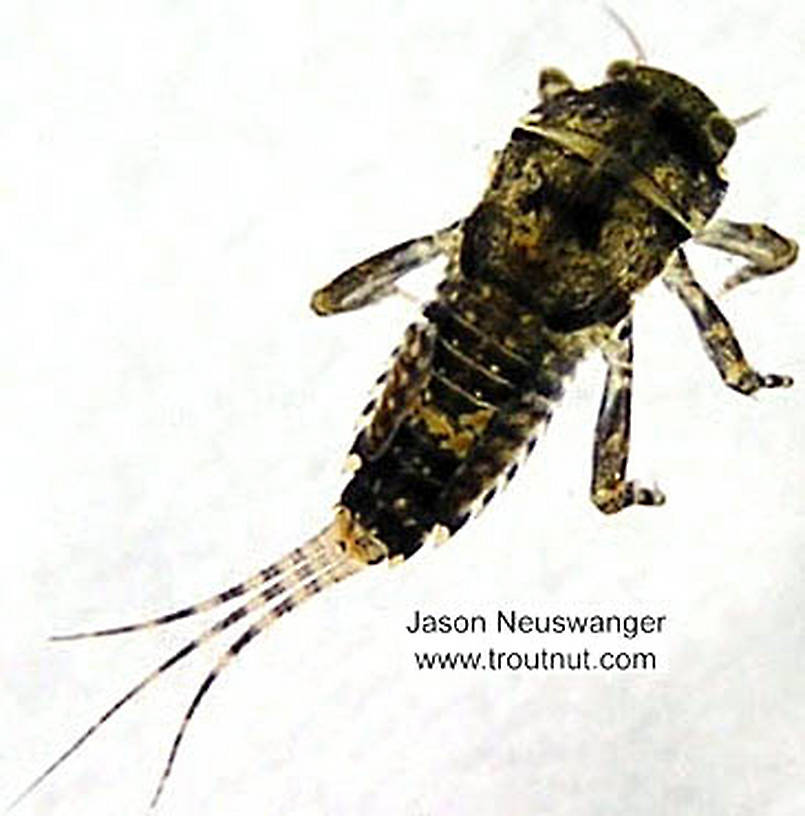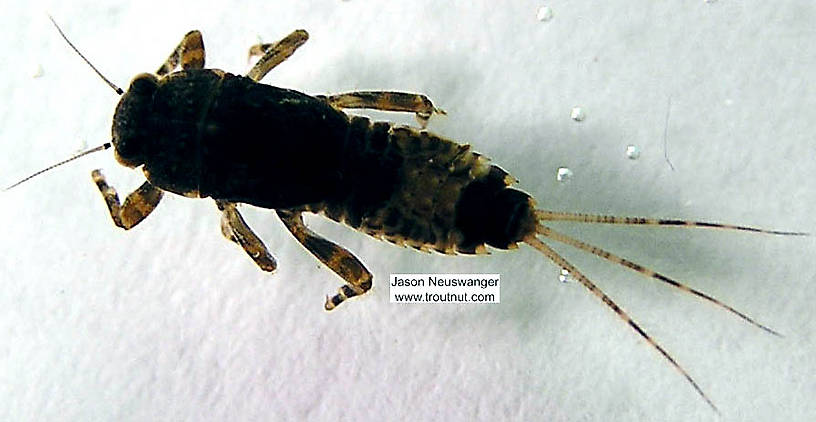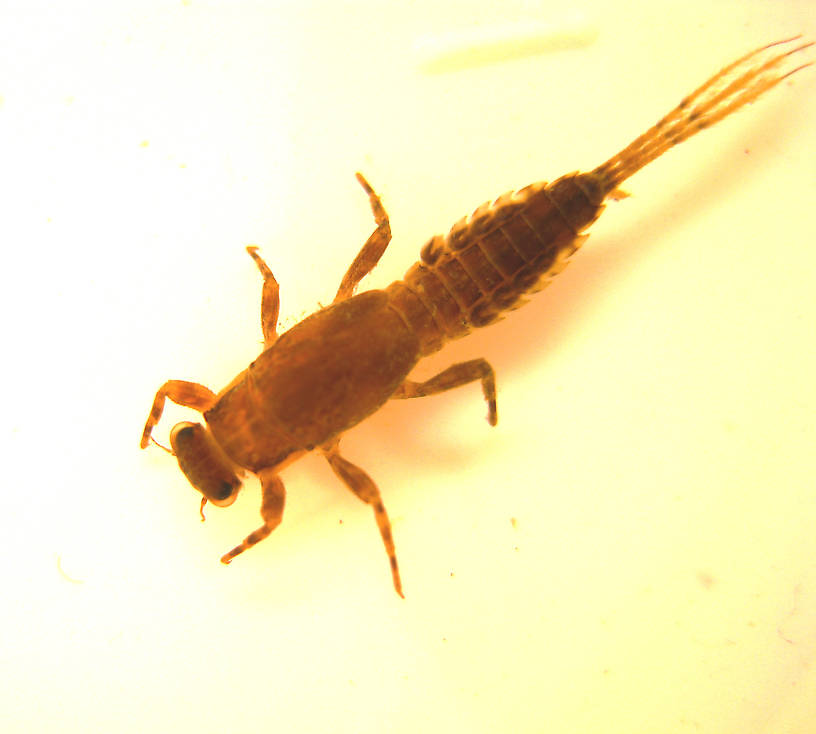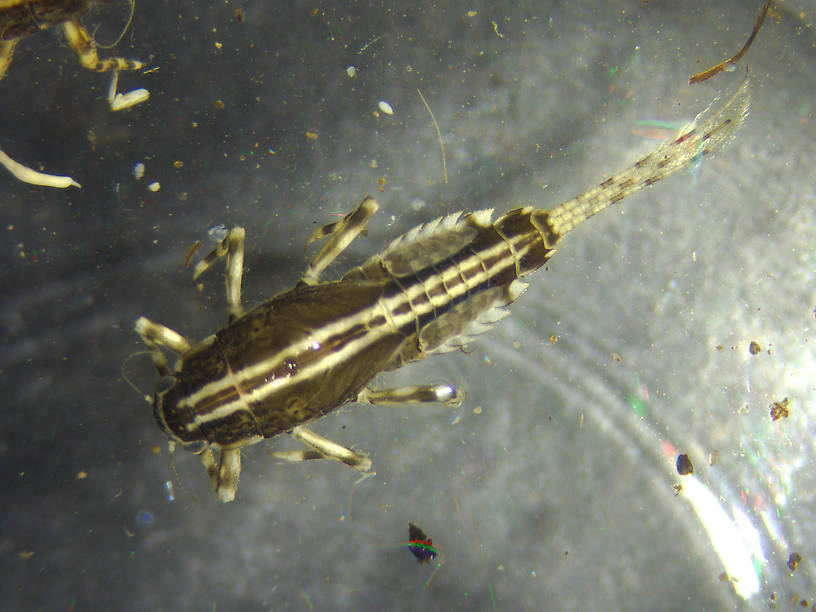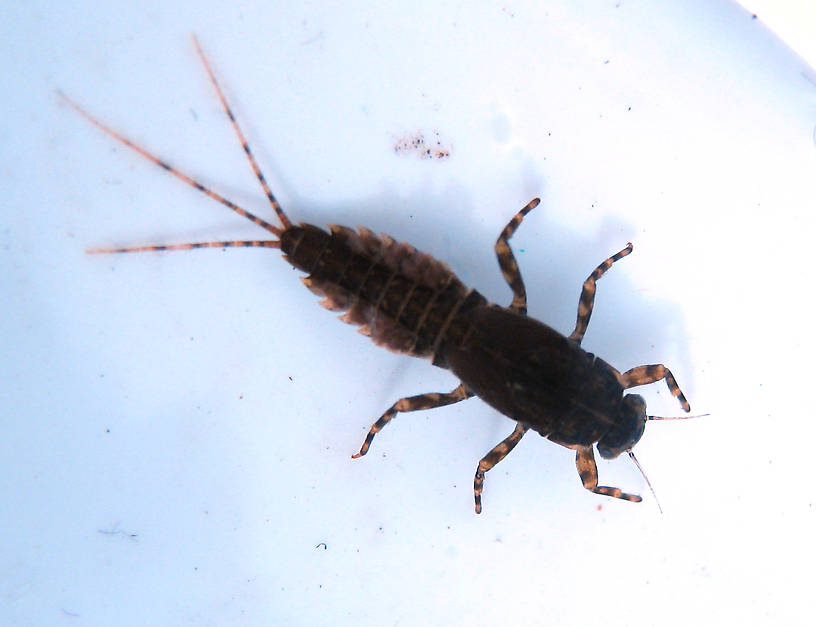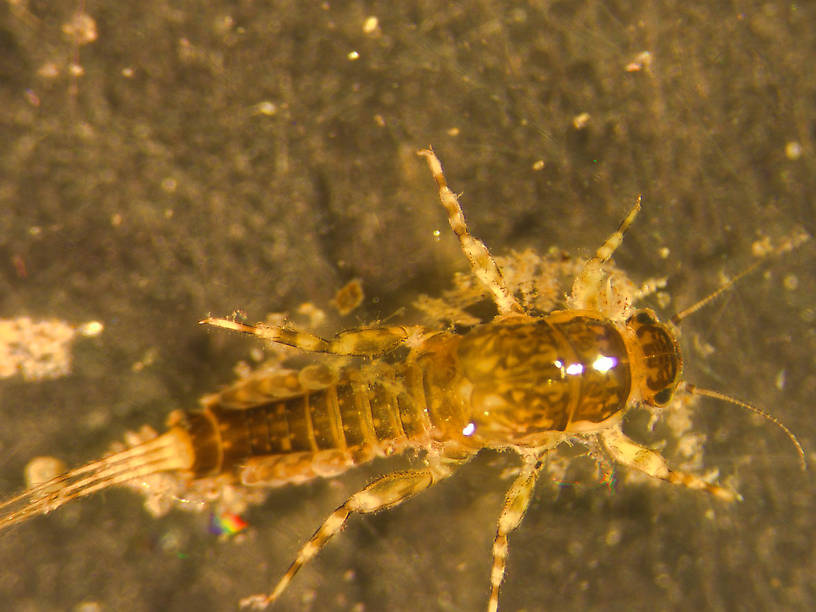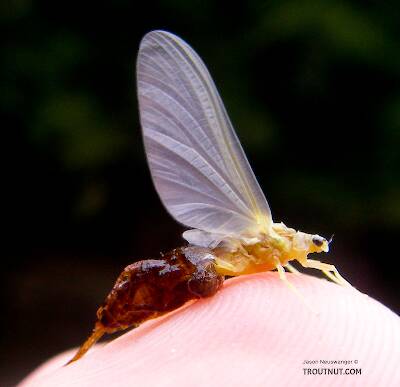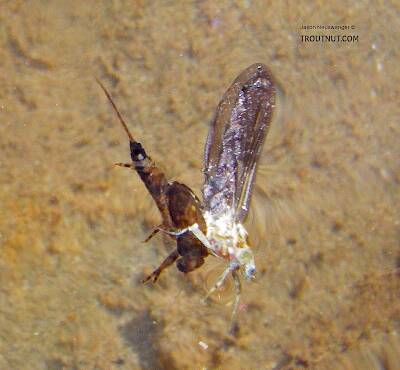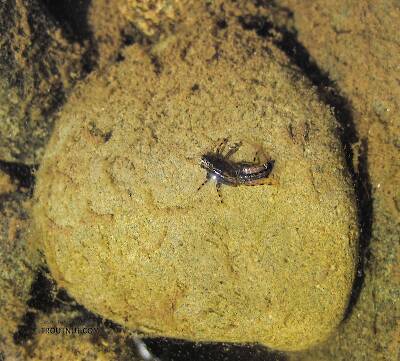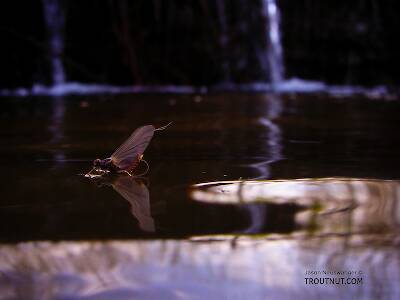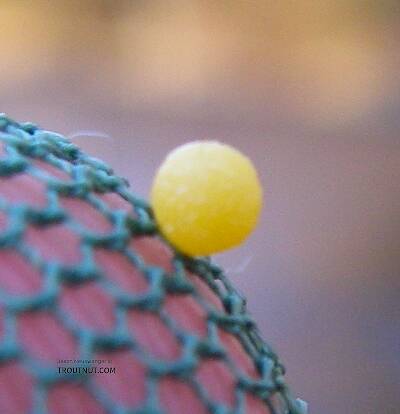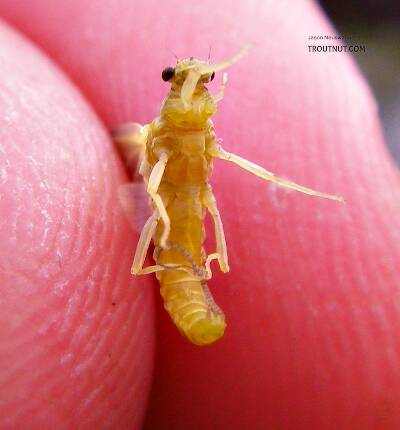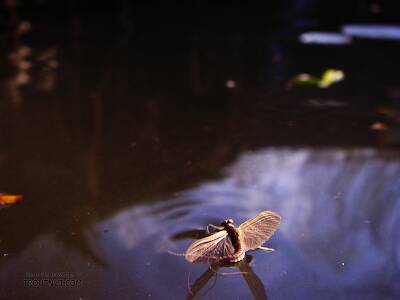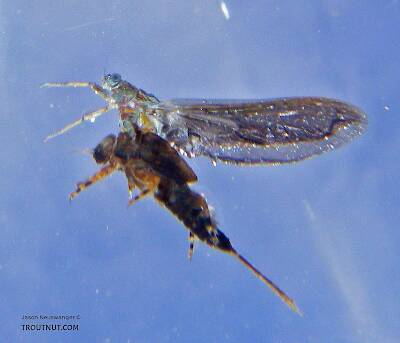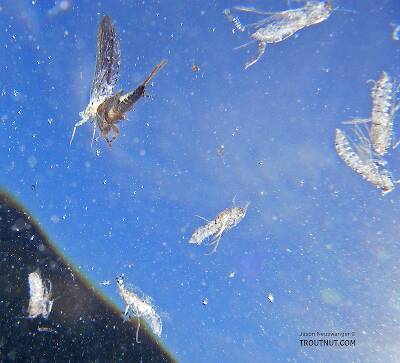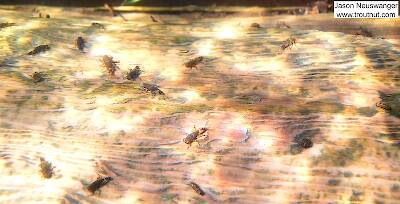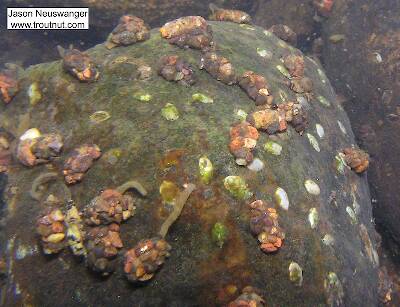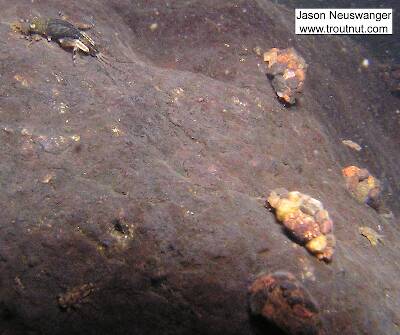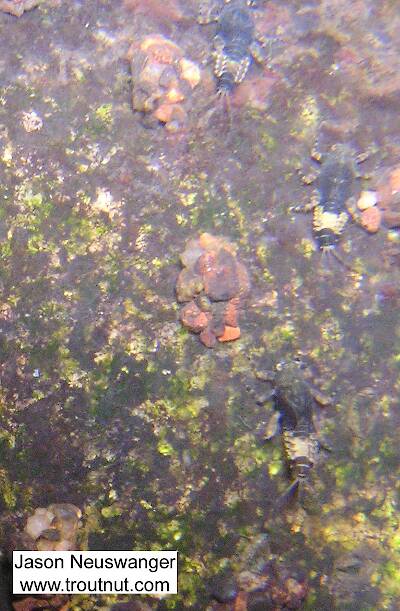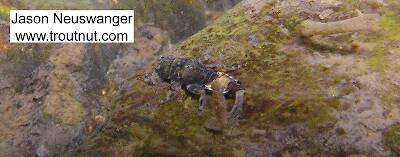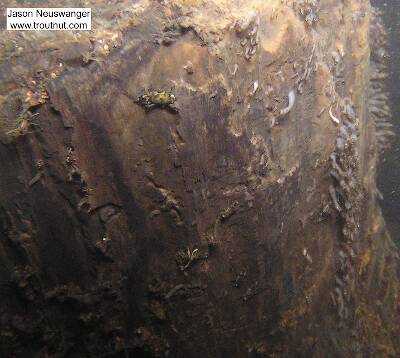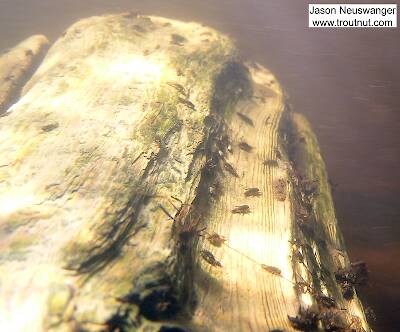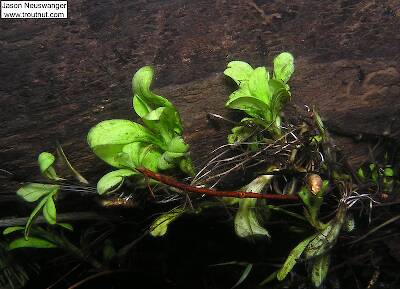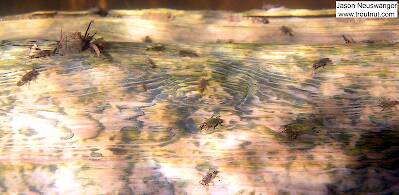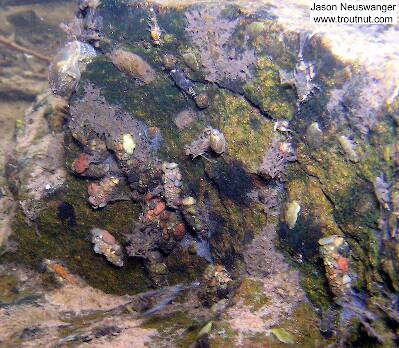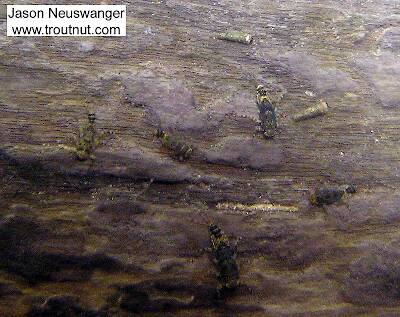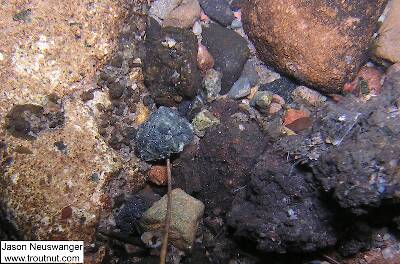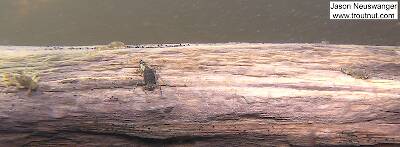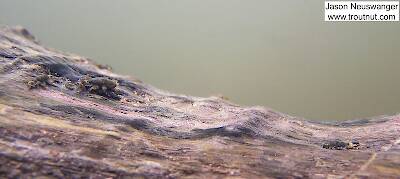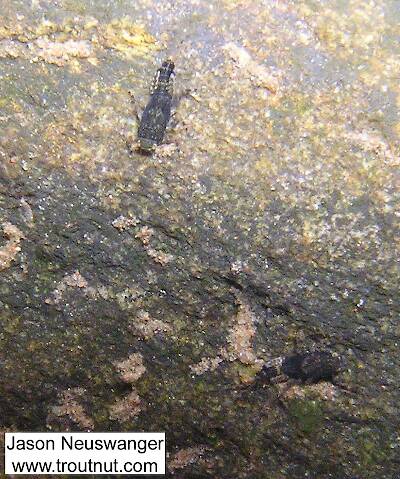
Salmonflies
Pteronarcys californica
The giant Salmonflies of the Western mountains are legendary for their proclivity to elicit consistent dry-fly action and ferocious strikes.
Featured on the forum

This one pretty clearly keys to Kogotus, but it also looks fairly different from specimens I caught in the same creek about a month later in the year. With only one species of the genus known in Washington, I'm not sure about the answer to this ID.

Troutnut is a project started in 2003 by salmonid ecologist Jason "Troutnut" Neuswanger to help anglers and
fly tyers unabashedly embrace the entomological side of the sport. Learn more about Troutnut or
support the project for an enhanced experience here.
Mayfly Genus Ephemerella (Hendricksons, Sulphurs, PMDs)
This genus contains the legendary Hendricksons and Sulphurs of the East and the equally important Pale Morning Duns of western waters.
No scientific name in American angling literature is more renowned and at the same time capable of more confusion than the genus name "Ephemerella." It is important that anglers have a good overall grasp of its taxonomic history if they are to make any sense out of the rich literary heritage involving this mayfly name.
By the time American angling literature began to take serious note of entomology in the decades of the early to mid 20th century, Ephemerella was considered a "super-genus" in the family Baetidae, containing all of the important species to anglers in the subfamily Ephemerellinae. Taxonomists organized them by association with "type" species that were referred to as "groups" within this very large and unruly genus.
This organizational structure held sway until the 70's when they were recognized as separate from the Baetidae with their own family, the Ephemerellidae. The "groups" (after a little name changing and reorganization) were given subgenus status, but in conformance with taxonomical convention,the nomenclature retained the use of the name Ephemerella when referring to individual species genus status. More change occurred towards the end of the century as consensus formed around the subgenera achieving full generic status. The broad use of Ephemerella was then dropped in favor of the new generic names.
These changes were necessary in that they addressed many problems exposed in older taxonomies. Unfortunately, all during this period the changes were reported with varying degrees of accuracy and acceptance. For anglers this was exacerbated by the continued use and reliance on older entomology texts in many circles. Be that as it may, recent or updated angler entomologies now recognize that many of the old Ephemerella species are spread out among several genera in the Ephemerellidae family. These include the various Blue-Winged Olives and Western Green Drakes of the Drunella genus as well as several important species scattered in genera like Attenella and Serratella, to name a few.
Despite these revisions in classification, the Ephemerella genus still contains arguably the most important species in North America, and remains a "super-genus" to anglers.
There is a lot of variation; refer to the genus species hatch pages for details.
No scientific name in American angling literature is more renowned and at the same time capable of more confusion than the genus name "Ephemerella." It is important that anglers have a good overall grasp of its taxonomic history if they are to make any sense out of the rich literary heritage involving this mayfly name.
By the time American angling literature began to take serious note of entomology in the decades of the early to mid 20th century, Ephemerella was considered a "super-genus" in the family Baetidae, containing all of the important species to anglers in the subfamily Ephemerellinae. Taxonomists organized them by association with "type" species that were referred to as "groups" within this very large and unruly genus.
This organizational structure held sway until the 70's when they were recognized as separate from the Baetidae with their own family, the Ephemerellidae. The "groups" (after a little name changing and reorganization) were given subgenus status, but in conformance with taxonomical convention,the nomenclature retained the use of the name Ephemerella when referring to individual species genus status. More change occurred towards the end of the century as consensus formed around the subgenera achieving full generic status. The broad use of Ephemerella was then dropped in favor of the new generic names.
These changes were necessary in that they addressed many problems exposed in older taxonomies. Unfortunately, all during this period the changes were reported with varying degrees of accuracy and acceptance. For anglers this was exacerbated by the continued use and reliance on older entomology texts in many circles. Be that as it may, recent or updated angler entomologies now recognize that many of the old Ephemerella species are spread out among several genera in the Ephemerellidae family. These include the various Blue-Winged Olives and Western Green Drakes of the Drunella genus as well as several important species scattered in genera like Attenella and Serratella, to name a few.
Despite these revisions in classification, the Ephemerella genus still contains arguably the most important species in North America, and remains a "super-genus" to anglers.
There is a lot of variation; refer to the genus species hatch pages for details.
Where & when
Ephemerella species inhabit most types of water and can be found at any time of the season depending on locale. This genus is very important in the East and Midwest, where the major species hatch in the spring and a few continue into the summer. In the West, the species comprising the Pale Morning Dun complex produce the superhatches of international fame that can be found somewhere in this vast region virtually the entire season.In 203 records from GBIF, adults of this genus have mostly been collected during June (36%), May (26%), July (16%), and April (12%).
In 587 records from GBIF, this genus has been collected at elevations ranging from 7 to 11601 ft, with an average (median) of 1165 ft.
Genus Range
Hatching behavior
Variable - see speciesSpinner behavior
Time of day: Evenings in the East, mid-mornings in the West (with exceptions)
Habitat: Riffles if available, otherwise specific locations based on several considerations.
They are also one of the groups of mayflies prone to the unfortunate behavior of mating and ovipositing over blacktop roads hundreds of yards from the river.
Specimens of the Mayfly Genus Ephemerella
23 Male Duns
19 Female Duns
13 Male Spinners
13 Female Spinners
91 Nymphs
7 Streamside Pictures of Ephemerella Mayflies:
18 Underwater Pictures of Ephemerella Mayflies:
Discussions of Ephemerella
PMD Spinner - Egg sack color?
20 replies
Posted by Wbranch on Jan 26, 2010 in the species Ephemerella excrucians
Last reply on Aug 18, 2020 by Troutnut
Do any of you entomologist types know the true color of the PMD spinner? Dorothea or excrucians. Where I fish in MT there are huge spinner falls, many spents are on the water in the morning and others fall again at various periods during the day. I'd like to tie some with egg sacks as I saw many in July but forgot what color they were. Thanks.
rotunda
8 replies
Posted by CharlieBugs on Jan 25, 2015 in the species Ephemerella invaria
Last reply on Feb 1, 2015 by Gutcutter
Your post on Ephemerella subvaria brought back some memories that might be of interest to some readers.
I got my master’s degree under Ed Cooper at Penn State in 1966. I studied the impact of low oxygen from Penn State’s sewage plant on the mayflies of Spring Creek. The plant mostly removed BOD (organic matter which causes low oxygen) by oxidizing it in a bacteria rich environment. But at that time the plant did not remove phosphorus (and nitrogen) which fertilized the macrophytic algae and other plant growth. There were far more macrophytes (large plants) in Spring Creek below the sewage plant entrance than above, and essentially no mayflies. What was there in the effluent that killed the mayflies? Mayflies put directly in the effluent did not die over a 16 hour day. But oxygen samples taken over 24 hours in summer showed a much greater variation below the effluent (from 16 ppm (or mg/l), 160% of saturation in late afternoon) to 3 ppm (30 percent saturation just before dawn) (vs 14 to 10 ppm, +- 20 percent saturation above the effluent.
I built a Rube Goldberg machine in the lab that would control the oxygen levels and temperature of control and experimental cages that each held 25 mayflies. The control would keep oxygen near saturation and the experimental one would lower the oxygen over 8 hours (the length of night in summer). Mortality was dependent upon both oxygen level and temperature. Virtually no mayflies would die if the oxygen was above 2 PPM (or mg/l) at 8 C, or at 4.5 at 20 C. Seventy five percent of larvae would die at 1 ppm at 8 degrees and 2.5 ppm at 20 degrees. So the mortality was much more if the temperatures were high. Hence most of the mortality would presumably occur in August when the high temperatures (20C) would increase the larvae metabolism and hence need for oxygen, but the water would hold less oxygen even before the night-time respiration of the macrophytes would reduce it much further (to only 3 ppm). Thus the low nighttime oxygen caused by excessive plant growth was a sufficient cause or the near total absence of mayflies below the sewage plant. Recognizing the aquatic impact Penn State started to use land disposal of its effluent which as far as I knew alleviated, and even stopped, the negative impacts on the mayflies. Can anyone verify this ? The otherwise well done “The Fishery of Spring Creek; A Watershed Under Siege “
By Robert F. Carline, Rebecca L. Dunlap Jason E. Detar, Bruce A. Hollender Has nothing on dissolved oxygen or aquatic insects. In my opinion we need much more of an ecosystems approach for streams (Which we are doing for Little Sandy Creek in N.Y.).
Now back to Ephemeralla subvaria. The title of the paper I published on this project (my first of nearly 300 publications) was:
1. Hall, C.A.S. 1969. Mortality of the mayfly nymph, Ephemerella rotunda, at low dissolved oxygen concentrations. J. Elisha Mitchell Sci. Soc. 85(1): 34-39 (M.S. Thesis, Pennsylvania State University, 1966).
Whoa! Ephemeralla rotunda? This was by far the most abundant mayfly in Spring Creek where I sampled! But I could not even find the name in your list. Also I had my samples verified by Burke, author of the authoritative "Mayflies of Illinois", and he said Well that’s what it keyed out to in my book”. (Talk about scientific ass covering! ) Well to make matters worse (as of 24 hours ago) my next girlfriend, Molly, at the University of North Carolina, loved the name of “Ephemerella rotunda”, the rotund one, which comes to think of it described her as well. I liked it too. But n’exist plus: where had the most abundant mayfly gone? Fortunately upon reading the rest of the post I found “Ephemerella invaria is one of the two species frequently known as Sulphurs (the other is Ephemerella dorothea). There used to be a third, Ephemerella rotunda, but entomologists recently discovered that invaria and rotunda are a single species with an incredible range of individual variation." Ahh neither rotunda nor Molly stood the test of time. So I assume what I called rotunda is still alive and well in Spring Creek as invaria. Again, can anyone verify that?
If anyone wants to follow up on the distribution and abundance of mayfly (or any other species) may I recommend: Hall, C.A.S., J.A. Stanford and R. Hauer. 1992. The distribution and abundance of organisms as a consequence of energy balances along multiple environmental gradients. Oikos 65: 377-390. I can send it if you cannot get it from google, which I think you can. (chall@esf.edu)
I got my master’s degree under Ed Cooper at Penn State in 1966. I studied the impact of low oxygen from Penn State’s sewage plant on the mayflies of Spring Creek. The plant mostly removed BOD (organic matter which causes low oxygen) by oxidizing it in a bacteria rich environment. But at that time the plant did not remove phosphorus (and nitrogen) which fertilized the macrophytic algae and other plant growth. There were far more macrophytes (large plants) in Spring Creek below the sewage plant entrance than above, and essentially no mayflies. What was there in the effluent that killed the mayflies? Mayflies put directly in the effluent did not die over a 16 hour day. But oxygen samples taken over 24 hours in summer showed a much greater variation below the effluent (from 16 ppm (or mg/l), 160% of saturation in late afternoon) to 3 ppm (30 percent saturation just before dawn) (vs 14 to 10 ppm, +- 20 percent saturation above the effluent.
I built a Rube Goldberg machine in the lab that would control the oxygen levels and temperature of control and experimental cages that each held 25 mayflies. The control would keep oxygen near saturation and the experimental one would lower the oxygen over 8 hours (the length of night in summer). Mortality was dependent upon both oxygen level and temperature. Virtually no mayflies would die if the oxygen was above 2 PPM (or mg/l) at 8 C, or at 4.5 at 20 C. Seventy five percent of larvae would die at 1 ppm at 8 degrees and 2.5 ppm at 20 degrees. So the mortality was much more if the temperatures were high. Hence most of the mortality would presumably occur in August when the high temperatures (20C) would increase the larvae metabolism and hence need for oxygen, but the water would hold less oxygen even before the night-time respiration of the macrophytes would reduce it much further (to only 3 ppm). Thus the low nighttime oxygen caused by excessive plant growth was a sufficient cause or the near total absence of mayflies below the sewage plant. Recognizing the aquatic impact Penn State started to use land disposal of its effluent which as far as I knew alleviated, and even stopped, the negative impacts on the mayflies. Can anyone verify this ? The otherwise well done “The Fishery of Spring Creek; A Watershed Under Siege “
By Robert F. Carline, Rebecca L. Dunlap Jason E. Detar, Bruce A. Hollender Has nothing on dissolved oxygen or aquatic insects. In my opinion we need much more of an ecosystems approach for streams (Which we are doing for Little Sandy Creek in N.Y.).
Now back to Ephemeralla subvaria. The title of the paper I published on this project (my first of nearly 300 publications) was:
1. Hall, C.A.S. 1969. Mortality of the mayfly nymph, Ephemerella rotunda, at low dissolved oxygen concentrations. J. Elisha Mitchell Sci. Soc. 85(1): 34-39 (M.S. Thesis, Pennsylvania State University, 1966).
Whoa! Ephemeralla rotunda? This was by far the most abundant mayfly in Spring Creek where I sampled! But I could not even find the name in your list. Also I had my samples verified by Burke, author of the authoritative "Mayflies of Illinois", and he said Well that’s what it keyed out to in my book”. (Talk about scientific ass covering! ) Well to make matters worse (as of 24 hours ago) my next girlfriend, Molly, at the University of North Carolina, loved the name of “Ephemerella rotunda”, the rotund one, which comes to think of it described her as well. I liked it too. But n’exist plus: where had the most abundant mayfly gone? Fortunately upon reading the rest of the post I found “Ephemerella invaria is one of the two species frequently known as Sulphurs (the other is Ephemerella dorothea). There used to be a third, Ephemerella rotunda, but entomologists recently discovered that invaria and rotunda are a single species with an incredible range of individual variation." Ahh neither rotunda nor Molly stood the test of time. So I assume what I called rotunda is still alive and well in Spring Creek as invaria. Again, can anyone verify that?
If anyone wants to follow up on the distribution and abundance of mayfly (or any other species) may I recommend: Hall, C.A.S., J.A. Stanford and R. Hauer. 1992. The distribution and abundance of organisms as a consequence of energy balances along multiple environmental gradients. Oikos 65: 377-390. I can send it if you cannot get it from google, which I think you can. (chall@esf.edu)
So is Ep Infrequens now known as Ep Dorothea?
20 replies
Posted by Wbranch on Feb 17, 2008 in the species Ephemerella dorothea infrequens
Last reply on Jul 1, 2014 by Crepuscular
These mayflies look more like the Sulfurs I see on the Delaware system than the PMD's I see in Montana. The Montana mayfly has a distinct yellow leading edge to an overall light dun gray wing and the abdomen and thorax have a more light greenish/yellow cloration so how is it that Infrequens is now known as Ep Dorothea Dorothea?
Invaria - Dorothea confusion
17 replies
Posted by Entoman on Feb 1, 2012
Last reply on Feb 7, 2012 by Entoman
The following is from an older post of Gonzo's.
I've often speculated the same thing as I've seen examples of eastern invaria that look virtually identical to some of infrequens out West. Compare the specimen I posted http://www.troutnut.com/specimen/1013 to this one of Spence's http://www.troutnut.com/im_user_ident/picture_219_large.jpg Any thoughts guys?
It's been my suspicion for quite some time that a good part of the credit given to dorothea for creating the later, lighter-colored "little sulphur" hatch should probably go to the same species (or species complex) that creates the earlier, larger, darker hatch--E. invaria. Many anglers who fish the small suphurs on valley limestone streams in my home state believe (or have been led to believe) that they are fishing the dorothea hatch. Close inspection of the mayfly that causes the activity usually doesn't bear that out. Most of the true dorothea hatches seem to come from mountainous areas where the streams are faster and have rockier bottoms.
All of the specimens in this section are from PA, and this seems to provide a good case in point. This specimen and the nymph (#766) are good examples of dorothea, and they both came from sections of the Brodheads in the Poconos. The other specimens came from big limestoners and appear to be invaria. Notice that all of the dun and spinner specimens, except for this one, have banded tails (dark markings at the segments). As far as I know, this is not characteristic of the Eastern version of dorothea (E. dorothea dorothea), but it is a trait of invaria.
I've often speculated the same thing as I've seen examples of eastern invaria that look virtually identical to some of infrequens out West. Compare the specimen I posted http://www.troutnut.com/specimen/1013 to this one of Spence's http://www.troutnut.com/im_user_ident/picture_219_large.jpg Any thoughts guys?
Aw Shucks
10 replies
Posted by Martinlf on May 19, 2009 in the species Ephemerella invaria
Last reply on Jul 24, 2009 by Martinlf
OK, this is going to seem like a major duh experience for some of you, but the other night I found a sulphur spinner on the door of a bathhouse in a campground I was staying at. Looking for other bugs I then saw a pale nymph shuck on the door. I was totally confused. A nymph this far from the stream? Was this some alien bug? Looking closer I noticed that the shape was too slender for a nymph and that the wing pads were more like little protruding pockets--and it hit me. Spinner shuck. I knew that mayflies molted to produce a spinner, but I had thought the shuck would be more insubstantial--something that would be flimsy and lack form. This was so cool, and at the same time I felt so silly for thinking it could somehow have been a nymph shuck. It's the first spinner shuck I've seen, but I assume that I'll start seeing them everywhere now, like a new word you learn. Anybody else have a spinner shuck story?
Start a Discussion of Ephemerella
References
- Jacobus, L. M., Wiersema, N.A., and Webb, J.M. 2014. Identification of Far Northern and Western North American Mayfly Larvae (Insecta: Ephemeroptera), North of Mexico; Version 2. Joint Aquatic Science meeting, Portland, OR. Unpublished workshop manual. 1-176.
- Knopp, Malcolm and Robert Cormier. 1997. Mayflies: An Angler's Study of Trout Water Ephemeroptera . The Lyons Press.
- Merritt R.W., Cummins, K.W., and Berg, M.B. 2019. An Introduction to the Aquatic Insects of North America (Fifth Edition). Kendall/Hunt Publishing Company.
Mayfly Genus Ephemerella (Hendricksons, Sulphurs, PMDs)
Taxonomy
Species in Ephemerella
Ephemerella alleni
0
0
Ephemerella aurivillii
18
115
Ephemerella catawba
0
0
Ephemerella consimilis
0
0
Ephemerella dorothea dorotheaPale Evening Duns
2
12
Ephemerella dorothea infrequensPale Morning Duns
6
35
Ephemerella excruciansPale Morning Duns
24
152
Ephemerella invariaSulphurs
45
193
Ephemerella maculata
0
0
Ephemerella mucronata
1
17
Ephemerella needhamiLittle Dark Hendricksons
9
42
Ephemerella subvariaHendricksons
34
162
Ephemerella tibialisLittle Western Dark Hendricksons
6
38
Ephemerella unicornis
0
0
Species in Ephemerella: Ephemerella alleni, Ephemerella aurivillii, Ephemerella catawba, Ephemerella consimilis, Ephemerella dorothea dorothea, Ephemerella dorothea infrequens, Ephemerella excrucians, Ephemerella invaria, Ephemerella maculata, Ephemerella mucronata, Ephemerella needhami, Ephemerella subvaria, Ephemerella tibialis, Ephemerella unicornis
5 species (Ephemerella apopsis, Ephemerella hispida, Ephemerella nuda, Ephemerella velmae, and Ephemerella verruca) aren't included.

